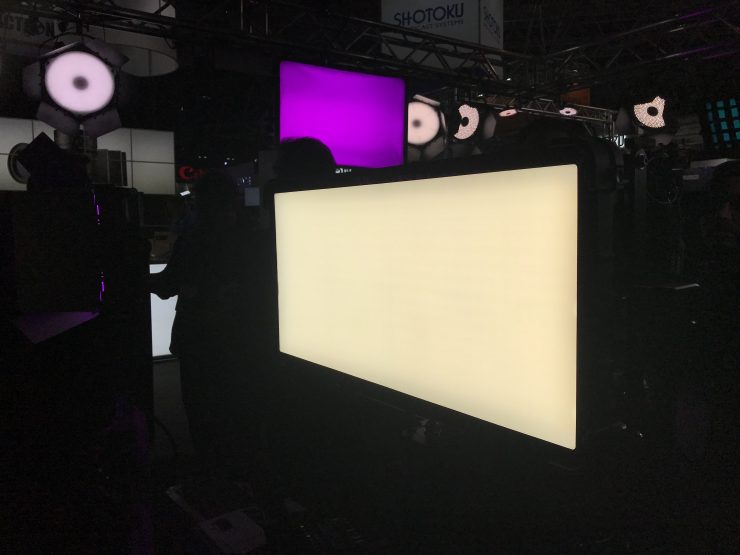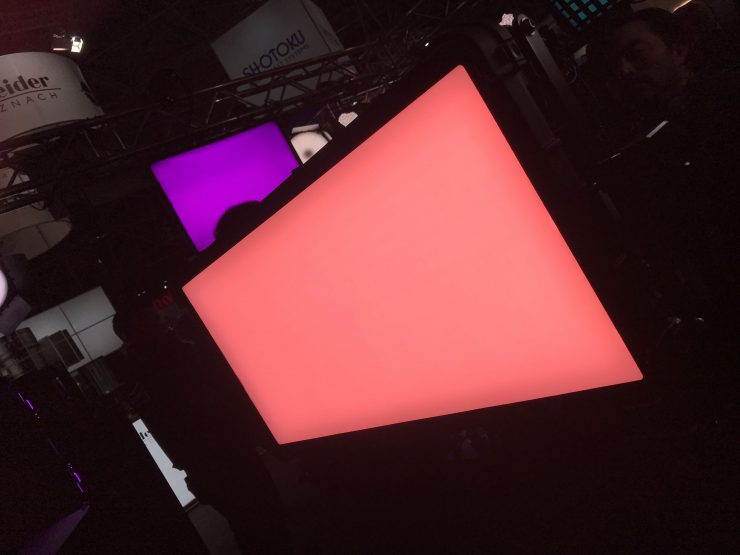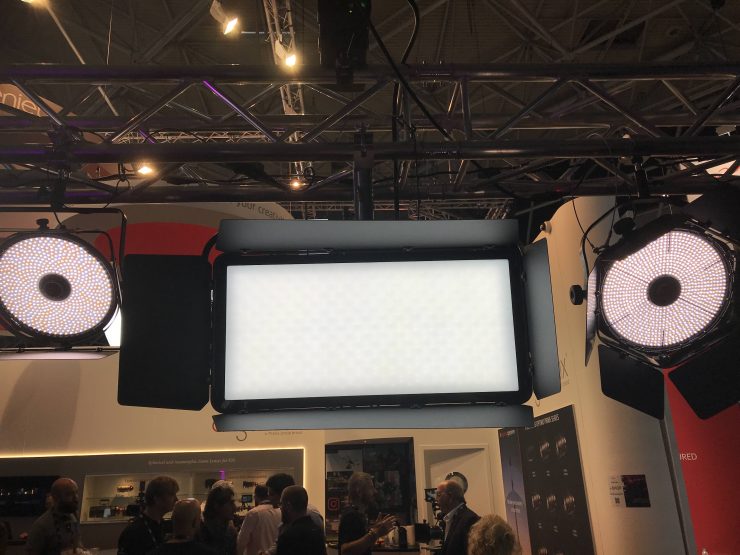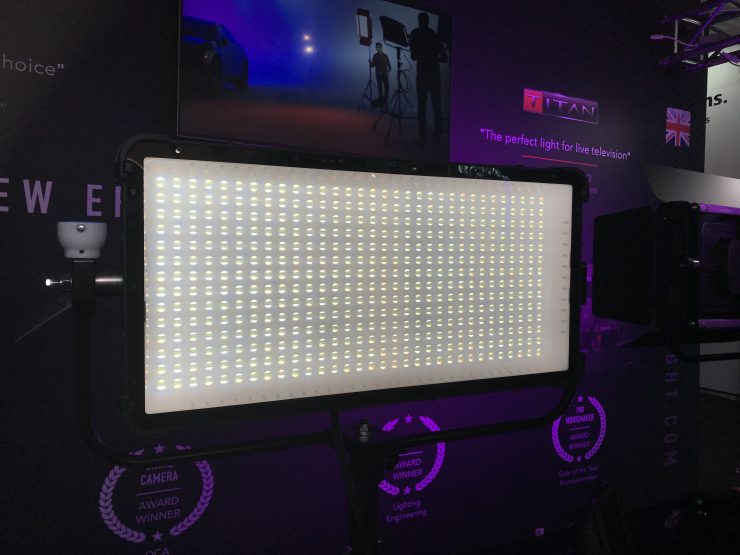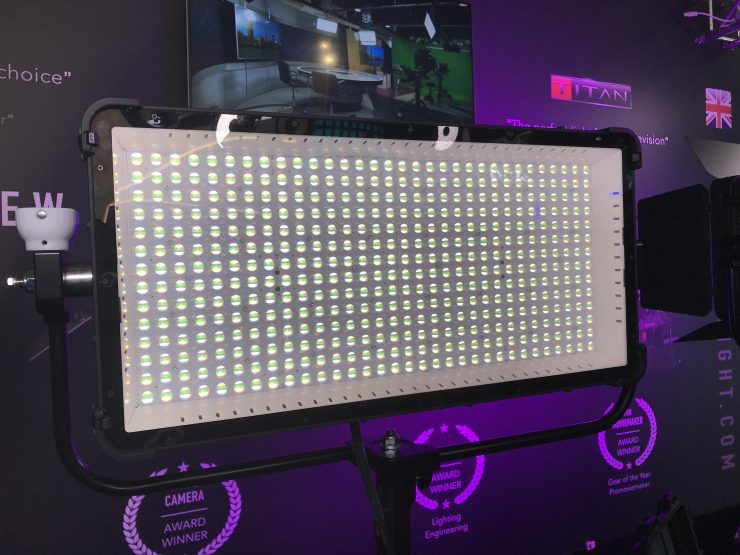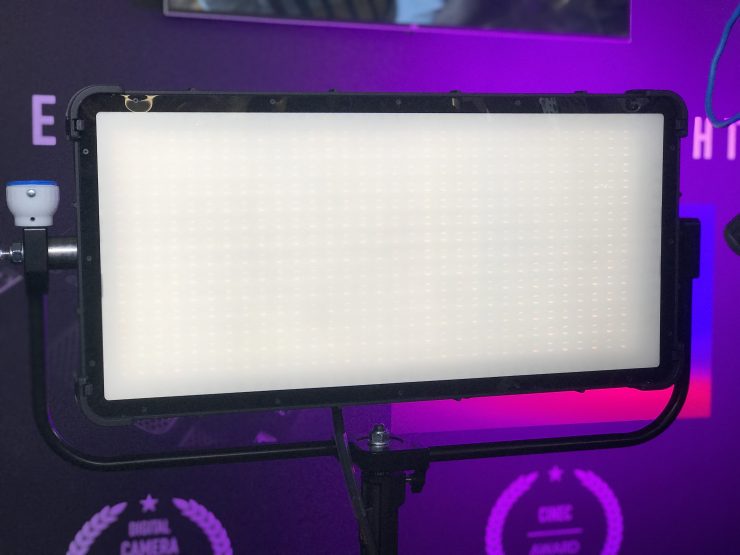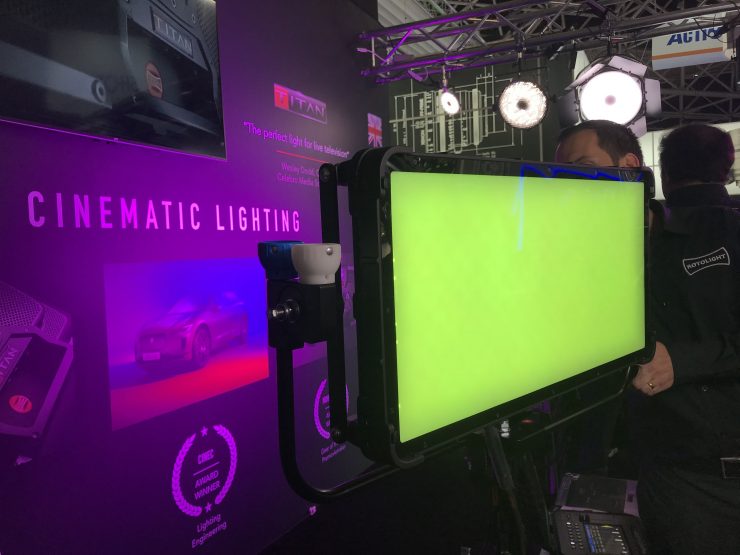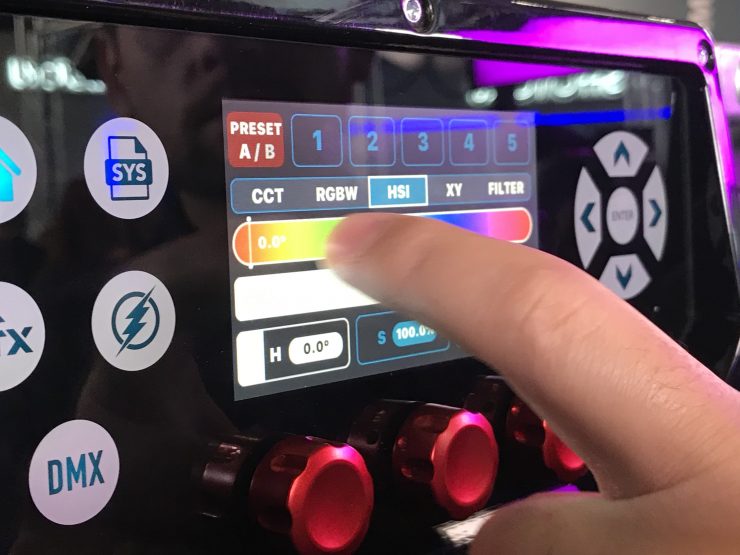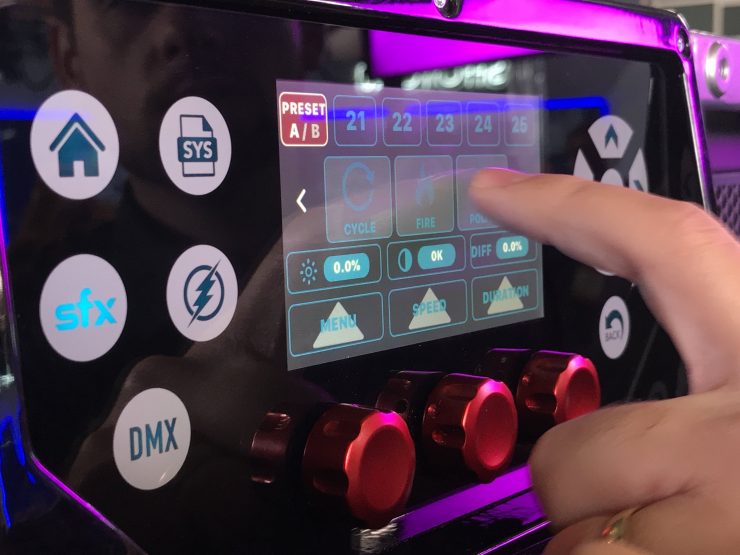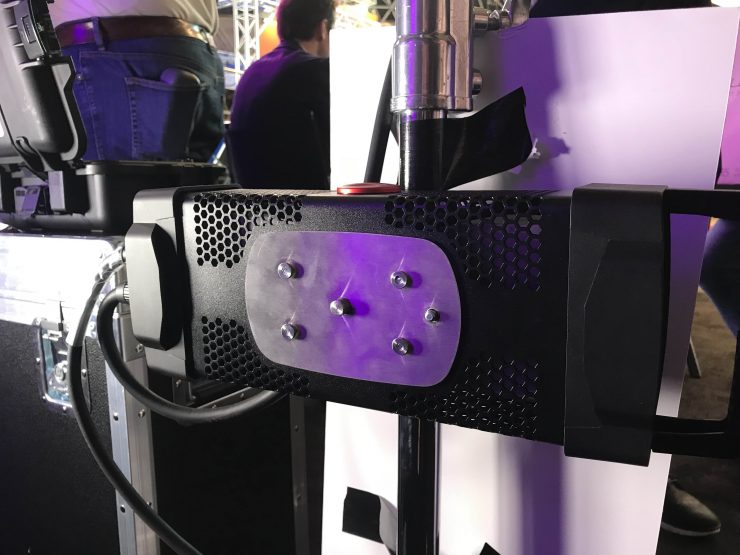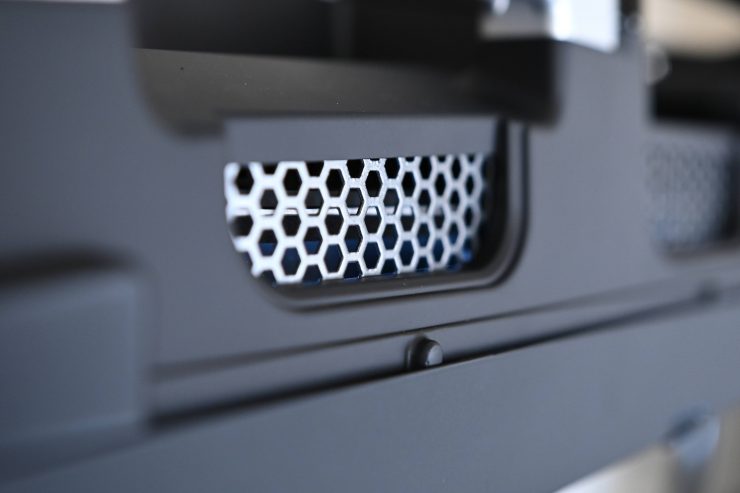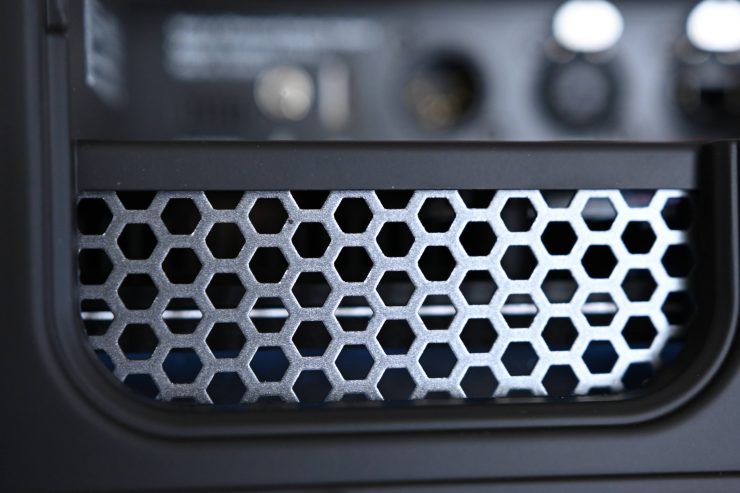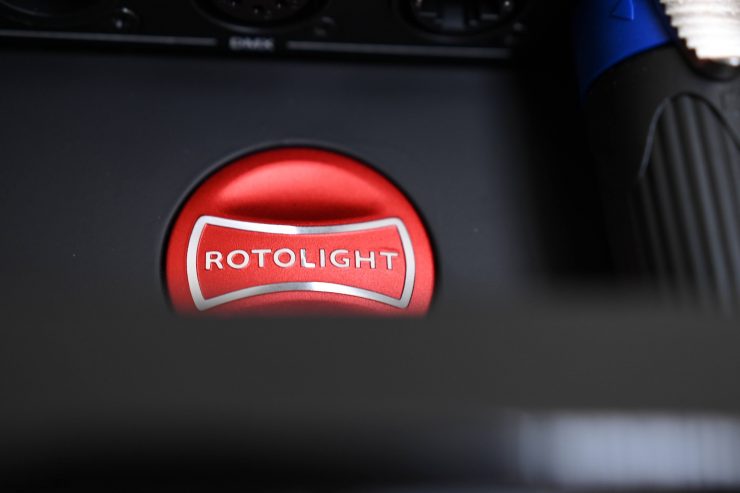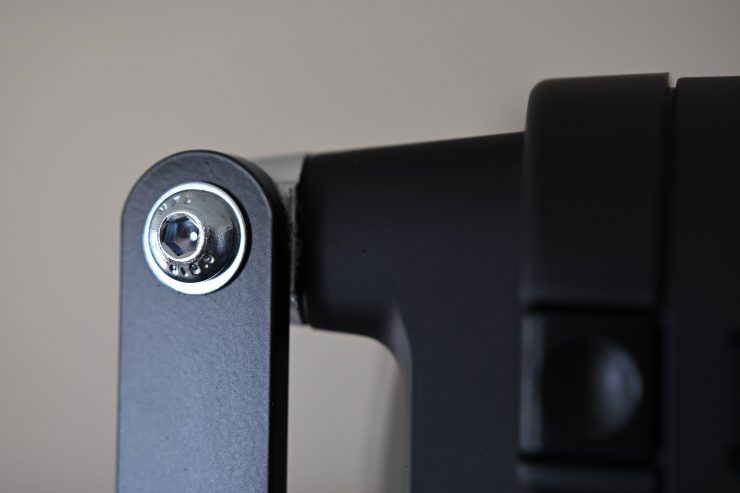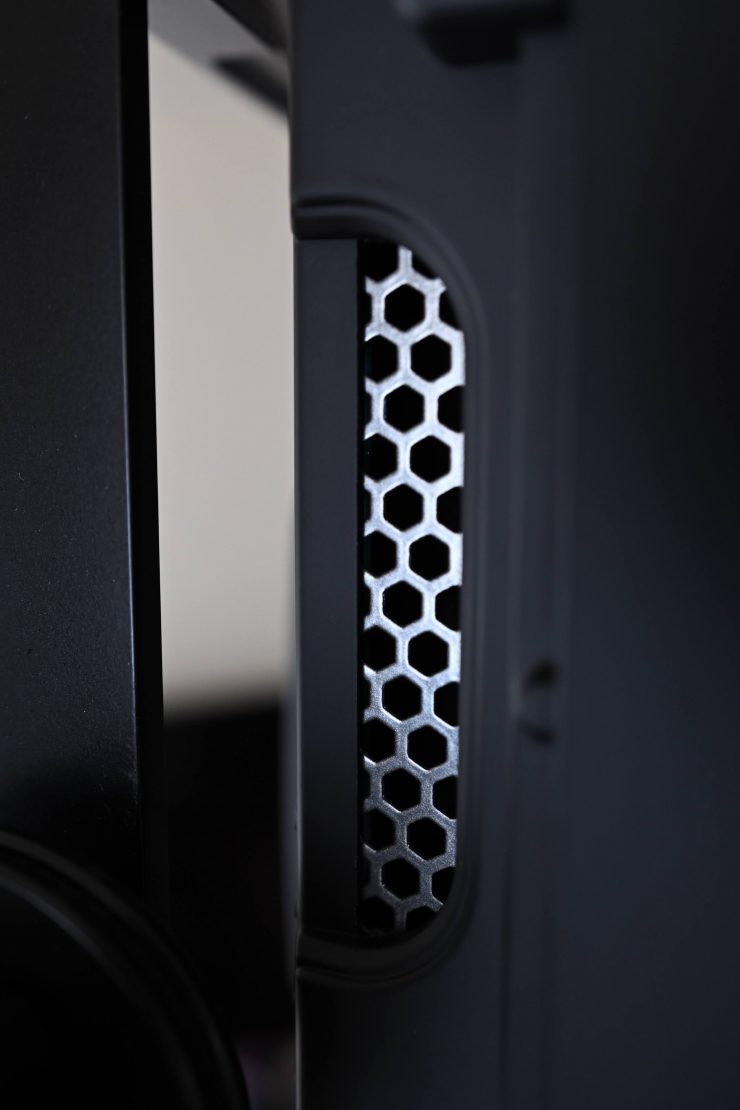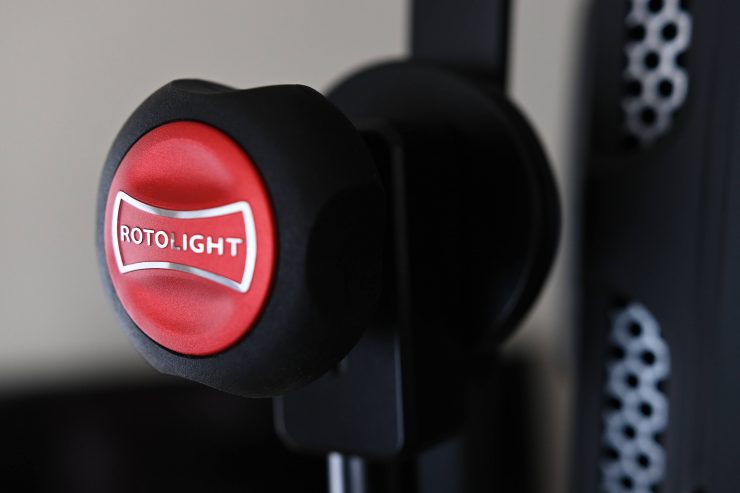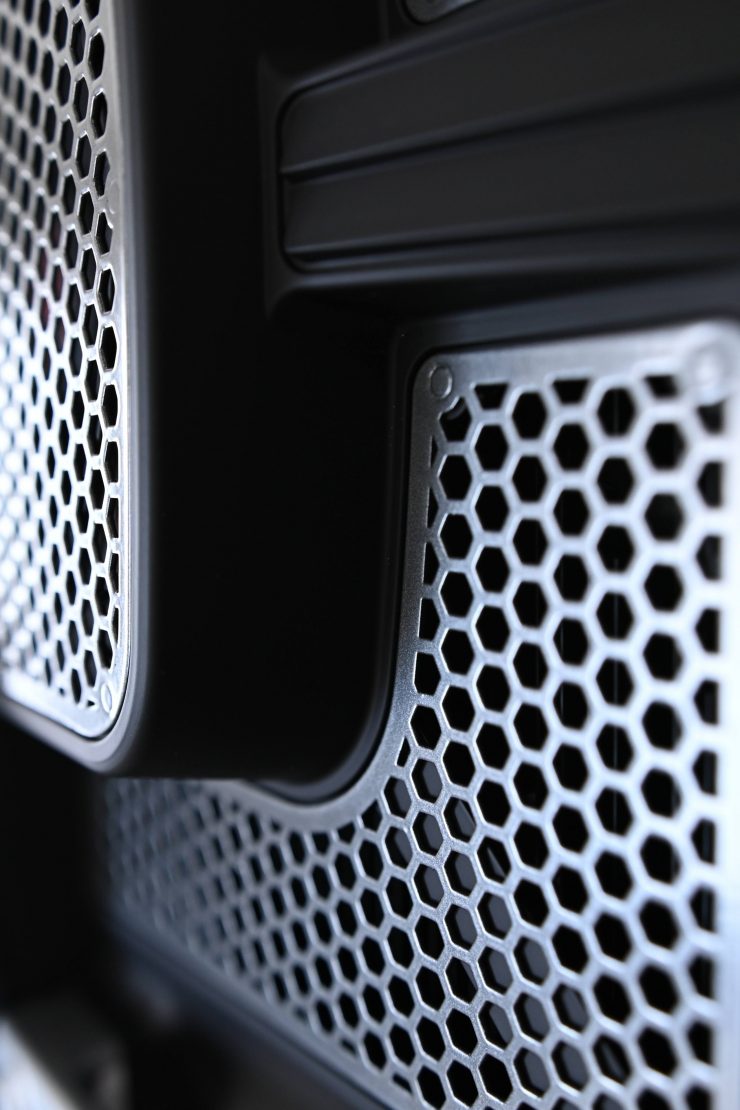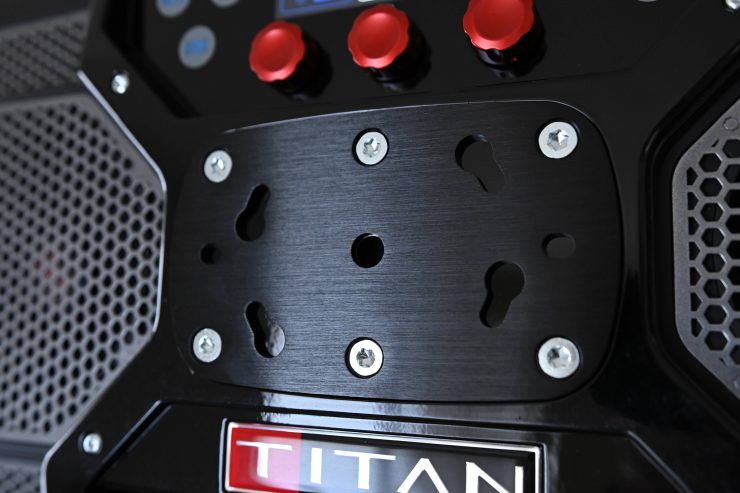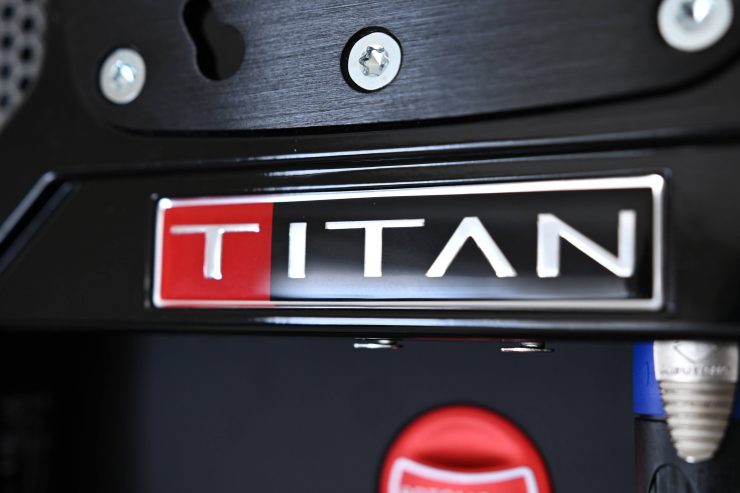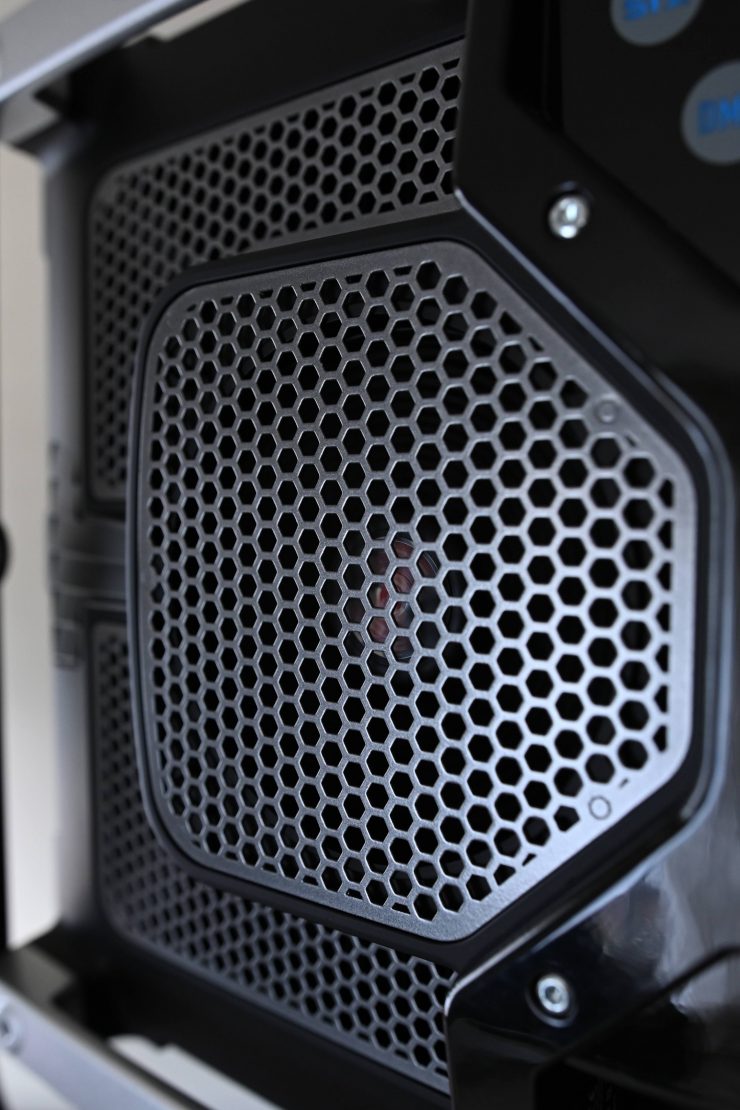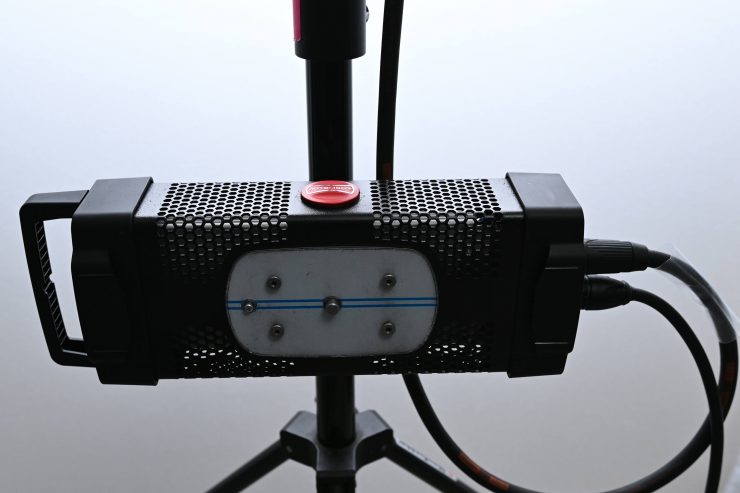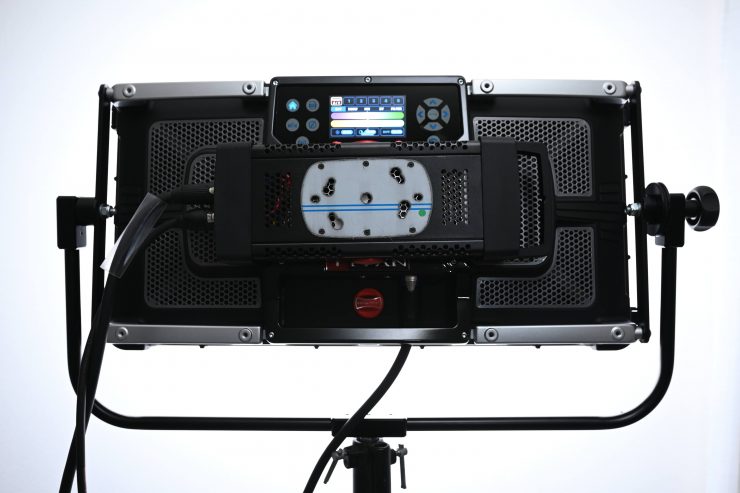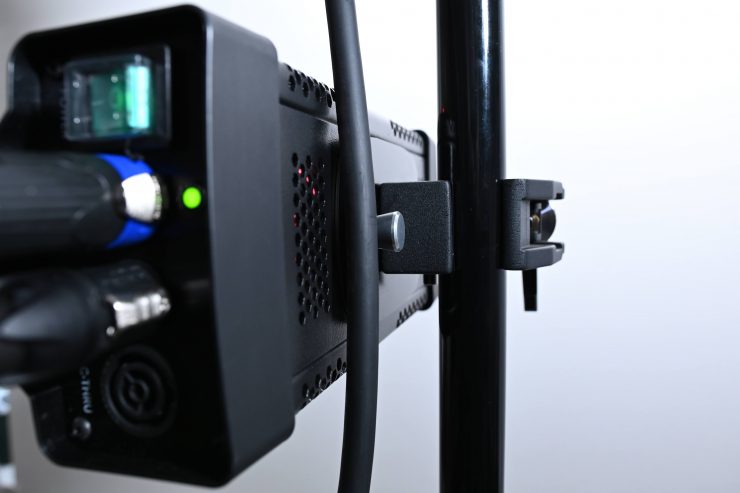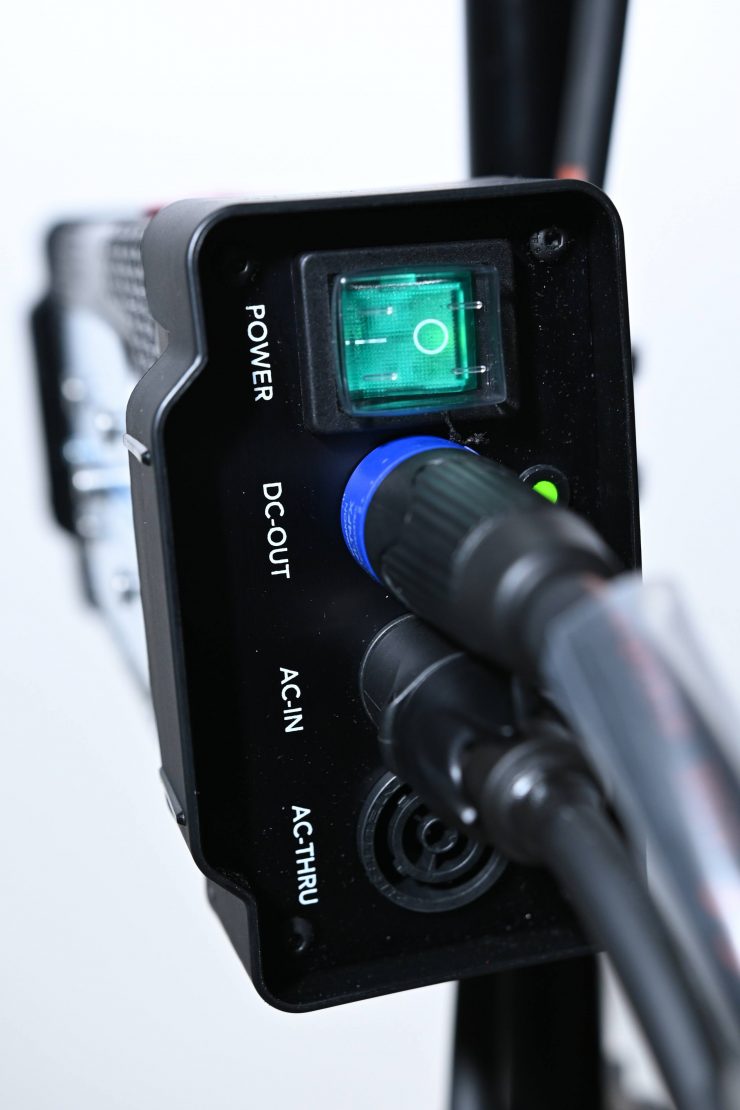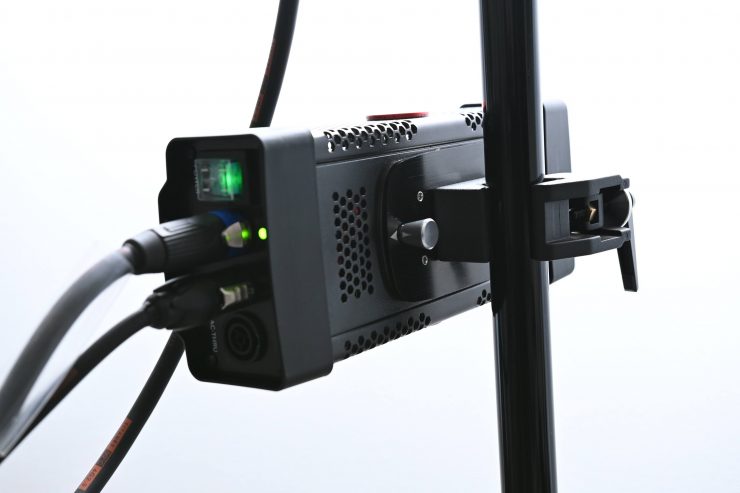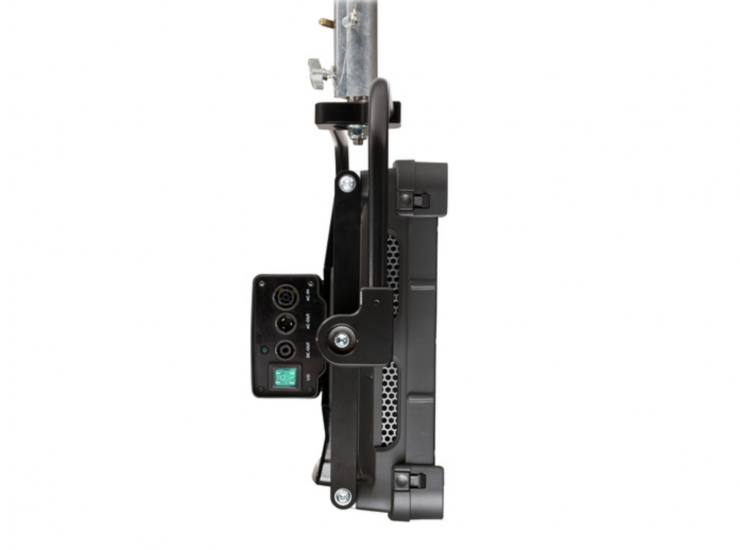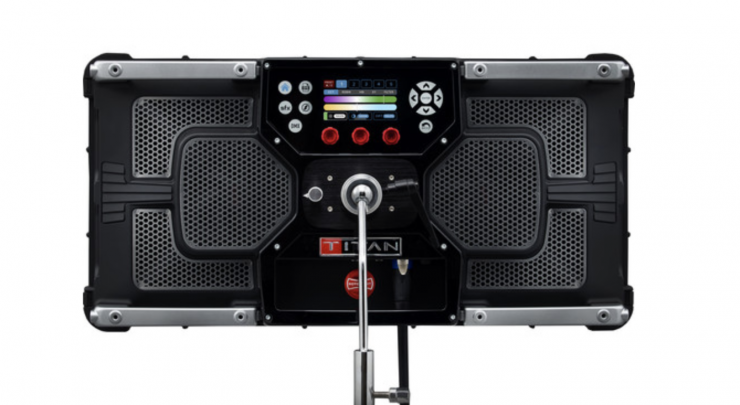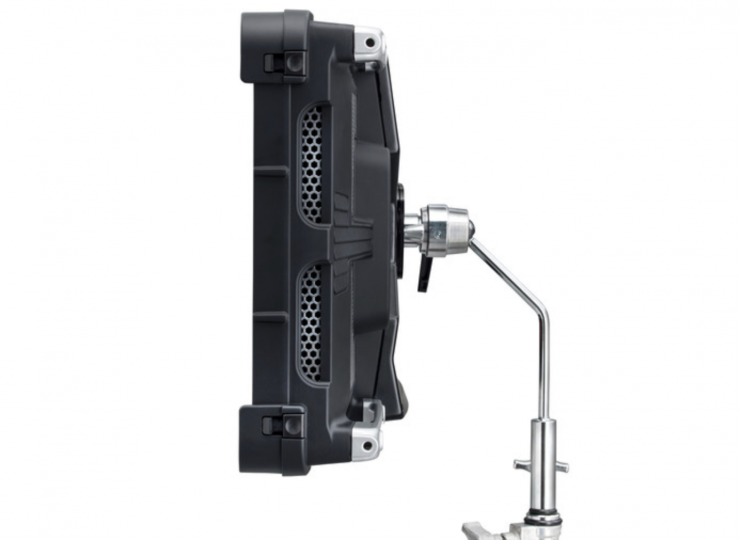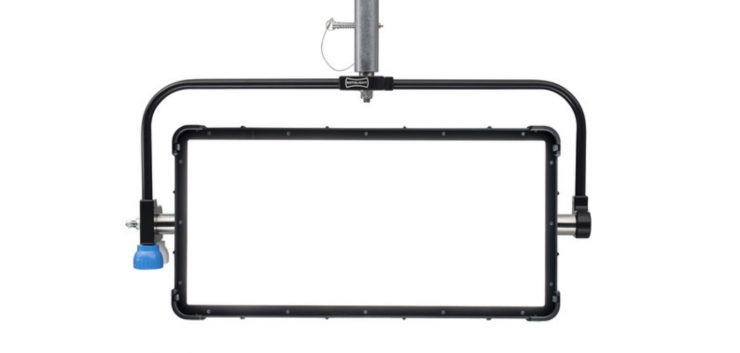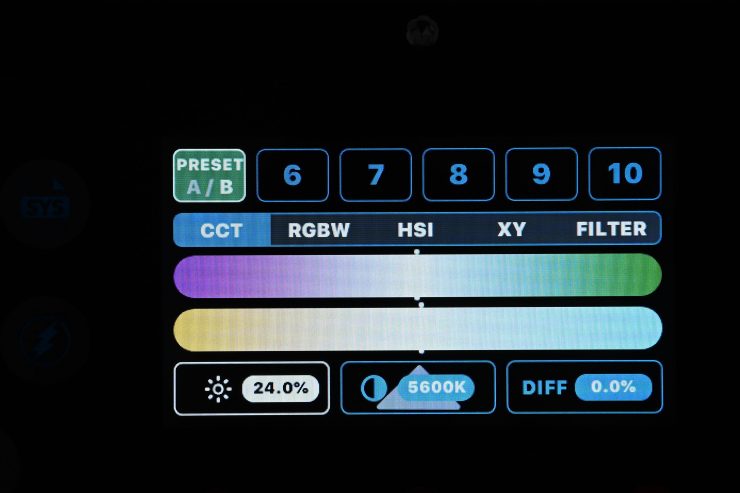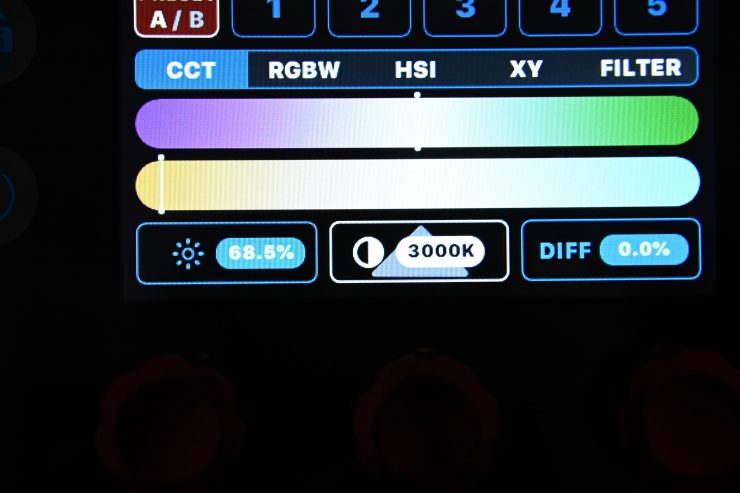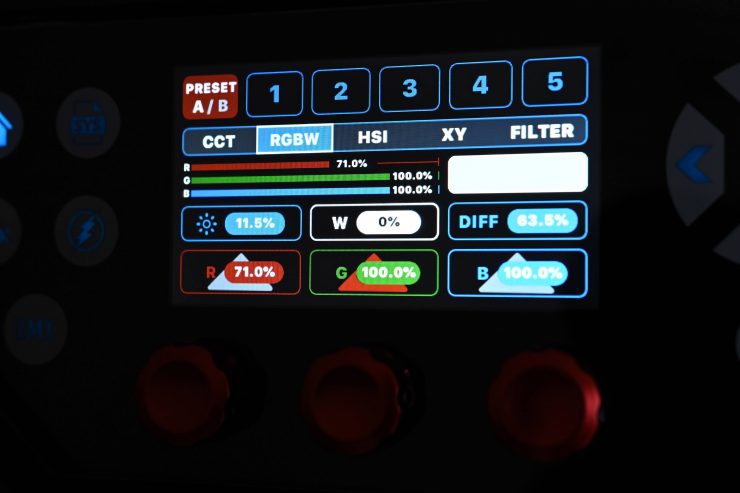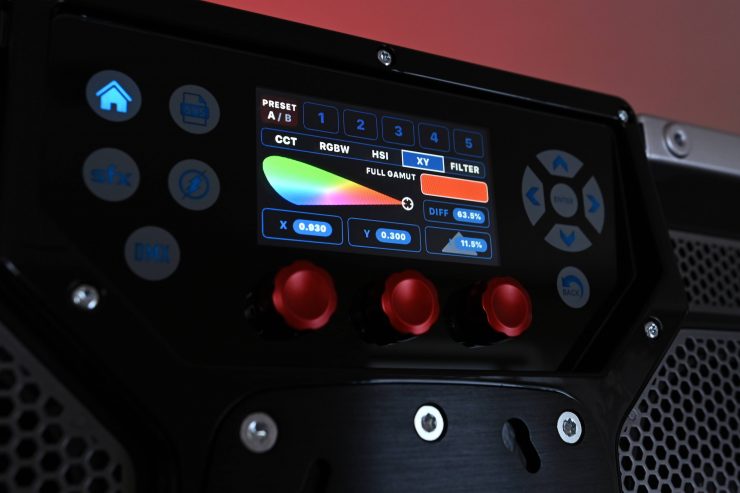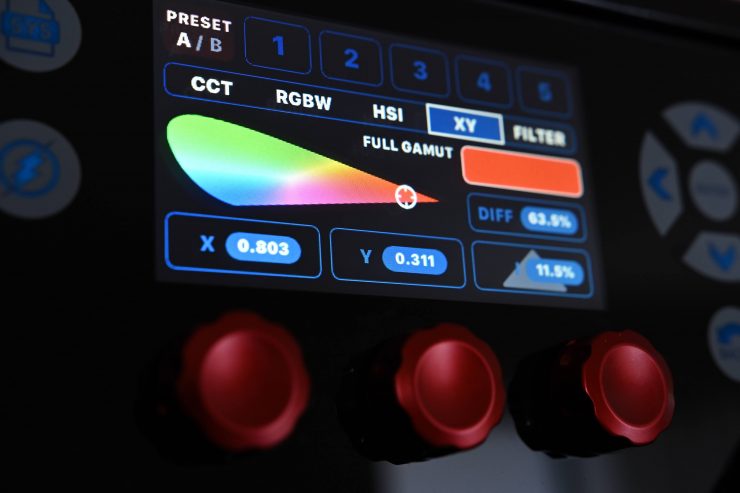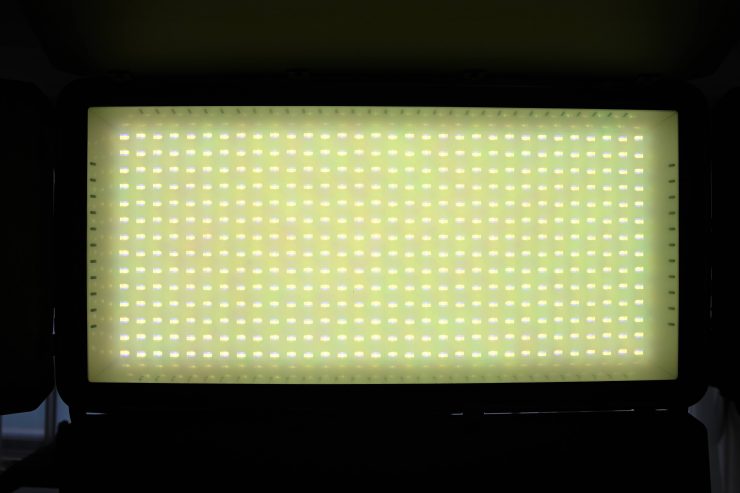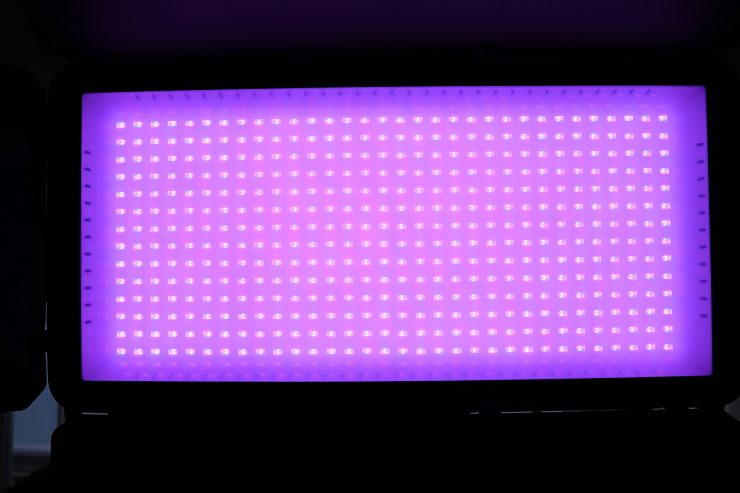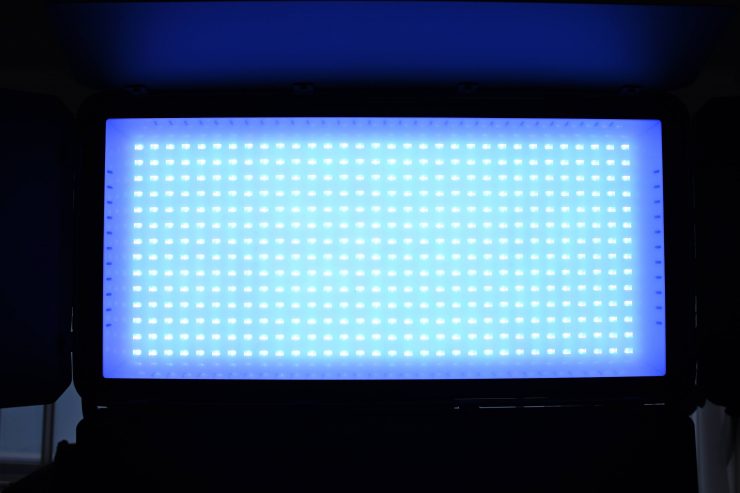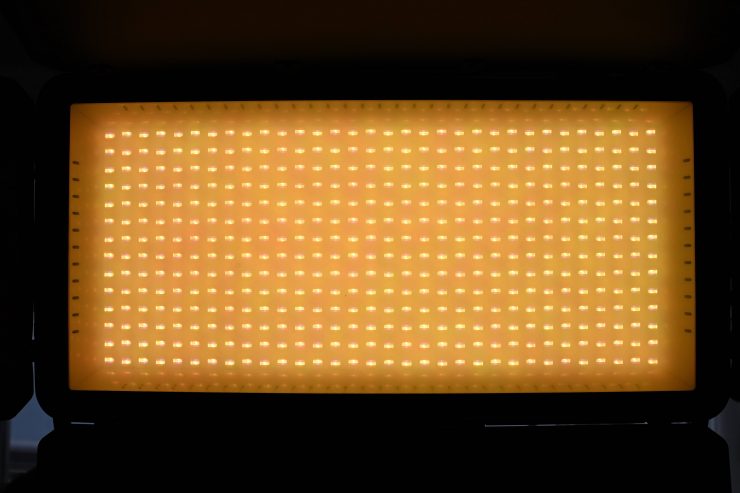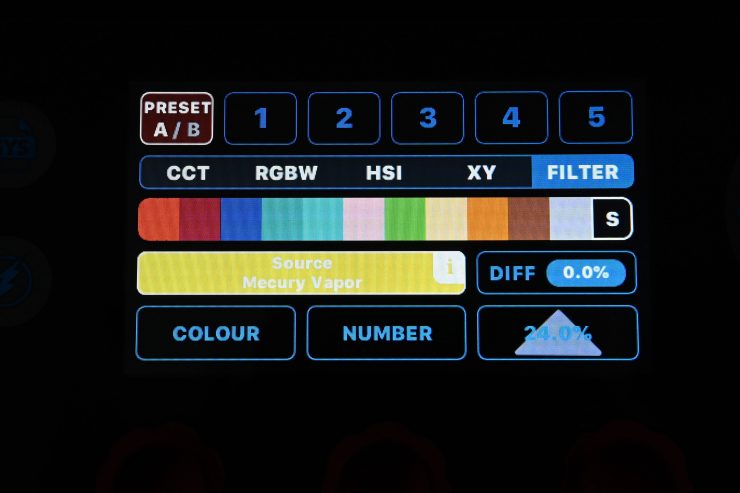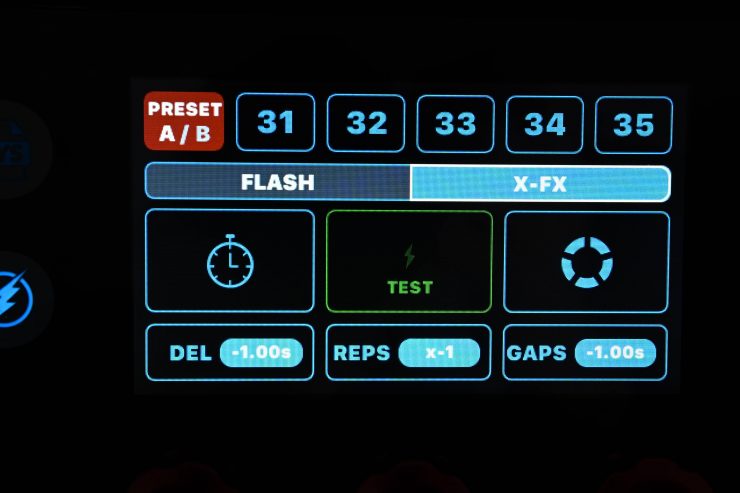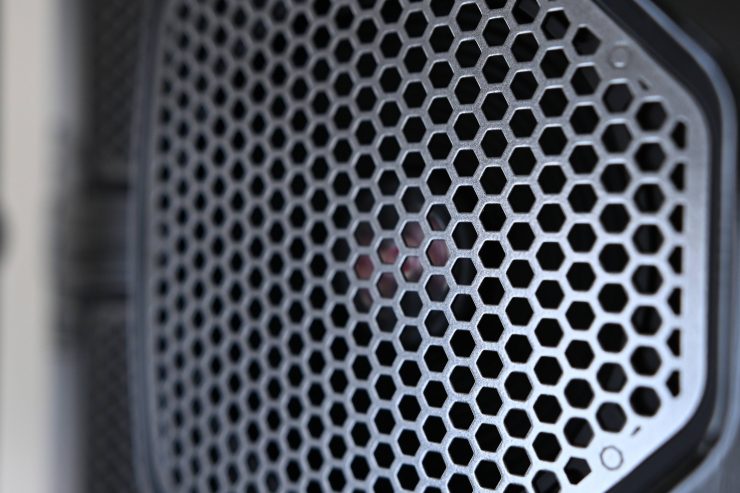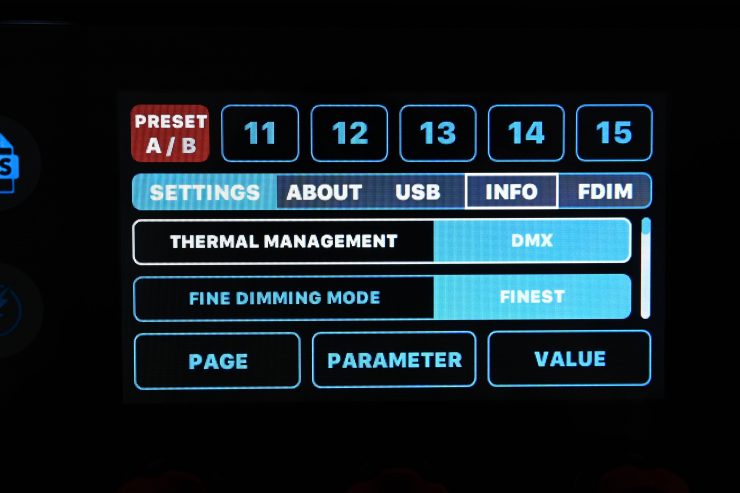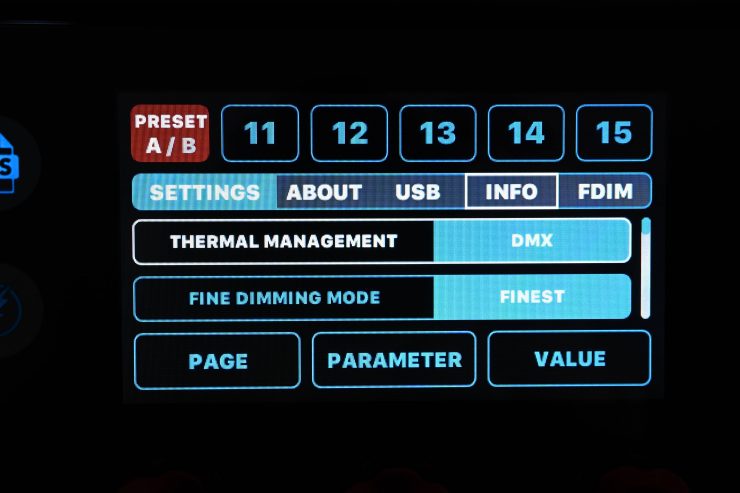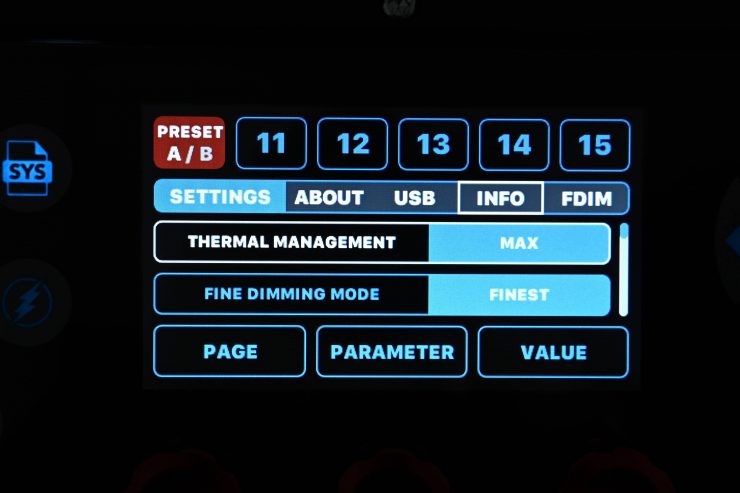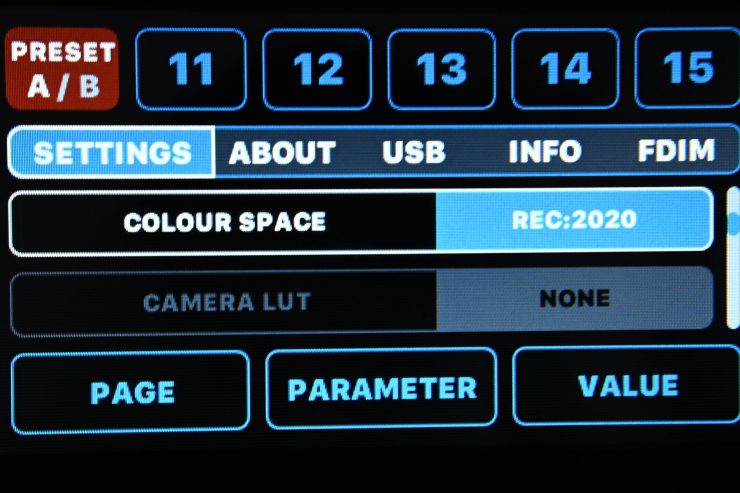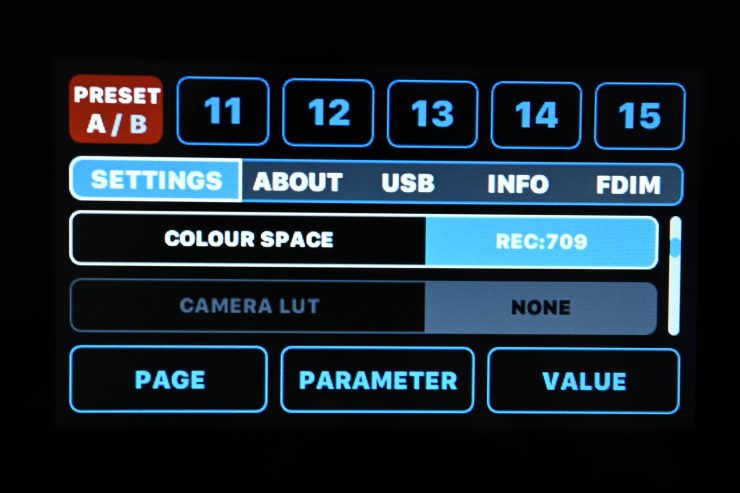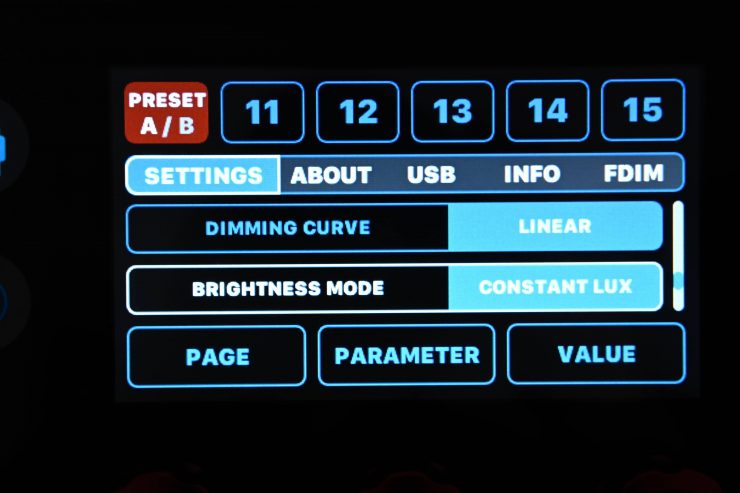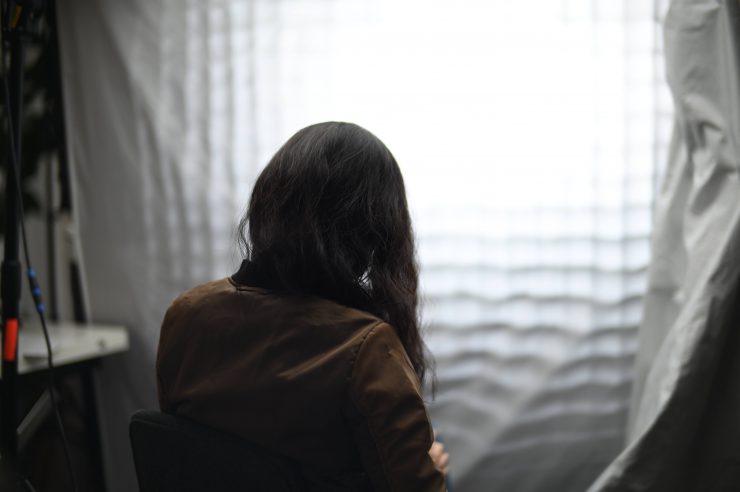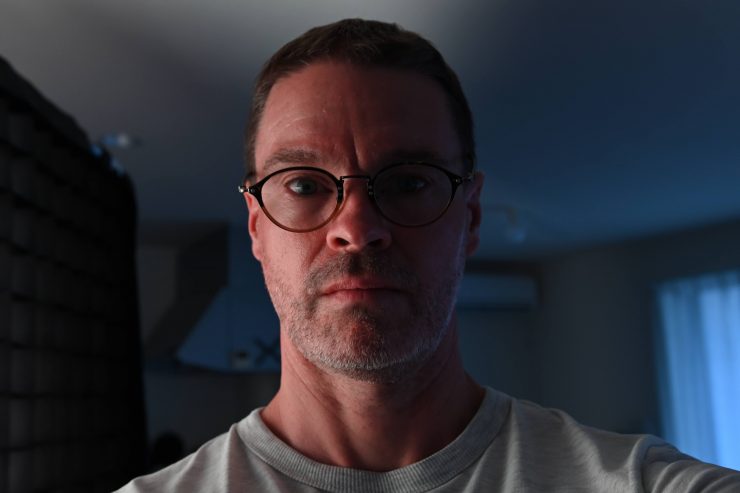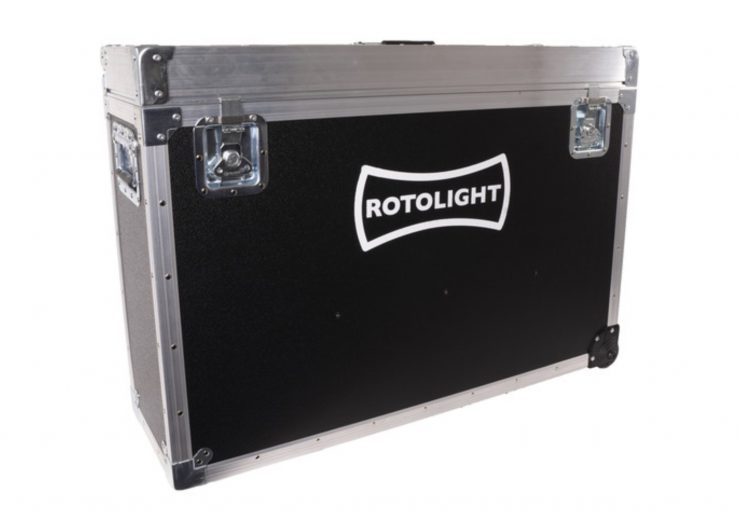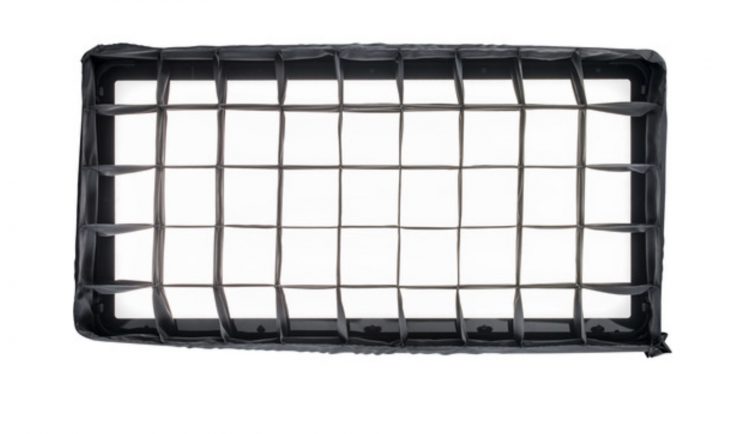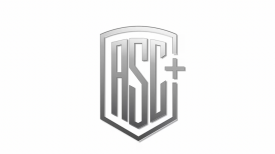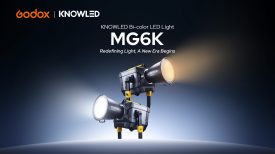
Rotolight unveiled its Titan X2 RGBWW fixture at IBC last September. Not only is the Titan X2 is the British company’s first RGBWW fixture, but it is also their first light that isn’t circular in design.
Now that the light is shipping, I wanted to put it through its paces to see how it performs.
Concept
The concept behind the Titan X2 was to make an extremely bright 2×1 soft lighting source with a host of innovative features. The Titan X2 and the ARRI Orbiter are the two lights that I really wanted to get my hands on in 2020.
Rotolight spent 3 1/2 years working on the Titan X2 to get it to the stage where they were happy to release it. Instead of rushing out an RGBWW fixture, they waited until the technology improved to the point where they thought it was good enough to use in one of their lights.
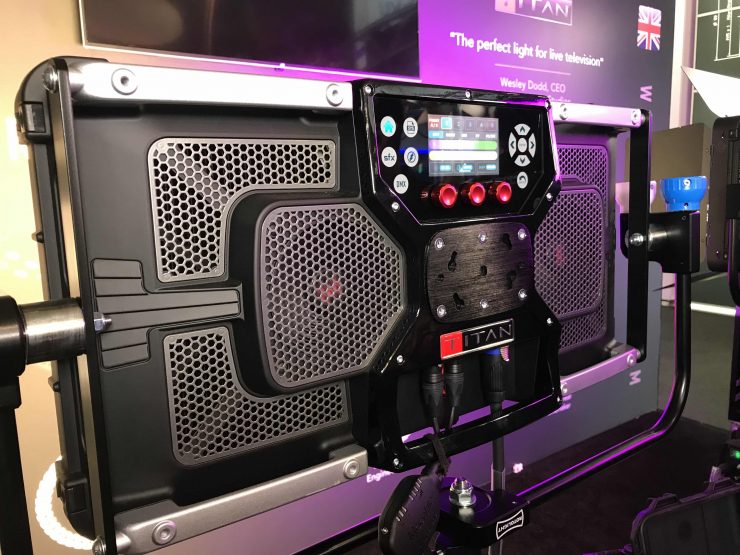
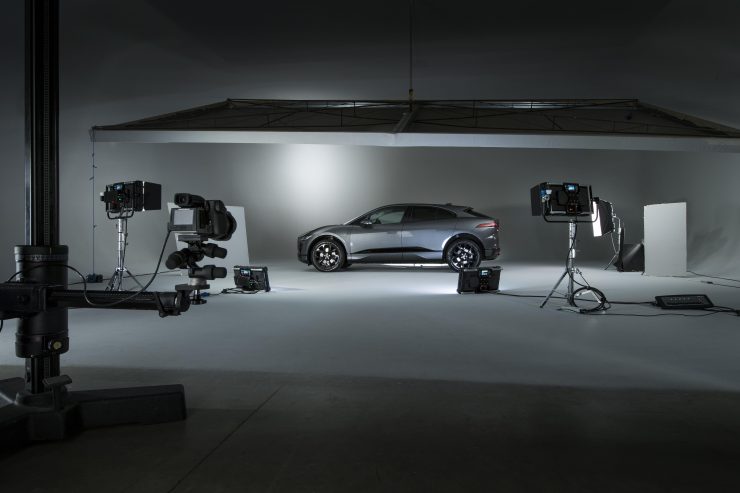
Rotolight is claiming that the Titan X2 is the brightest 2×1 soft light ever made. They go on to say that the fixture delivers more than twice the output of comparable LED lights with none of the added weight. This is a bold claim, given some of the 2×1 fixtures that are already on the market. I will put these claims to the test.
Build Quality
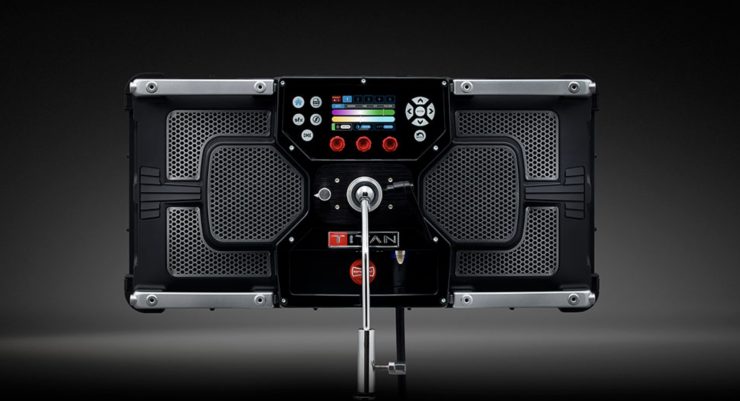
I don’t think anyone could ever accuse Rotolight of bad build quality. The Titan X2 is beautifully made and they have paid a lot of attention to small details.
The Titan X2 is one of the best-built lights I have seen so far. Everything on the Titan X2 is first class.
If you want a light to be widely accepted and purchased by rental houses it has to be rock solid, robust, and reliable. That is why you see so many ARRI SkyPanels in rental shops. It is one thing to make a light that has great features, good output, and good color rendition, but if it won’t stand up to the rigors of field use then no rental house will carry it.
The Titan X2 looks like it would stand up to harsh field use and there is no reason why the light won’t find itself inside a lot of rental houses.
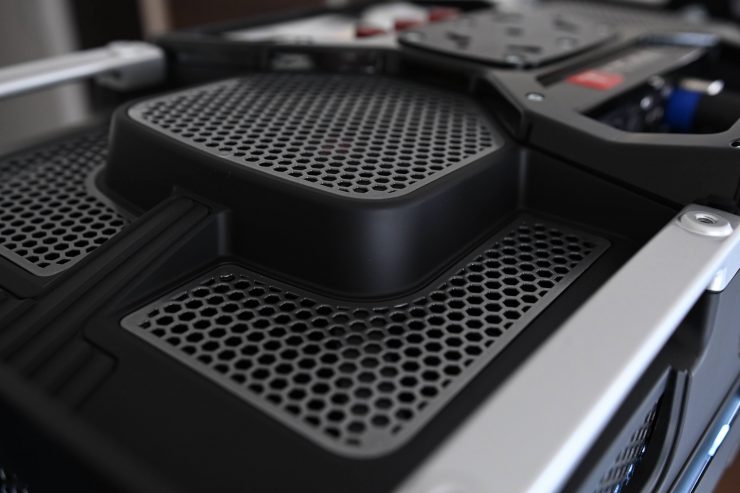
According to Rotolight, ‘The Titan X2 is designed and manufactured in the UK to aerospace standards. The lights are individually hand-calibrated and handcrafted using the highest quality materials‘.
Not only is each light individually hand-built, but they also come with a document that says who built it and when it was built. You also get individual TLCI and CRI scores for that individual light.
Rotolight also includes a full color operating manual that is 35 pages long. Not many companies do this these days, but it is nice to have a physical copy of a manual you can consult if you run into any problems.
Design
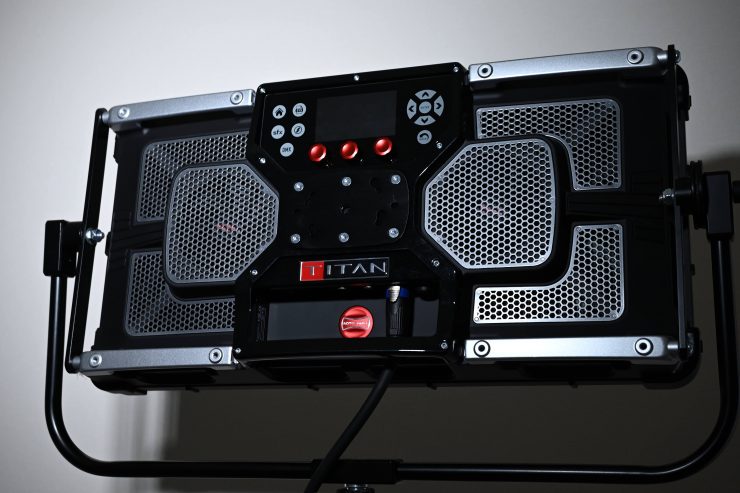
As far as the design goes, a panel light is a panel light. There are only so many ways you can design and build one, at least when it comes to the basic shape and form factor. In saying that, the Titan X2’s design certainly makes it stand out from its competition.
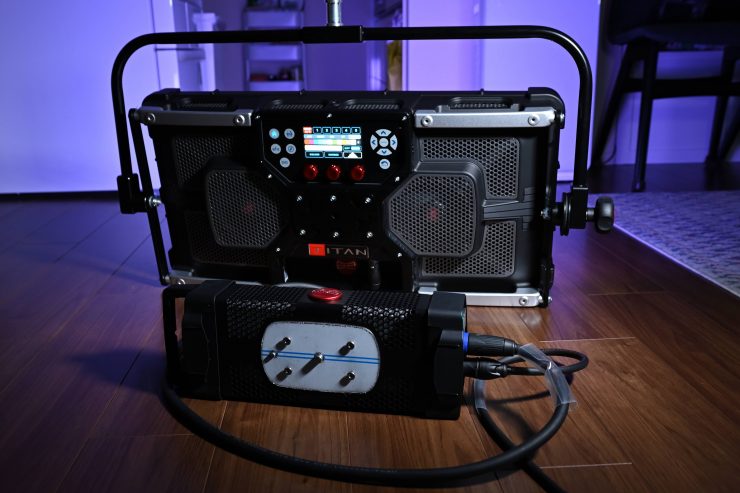
I love how Rotolight has incorporated handles on the top and the bottom of the fixture and that they have put a small foot on the bottom of the Titan X2. These may be small things, but they make a world of difference. The small foot on the bottom lets you place the light on the floor without it falling over.
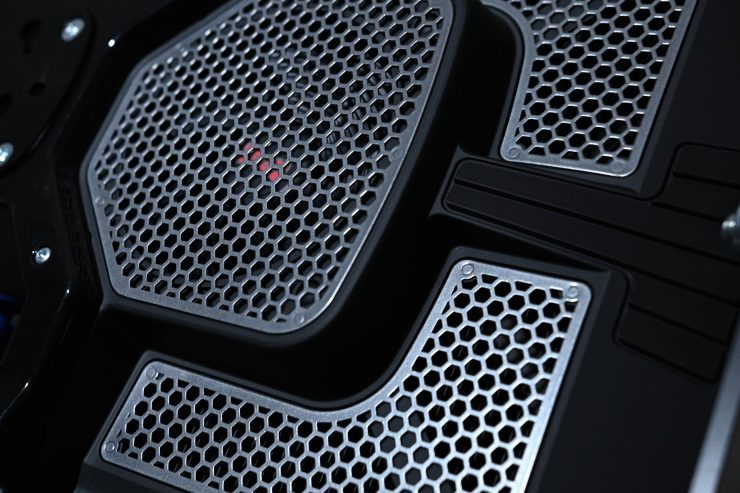
The overall design is very sleek, and the light certainly looks good. Rotolight also offers users a good range of mounting solutions for the Titan X2. These include a swan neck, pole yoke, and standard yoke. There is also mounting points on the top and bottom of the fixture so you can stack lights to make larger lighting sources.
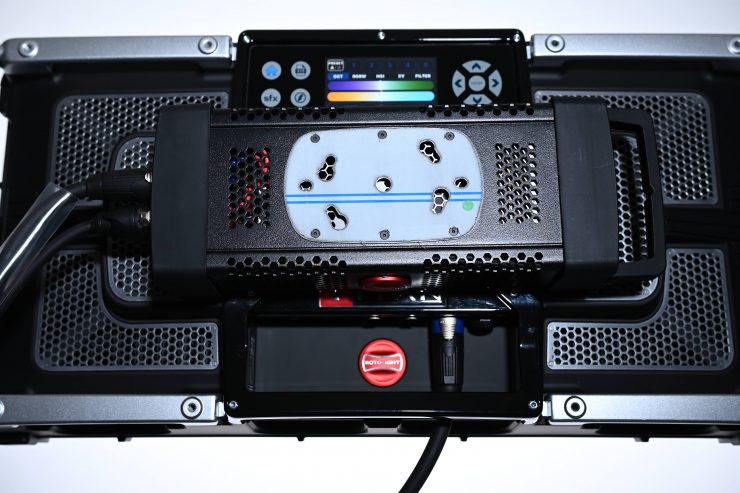
Rotolight has implemented a nice design feature when it comes to the power supply. The power supply can either be attached to the Titan X2 or separated. This gives you the best of both worlds. If you need to take the power supply off and place it on the ground you can. If you want to leave it on the fixture you can. In another nice touch, you can use the mounting plate to attach the power supply to a light stand if need be.
In contrast, the Litepanels Gemini has an in-built power supply that can’t be removed.
The ARRI SkyPanel series power supplies can be mounted directly on the light or removed.
The KinoFlo style mounting bracket that is used to attach or remove the power supply is a great design and you don’t need to use any tools. This has been very well thought out.
You will probably notice that I end up harping on about attention to detail during this review, and that’s because Rotolight has really thought out every tiny detail with the Titan X2.
This is the first light I have used that feels like it is from the future. The whole design and operating interface make it seem like it is far more advanced than many other lights. This may just be a perception, but that is how it made me feel.
Gone are the days where a light was just a light. A lot of today’s modern lights are now a seamless blend of hardware and firmware. The Titan X2 is an example of blending software and hardware. This is something we are going to be seeing a lot more of going forward.
Weight & Size
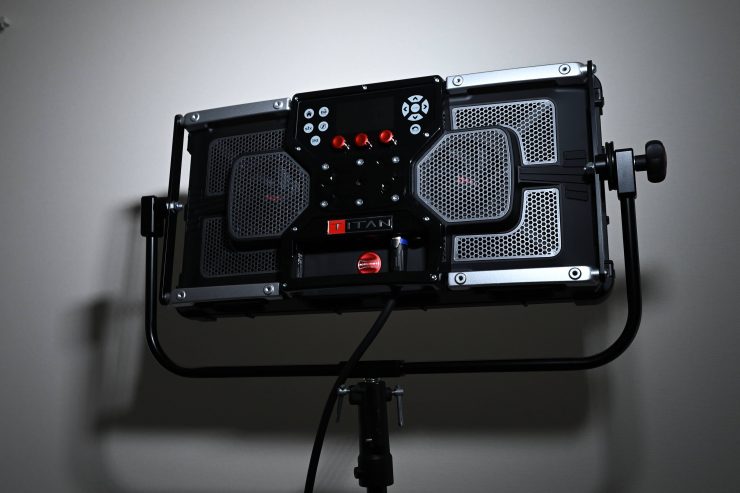
The Titan X2 weighs in at 23.37 lb / 10.6 kg and it has physical dimensions of 27.8 x 13.8 x 5.9″ / 705.0 x 350.0 x 150.0 mm.
What you need to clearly factor in is the power supply weighs an additional 130.51 oz / 3.7 kg and it has dimensions of 14.9 x 5.6 x 3.2″ / 379.0 x 141.0 x 82.0 mm.
There is no way of sugar-coating it, this is a heavy light, and you need to be mindful of this weight if you intend on purchasing or renting one.
So how does this weight compare to some other high output 2×1 RGBW lights? Below you can see:
| Weight | |
| Rotolight Titan X2 | 14.3kg (including power supply) |
| ARRI S60-C SkyPanel | 17kg (including power supply) |
| Litepanels Gemini | 10.1kg* |
| Rayzr MC MAX 400 | 8.3kg (including power supply) |
| Lupo Superpanel 60 Full Color | 9kg* |
| Luxli Taiko 2×1 RGBAW | 8.96 kg (including power supply) |
*These lights have built-in power supplies.
The Titan X2 is a heavy fixture, and its weight falls between a Litepanels Gemini and an ARRI S60-C SkyPanel. To be honest, the weight of the Titan X2 is pretty good considering the build quality.
The Titan X2 is available in an optional flight case, but the problem is, that flight case with the light inside is getting very close to the max weight that you can check in on a commercial plane.
Mounting
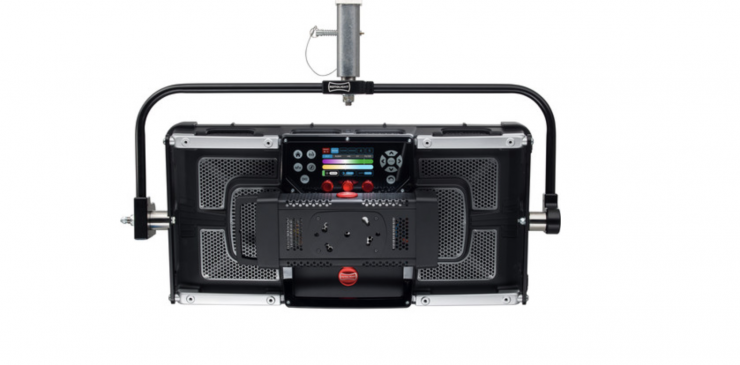
The Titan X2 can either be pole-mounted, attached to a yolk frame, or use a swan neck mount.
The version I was testing had a yolk frame that uses a junior pin for mounting, which is great for added stability, but it does mean you can only use it with select light stands.
The Litepanels Gemini also uses a junior pin and yolk frame.
Power Draw
The light draws 420W (nominal), which is is quite a lot higher than the 325W (nominal) power draw of the Litepanels Gemini 2×1, but very comparable to most other 2×1 fixtures. You can only run the Titan X2 at 60% from batteries via a 2-way or 4-way adapter, but this is the case with a lot of high powered 2×1 fixtures.
So how does the power draw compare to other similar fixtures:
| Power Draw | |
| Rotolight Titan X2 | 420W (nominal) |
| ARRI S60-C SkyPanel | 420W (nominal) |
| Litepanels Gemini | 325W (nominal) |
| Rayzr MC MAX 400 | 400W (nominal) |
| Lupo Superpanel 60 Full Color | 400W (nominal) |
| Luxli Taiko 2×1 RGBAW | 250W (nominal) |
Controls & Menu System
Rotolight went back to the drawing board with the Titan X2 and the light has a very unique touchscreen display where you can make changes. It is super quick to access all of the available lighting modes and make changes.
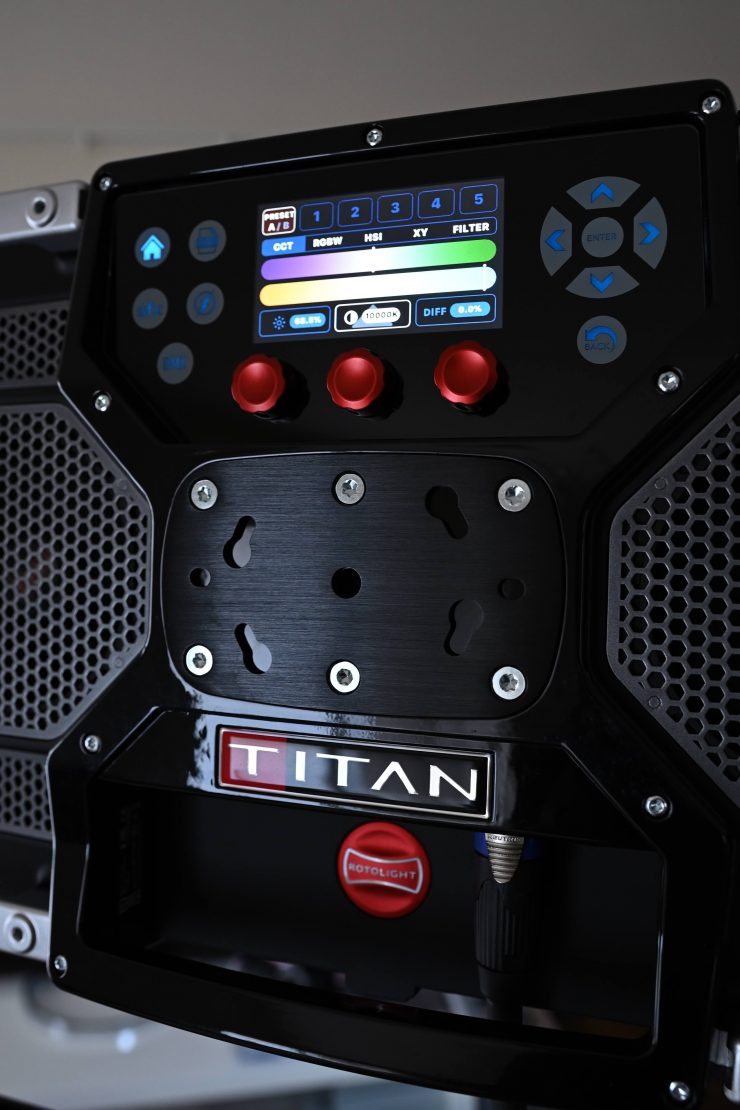
I think what Rotolight did was look at how people are using touchscreen devices such as smartphones and tablets in their everyday lives and come up with a system that feels familiar and practical to use.
I have to hand it to Rotolight, this is the most intuitive and easy to use interface I have seen on a light. I like it when companies realize that the operational aspects of controlling a light are just as important as the output and color accuracy.
With a good light, you shouldn’t have to read a manual to work out how to operate it. You should be able to turn it on and use it straight away. You won’t find any deep sub-menus or complicated way of making changes on the X2.
Despite having touch screen controls, there are also some physical dials that feel very tactile. To be honest, I am always cautious about touchscreen controls because they have to work well and they shouldn’t have any lag or delay. The touchscreen on the Titan X2 is super responsive and you don’t have to continually keep touching the screen to get things to work. It is a nice addition that Rotolight has included dials and switches that also allow the Titan X2 to be controlled without having to use the touch screen.
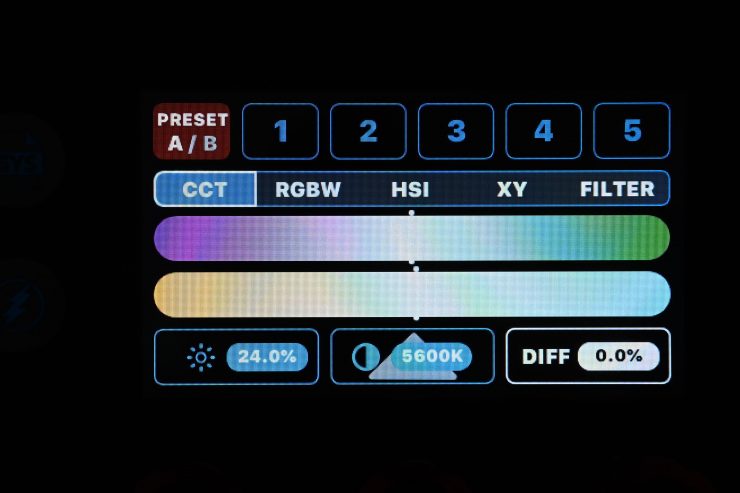
What is nice is that when you are making a change, that item you are adjusting changes to a different color so you clearly know what you are making adjustments to. For instance, in the photo above you can see that I am adjusting the Diffusion as the box around it has turned white. Now, not all the controls work like this and some items have to be adjusted using the dials and not the touchscreen.
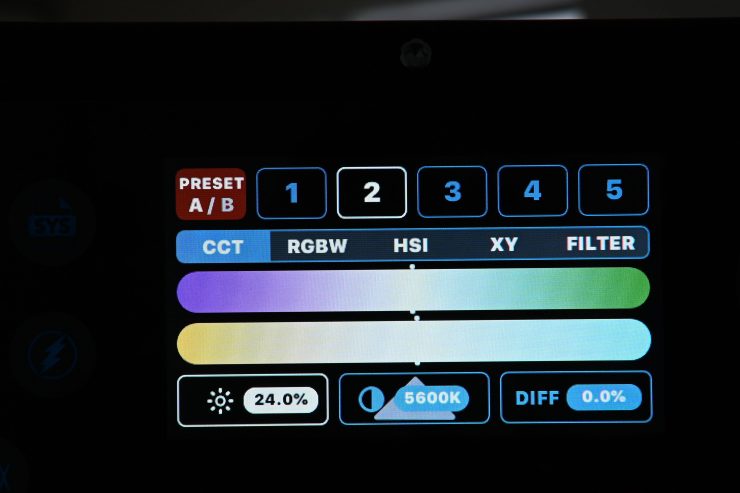
Rotolight has also included a ton of preset buttons so you can save your favorite settings and access them instantly. This is a great feature and very handy.
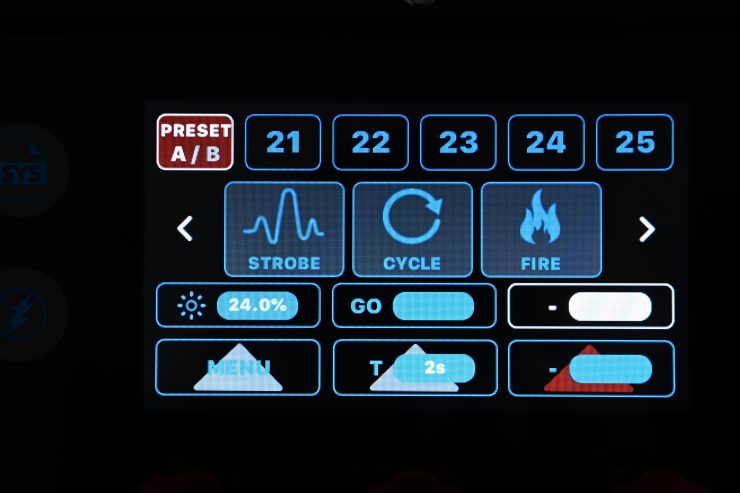
There are 10 preset buttons for all of the different operating modes. This has been well thought out because the presets reflect the operating mode you are in. For instance, in the CineFX mode, you get 10 presets that are labeled 21-30.
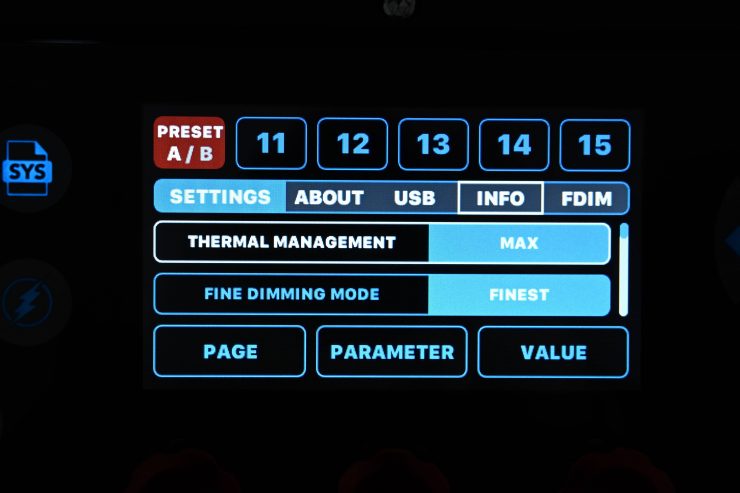
Despite having pretty in-depth menus and lots of parameters you can change, the light is still easy to operate thanks to the touch screen controls.
The nice thing about presets is that if you are working with certain cameras and you have pre-dialed in a look that you know works well with that camera, you can just store it and then bring it up the next time without having to adjust all the settings. This saves precious time and allows for accurate repeatability with your lighting.
No App (yet)
Despite having plenty of options for DMX and great onboard control, the one thing that is missing is a fee iOS or Android app. I would have liked to have seen a dedicated WiFi or Bluetooth app where you could replicate the rear screen and controls on your tablet or phone.
This is something Luxli does really well with the Taiko 2×1.
The Titan X2 will be app controllable, and soon you will be able to control it with the Luminair 3 app. Unlike either the SkyPanel or the Gemini, Rotolight has an integrated Lumenradio TimoTwo module inside the lamp which saves users around $400 USD on buying a wireless dongle for each lamp.
Rotolight will be releasing this update in the next 4-6 weeks. No routers or other accessories will be required.
RGBWW
We are seeing a lot of lighting companies now using RGBW technology. RGBW stands for Red, Green, Blue & Warm White. There are, however, other types of RGB such as RGBWW and RGBAW. The Titan X2 uses RGBWW, which consists of 5 chips, not 4. The extra chip means the light not only has a warm white chip, but also a white chip. This is different to say the ARRI SkyPanel where they are actually mixing colors to obtain white. RGBWW can also be found in other similar lights such as the Litepanels Gemini, Rayzr 7 MAX 400, and Lupo Full Color 60.
While in theory, an RGBWW LED should be better at creating color mixes, it requires significantly more cooling than a regular RGB LED.
Operating Modes
The light has a palette of over 16.7 million colors that are all accessible across five lighting modes:
- CCT
- HSI
- RGBW
- XY
- Filter
Correlated Color Temperature (CCT) MODE
This is the mode most people are going to use the light in. In the CCT Mode, you have full access to making Kelvin color temperature adjustments between 3000-10,000K. These adjustments can be made in increments of 20K.
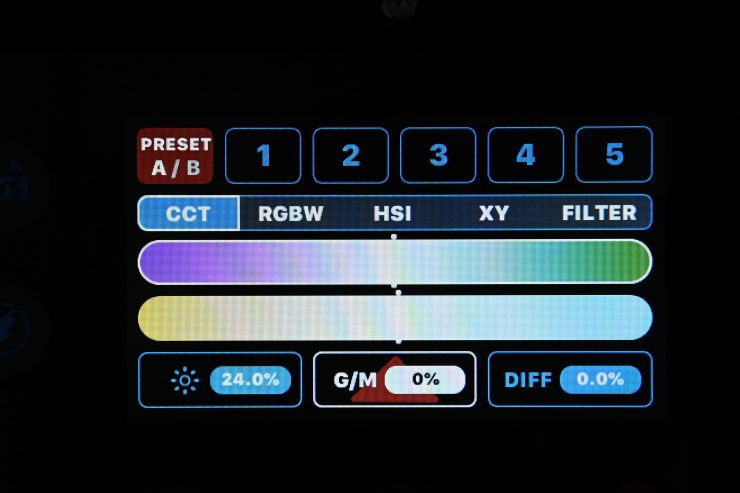
The fixture also has continuously variable (full minus green to full plus green) correction.
Being able to dial in more or reduce the amount of green coming from your lighting source can make a huge difference. Different camera companies use different sensors in their cameras and they all react differently to light. Some camera sensors may lean towards magenta, and some, more towards green. By making CCT adjustments you can dial in the light so that it looks better for whatever camera system you are using. CCT adjustment also helps when you are trying to match lights from different manufacturers.
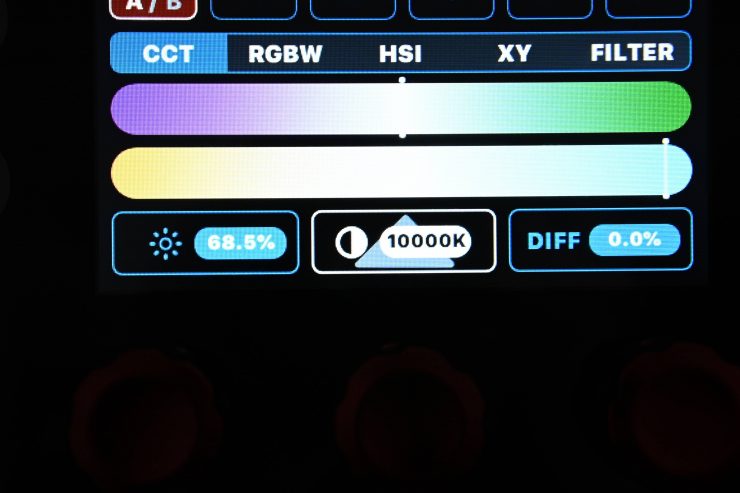
The Kelvin color temperature range is impressive and it should suit most people’s needs.
HSI Mode
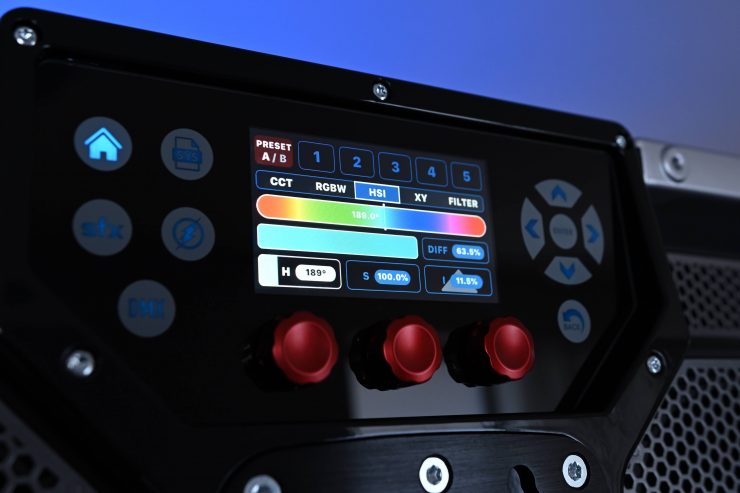
The HSI mode lets you create just about any color you can think of. It gives you full hue and saturation control as well as intensity. By manipulating, the hue and saturation you can create some really interesting colors that depending on the project you are working on can really add some creative flair. I quite like using this mode to create a lot of color separation between the foreground and background, or for recreating a really cold or warm-looking image.
The colors are represented as degrees from 0-360 and you can mix from red (o degrees) to green (120 degrees) through to blue (at 240) degrees and back to red (at 360 degrees).
By using a touchscreen interface with visual aids it is so much easier to dial in the exact color you want to create. On some lights, you have to use dials with no visual reference.
RGBW Mode
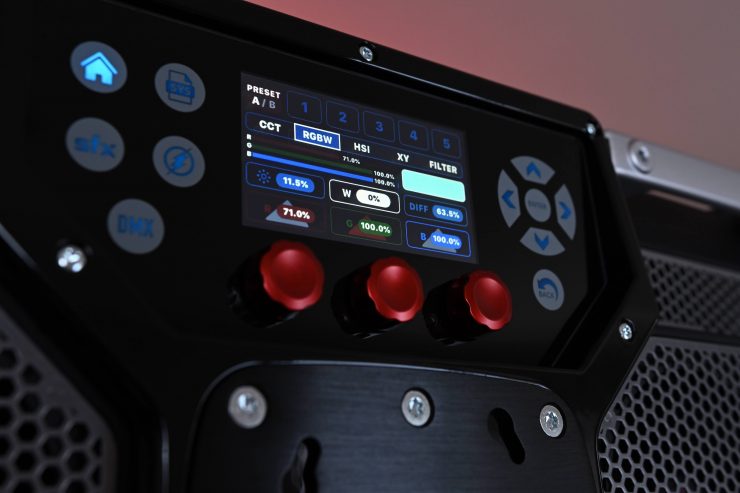
In his mode, you have full control over how much Red, Green, Blue, White, and Warm White are being used. This way you can mix various color combinations to achieve a certain color you are after.
XY Mode
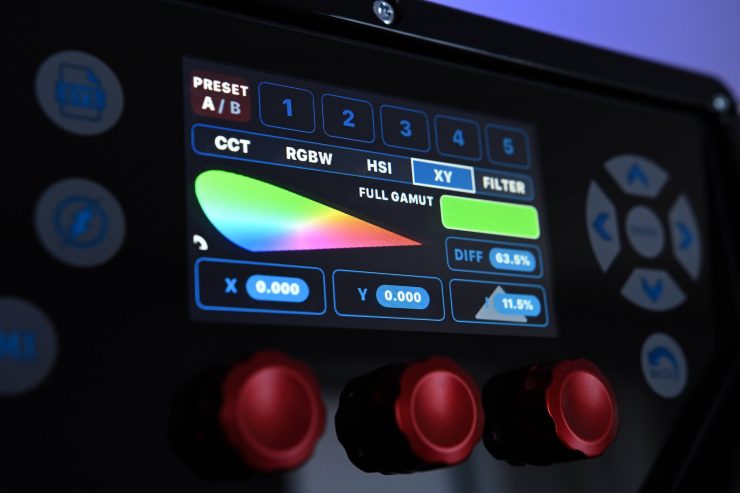
In this mode, you can create colors by changing the X and Y coordinate axis. This gives you more finite control for creating colors than using the HSI Mode.
I love how you can just drag your finger around to create the color you want. This makes it so much easier than dealing with systems where you are adjusting the X and Y axis separately with dials.
Filter Mode
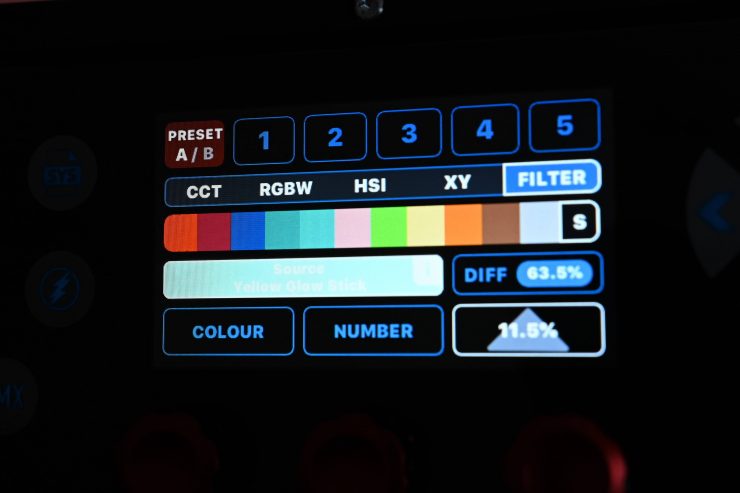
Inside the fixture, there is a whopping library of more than 1,400 industry-standard gels from companies such as Lee, Rosco, Apollo, and CamColour.
Having built-in Digital Gels not only means that you don’t have to physically carry gels around, but you can also quickly and easily replicate popular gels. Using the gel mode can help you match other lighting sources, especially if you are working with other lights with physical gels.
What I like is that Rotolight has included 50+ sampled light sources that you can replicate, such as tungsten, candlelight, HMI, sodium vapor, fluorescent, etc. In some regards, I personally find this more useful than the gels.
CineSFX
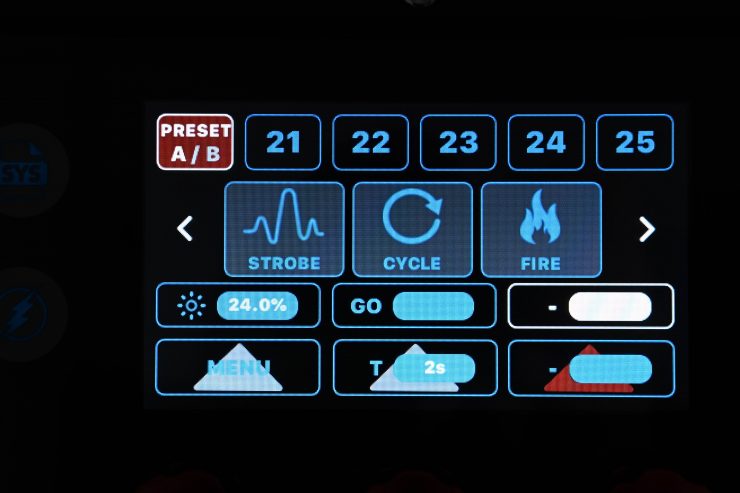
Rotolight has always been known for its customizable CineSFX. These are included in all of Rotolight’s fixtures, and it is no surprise that they are in the Titan X2. CineSFX utilizes Titan’s RGB color engine to deliver even more realistic full-color lighting effects.
Effects mode lets you recreate a wide range of lighting effects that can be handy for certain scenarios. The effects include:
- Fire
- Lightning
- TV
- Gunshot
- Paparazzi
- Police
- Neon
- Film
- Fade
- Strobe
- Throb
- Weld
- Chase
- Cycle
All the effects modes can be individually adjusted and tailored to your lighting needs.
What does the Titan X2 offer that its competition doesn’t?
Most of today’s RGBWW lights all seem to have the same or very similar feature sets. In fairness there is probably only so much you can do with current technology. Rotolight had to step out of the box and come up with something that was different and unique.
Rotolight knew that if they were going to enter the 2×1 ARRI dominated market, they had to deliver something that was technically superior, with features that had never been seen before. The light would also need to provide additional creative options and save time and money for DOPs, broadcaster, and gaffers. It also needed to have build quality that would stand the test of time.
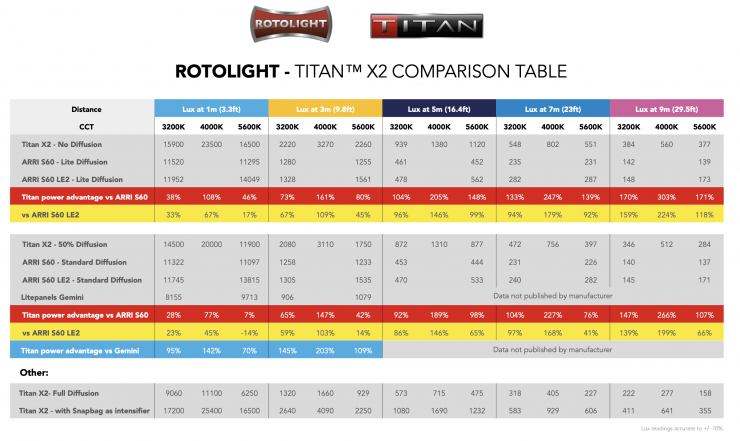
Rotolight put out a comparison table showing how the Titan X2 compares to the ARR S60-C SkyPanel. Please bear in mind these are Rotolight’s figures and I have done my own independent testing comparing the Titan X2 against the ARRI and Litepanles Gemini. You can see those tests further down in the article.
+/- green adjustment, hue, saturation and intensity (HSI) control, the ability to dial-up gels, and lighting effects have been available in the ARRI SkyPanel series since 2014 and quite a lot of other RGBW, RGBWW, and RGBAW lights for some time. Just adding those features and those features alone wasn’t an option for Rotolight.
Rotolight wanted to produce a light that was fitting for the 21st century, that like a smartphone does not require you to read a manual in order to work out how to operate it or any of the advanced features found within it.
According to Rotolight, the key features of the Titan X2 are:
- With industry-first SmartSoft™ technology, you can electronically adjust the light’s diffusion, focus, and spread; eliminating the need for gels, whilst its gorgeous soft output and large beam aperture wraps flatteringly around subjects.
- Effortlessly access key features with an easy to use interface, quick-start icons, and 10 user-customizable presets, saving time on set. With a full-color touchscreen display, preview Titan’s™ extensive filter library to achieve the exact color you want at a moment’s notice.
- Meticulous in its color rendition, Titan™ X2 excels in both CRI and TLCI performance, saving time in post-production.
- The Titan™ X2 also features Rotolight’s award-winning suite of user-customizable CineSFX™ (Fire, Lightning, TV, Gunshot, Paparazzi and more); providing endless creative possibilities on set.
- Equipped with High-Speed Sync flash (1/8000th) with powerful output and zero recycle time; Titan™ X2 is also ideal for high-end studio and portrait photographers.
- Titan™ X2 is the brightest 2×1 soft light ever made, with none of the added weight.
Two things that Rotolight offers in the Titan X2 that you won’t see in other competing lights is the patent-pending SmartSoft™ technology and High-Speed Sync flash. There are also a host of other features (although some are yet to come and will eventually be available in firmware updates).
SmartSoft
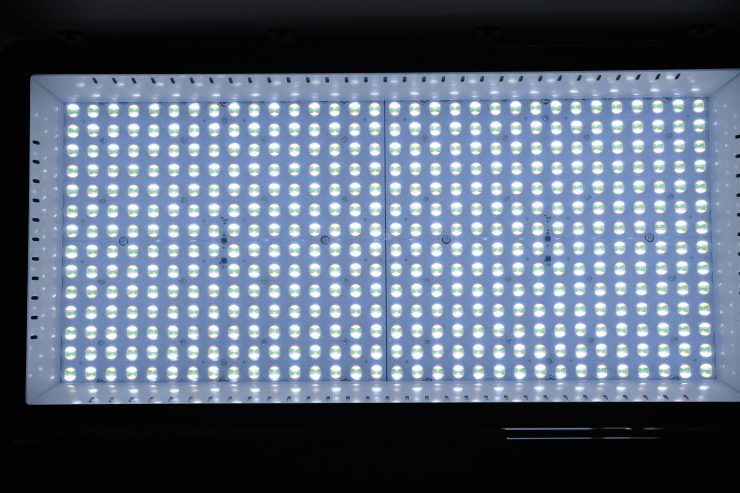

No Diffusion 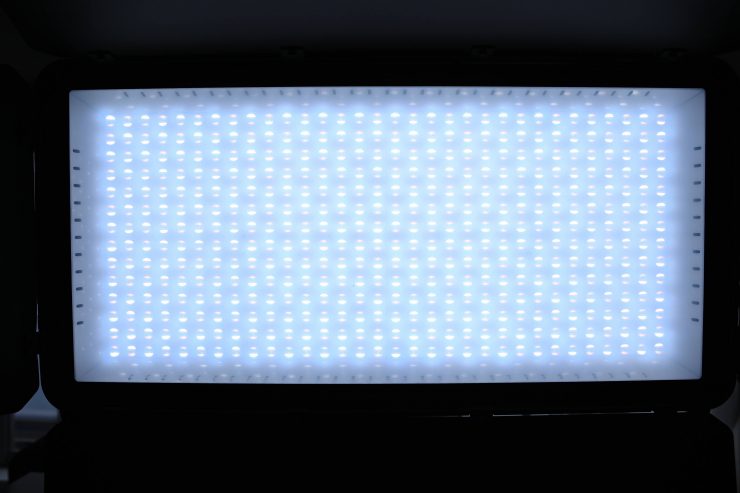
Diffusion at 50% 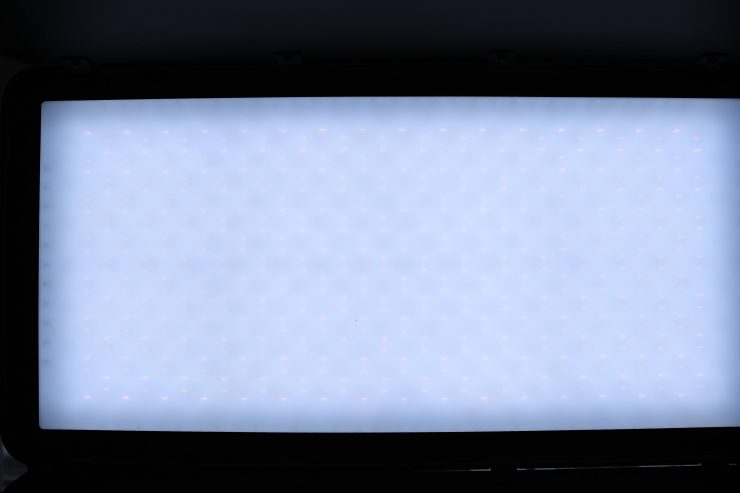
Diffusion at 100%
SmartSoft is Rotolight’s new patent-pending technology that electronically adjusts the light’s diffusion, focus, and spread. This is handy for providing control whilst eliminating the need for gels. SmartSoft can be adjusted locally on the light, via DMX or wirelessly. Rotolight claims that the Titan X2 has the largest light aperture of any 2×1 fixture.
One of the major issues Rotolight wanted to solve with the SmartSoft Diffusion related to the feedback they got from countless gaffers and DOPs. This feedback was that RGB lights have now become commonplace, which largely eliminates the need for traditional filters or for magenta/green correction. However, if you still have to manually adjust the diffusion with every single lamp for every single scene, it wastes a huge amount of time climbing up a ladder or lowering the truss and adjusting the diffusion on numerous lamps on a studio truss.
So, Rotolight wanted to create the world’s first electronic diffusion in an RGB/ studio light, that would be fast, easy to operate, and importantly – repeatable, so preferred settings could be saved and recalled for later scenes.
What is great about SmartSoft is that you are essentially able to electronically vary the beam angle from 68 degrees to 150 degrees. This is something I haven’t seen done before and it certainly makes the Titan X2 a very flexible lighting source. By varying the beam and you are actually diffusing and softening the light. Please bear in mind that you won’t see a massive change in the beam spread like you would when using a fresnel light.
SmartSoft works by using electronically charged LEDs. By controlling the charge, you can tell the LEDs what to do. This allows you to manipulate the light that is being emitted.
At its heart lies the Rotolight PentaChromic color engine, that uses the latest LED technology in a high power 7070 SMD package, this delivers what is claimed to be, the most powerful 5 channel color LED chip with RGBWW color mixing. According to Rotolight, the 1 watt warm and cold white LEDs are said to provide outstanding color reproduction and excellent skin tones and the RGB chips create an enhanced color gamut with 60% better color saturation than other 2×1 lights on the market due to the increased power on the RGB channels.
For the SmartSoft Diffusion itself, Rotolight uses an advanced liquid crystal film that is electronically charged (with its natural resting state with no current being fully diffused), and it enables them to change the properties of the particles and specifically how they spread light. By applying this charge the beam angle changes from 65 degrees up to around 150 degrees at full diffusion. This can be controlled locally via the knob on the light, wirelessly, or over wired DMX.
For the system to work Rotolight also had to develop a custom optical lensing system for Titan not seen in other 2×1 panels. SMD (Surface Mount Diodes) are not commonplace in LED technology, but they natively have a much wider beam angle (typically around 140 degrees). So in order to not sacrifice output and ensure the SmartSoft was as effective as it could be, Rotolight developed a unique Linear Planar lens to focus the light onto the Smart Soft Material, which in turn, then allows them to electronically adjust the focus, diffusion, and spread.
Another key requirement and advantage of this linear planar optic were to eliminate ‘multi shadowing’ artifacts associated with fresnel lenses, which are commonly found on most other systems. In theory, this gives Titan a huge advantage over the competition as the light output and shadowing should look bright, smooth and natural, whilst evenly distributed across the SmartSoft Diffuser.
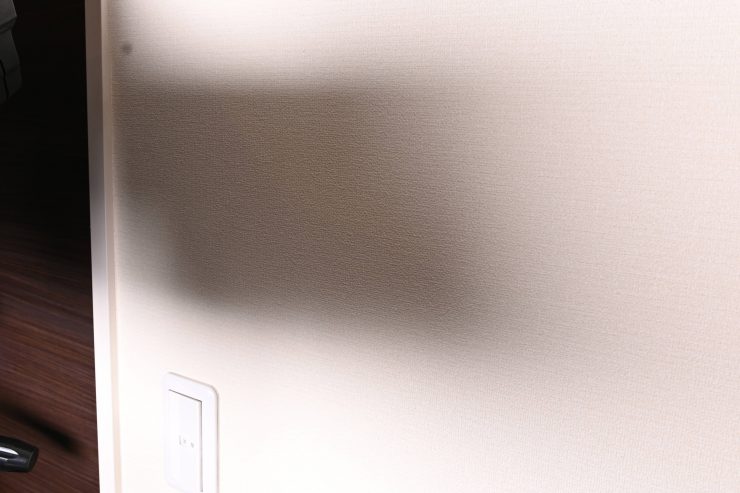

SmartSoft diffusion at 100% 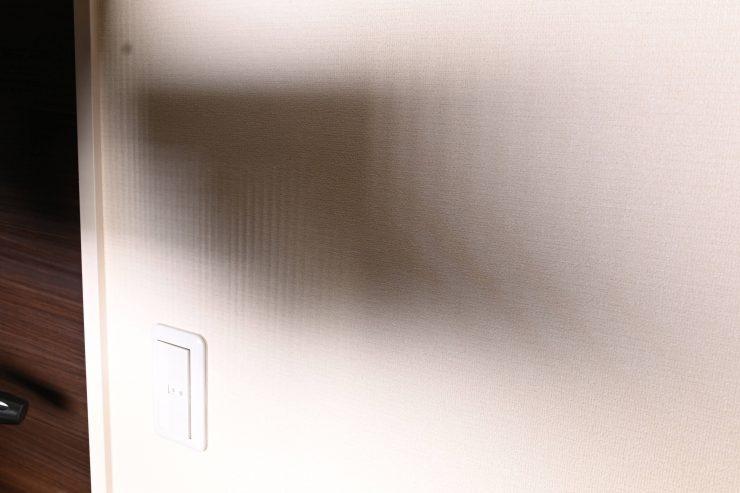
SmartSoft diffusion off
There is a noticeable difference to the type of shadows you get when using the SmartSoft over having it turned off. Above you can see that with the SmartSoft being used you get much cleaner and softer shadows. If you have it turned off the individual LEDs can be seen and they create those bad hatch style shadows that nobody likes.
The SmartSoft diffuser system is also specifically tuned to the Titan, and color calibration is maintained across the diffusion range by using a Dynamic Color Control engine which dynamically adjusts both the CRI response and magenta/ green adjustments. Rotolight claims that this allows the Smartsoft Diffuser to maintain a neutral color balance with no color shift throughout its range.
The SmartSoft diffusion works remarkably well and I love how you can fine-tune it to your needs. This really is a huge drawcard of the light and one that sets it apart from its competition. It is good to finally see some companies innervating new technology into lights.
High-Speed Sync flash
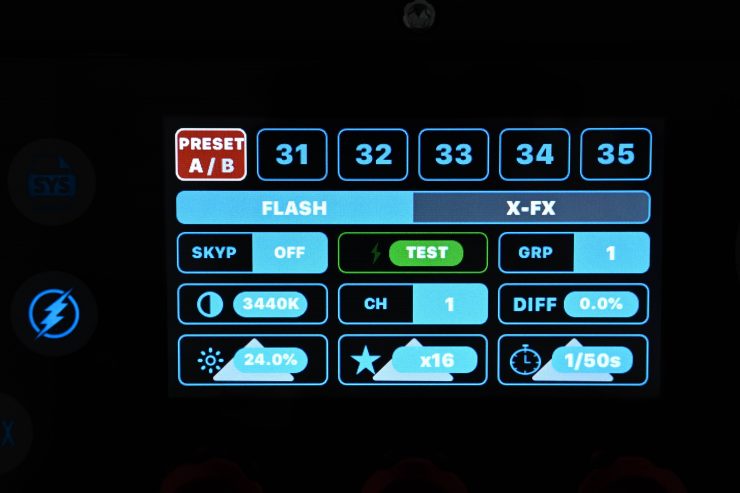
The Titan X2 features an integrated Elinchrom Skyport receiver that can be paired with a separately available transmitter to control up to 10 Titan X2 units at speeds up to 1/8000 second. Just to be clear this feature isn’t available yet, it is coming in a firmware update.
For those who are shooting both stills and video, this product eliminates the need for two separate purchases and removes many of the constant downsides of shooting with strobe (e.g. your flash not firing because of recycle time). If your job calls for both stills and video, or you’re working in multimedia, this is a nice feature to have. While it is never going to be a direct replacement for an actual strobe, it will get the job done in a lot of scenarios.
However, this feature does make the Titan X2 a good option for both video and photography use.
How does it stay cool?
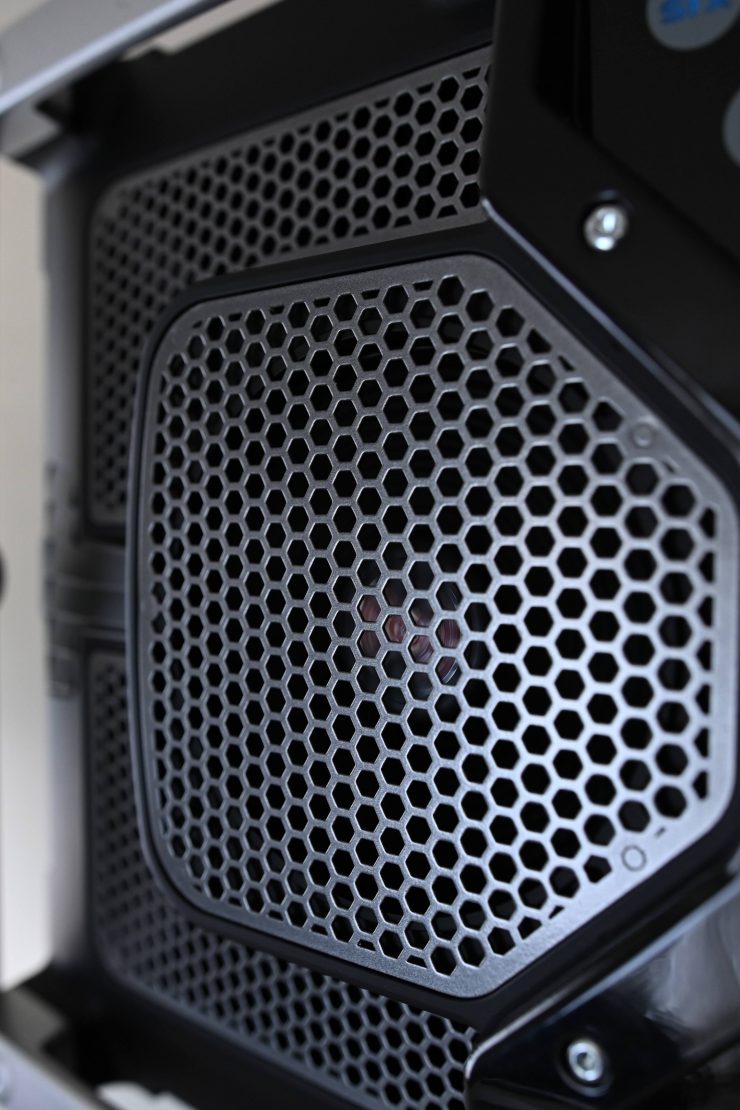
Large, high powered RGBWW lights get very hot, and keeping them cool is not an easy task.
The Titan X2 has a couple of large fans, but when the light is operating normally you would barely know they were on.
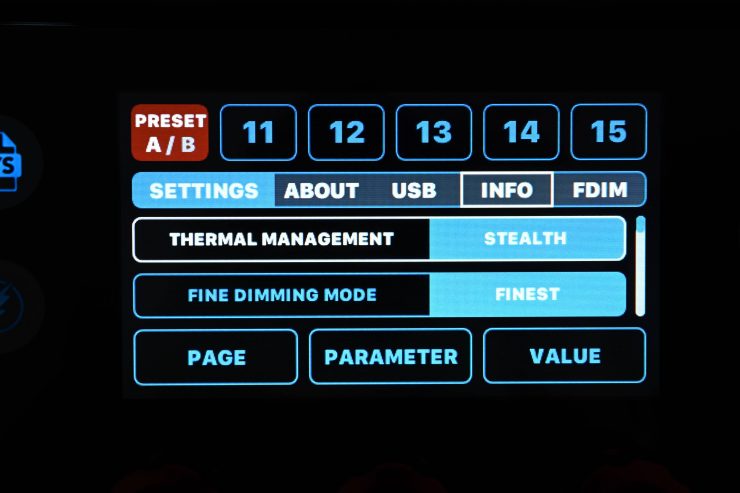
Rotolight has a Thermal Management section in the menu where you can choose between Auto, Stealth, DMX, and Max. On Stealth you can’t hear anything and a lot of times on Auto you wouldn’t even know if a fan was on either. If you select Max the fans fire up and they do generate quite a bit of noise.
I’m not quite sure when the fans would start to make significant noise when the light is in its Auto setting. I found that the fans starting making more noise when I was using the XY, RGBW, and Filter operating modes.
Beam Angle
As I mentioned earlier the Titan X2 uses SmartSoft technology so the beam angle can be changed from 68 degrees to 150 degrees. This makes it a lot more flexible than the competition.
The Titan X2 can produce a wider and narrower beam angle than any of its direct competition with the added flexibility of being able to tailor that beam angle to your needs.
As I mentioned earlier, this is not a Fresnel light, so when you change the amount of SmartSoft Diffusion you are not going to see a huge noticeable difference. You can certainly see the difference, but it isn’t like going from spot to flood on a Fresnel fixture.
Below you can see what the beam angle is of other competing lights:
| Beam Angle | |
| Rotolight Titan X2 | 68 degrees to 150 degrees |
| ARRI SkyPanel S60-C | 115 degrees |
| Litepanels Gemini 2×1 | 93 degrees |
| Razyr MC MAX 400 | 120 degrees |
| Lupo Superpanel 60 Full Color | 115 degrees |
| Luxli Taiko 2×1 RGBAW | 76 degrees |
With lights such as the ARRI SkyPanels, you can put accessories such as honeycomb grids, benders, and intensifier panels that will change the beam angle.
Color Space
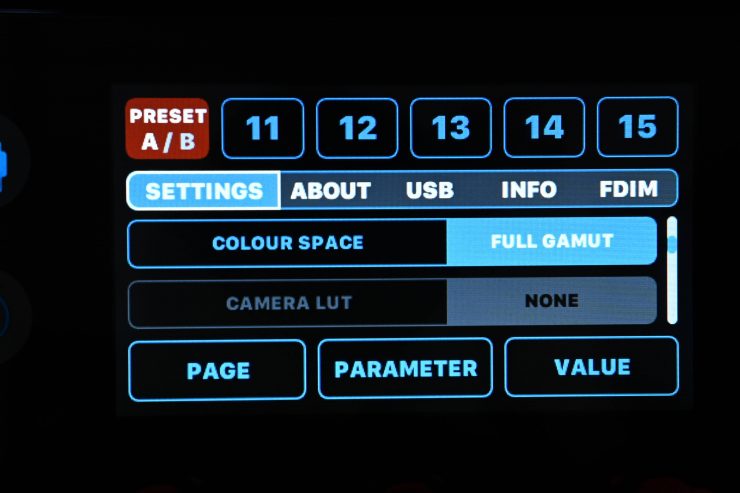
This is something you don’t see in a lighting menu. On the Titan X2, you can choose from Full Gamut, REC.709, or REC.2020. This is important if you are using the XY mode so that it is not possible to accidentally set a color that cannot be seen in the color space you happen to be working in.
With certain Kino Flo fixtures, you can also input a color space.
Camera LUT
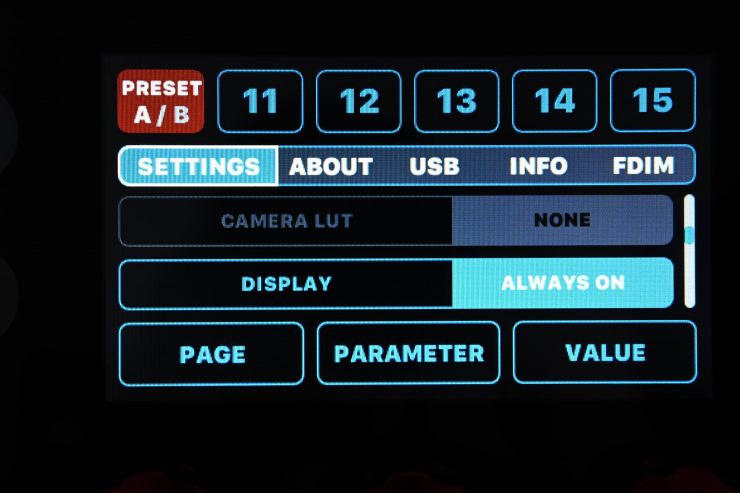
This is something that will be coming in a future firmware update later this year. It will allow you to tell the light what camera system you are using so it can then map the light to work with a particular camera sensor.
There will initially be options for ARRI ALEXA, Sony VENICE, Panasonic Varicam, RED Dragon, and Canon C300.
So how is this going to exactly work? These LUTs are being developed directly in conjunction with leading cine and broadcast camera manufacturers, with the intention of providing a color system that is tuned to deliver optimized color for each specific camera and help match the unique spectral response of their sensors.
These changes can then be selected in the Titan System and are then applied using the Dynamic Colour Control engine inside Titan. As I mentioned earlier, Titan also includes selectable colorspaces (REC:2020 / REC:709 / Full Gamut) so the light can also be automatically set to match the broadcaster’s desired output, i.e. (HD2K, Ultra HD 4K or Film).
All these system selectable options can be set into personalized presets, which can be recalled as required, or stored onto a USB memory stick. This allows a DOP to rent a light when working on a remote continent, and still have all their favorite, SFX, customized colors, and customized system setups available instantly.
This will be a fantastic feature once implemented and it finally moving towards solving a real problem in our industry- matching lights to specific camera sensors. Once you can tune a light to match your camera’s sensor then you take a lot of guesswork out of the equation and you can get better quality light and more accurate color response.
This is not the first time someone has done this. Kino Flo also does something similar with the ability to match camera profiles.
Rotolight is actively solving a real-world problem when it comes to matching lights with cameras. This is something we are bound to see more lighting companies starting to do in the near future.
Frequency/Frame Rate
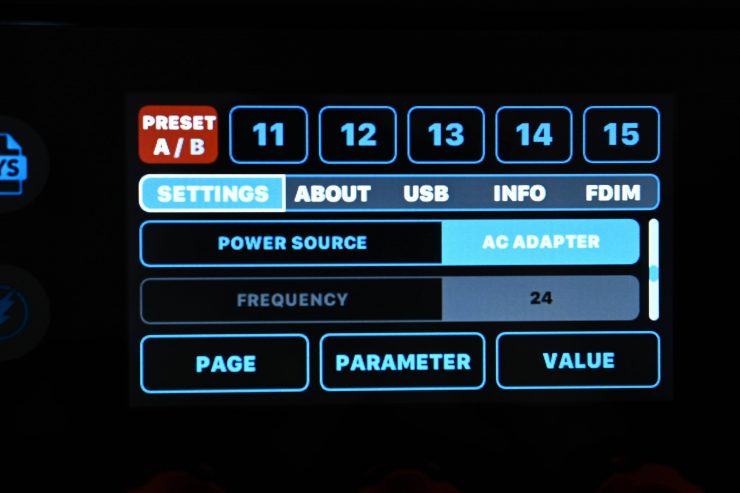
You can choose from 24, 25, 29.97, 50, 60, 100, 120, 240 or 300 and this allows you to select the frame rate you are working in when using the SmartSoft Diffusion.
Brightness Mode
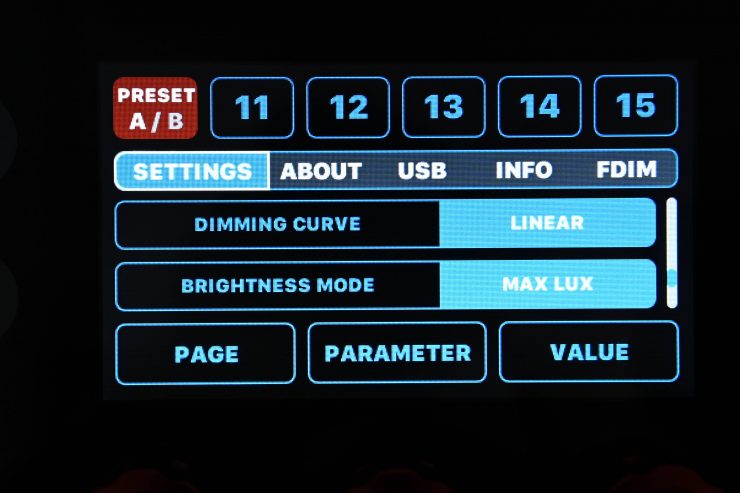
In this menu, you can choose between Max Lux and Constant Lux. In the Max Lux mode, the power output will vary depending on the CCT Kelvin color temperature setting. You will get max output with the Titan X2 when it is used at 4500K. If you choose the Constant Lux mode the output will remain the same regardless of the Kelvin color temperature setting.
FDIM (True Aperture Dimming)
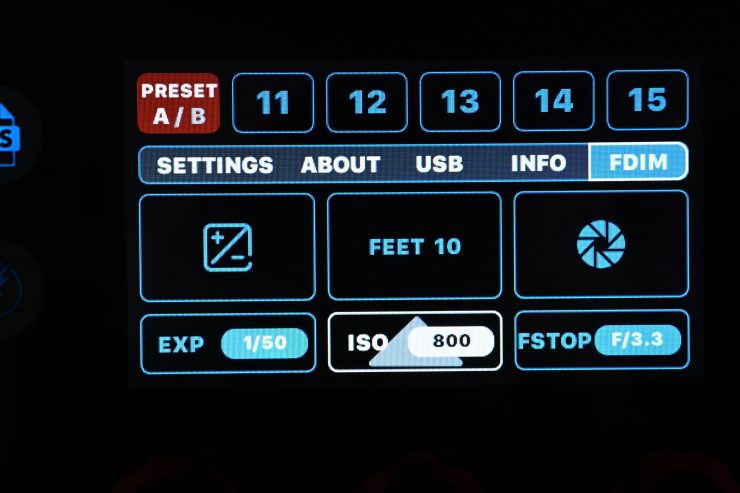
This is a feature that has been in Rotolight fixtures for quite a long time and it is no real surprise that the Titan X2 also gets it.
Basically, True Aperture Dimming is an exposure calculator that sort of works like an alternative light meter. The light can calculate what F-stop (I’m surprised there isn’t an option for T-stop) your camera should be set at a given distance from your subject based on the ISO and shutter speed you are running.
You can also reverse the process and select the F-stop you want to run and then the light will output a certain amount based on your ISO and shutter speed.
This is somewhat useful and while It isn’t full proof, it does give a pretty realistic indication of what F-stop you should be running when the light is set to a certain brightness.
I found this a useful tool to use. It allows me to work out how far away from my subject I need to place a light depending on the F-stop and ISO I want to run. In the future, it would be nice to see an ND tab incorporated so you could also get the light to compensate for those changes too.
Photometrics
So now let’s get to the photometric results. I always test lights in this way so that I get a reference to how they compare to other fixtures. Results only tell part of the story and should never be used alone to judge a light. I have found from extensive testing over the years that certain lights that have good photometric results don’t always look good, and lights that have worse photometric scores can sometimes look better than their results indicate.
Different lights can also look different depending on what camera you happen to be using.
Output & Color Temperature Accuracy
I tested the Titan X2 at a variety of Kelvin color temperatures with a Sekonic C-800 Spectrometer to find out how much output the light had and how accurate the Kelvin color temperature reproduction was. All readings are taken at a distance of 1m (3.28ft) in a controlled environment.
5600K (no SmartSoft diffusion)
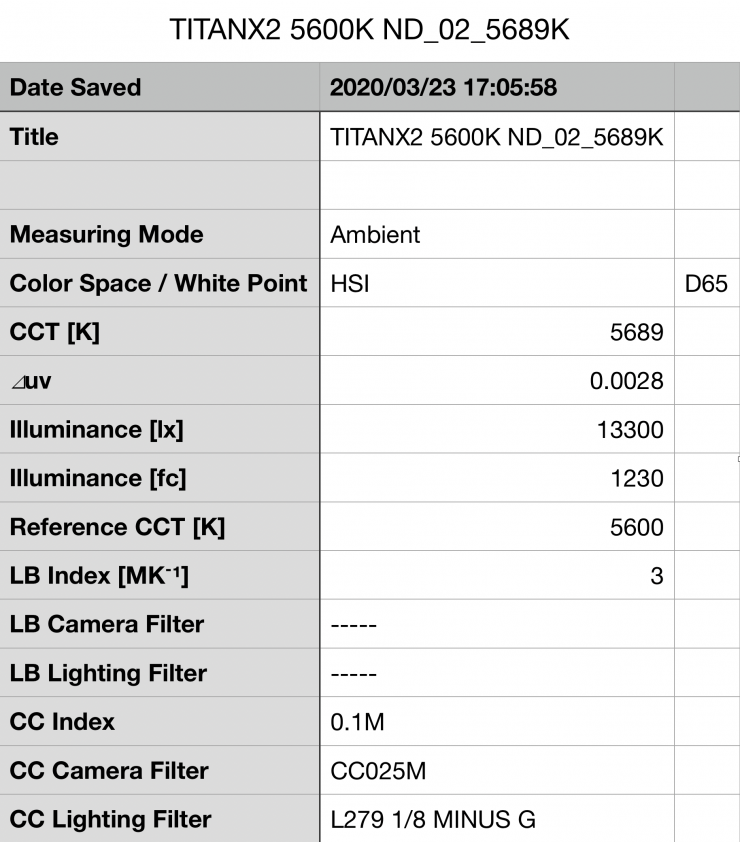
Above you can see the Titan X2 recorded an output of 13300 lx (1230 fc) when set at 5600K and run off mains power. This is quite a bit lower than the 16800 lx that was quoted in the operating manual.
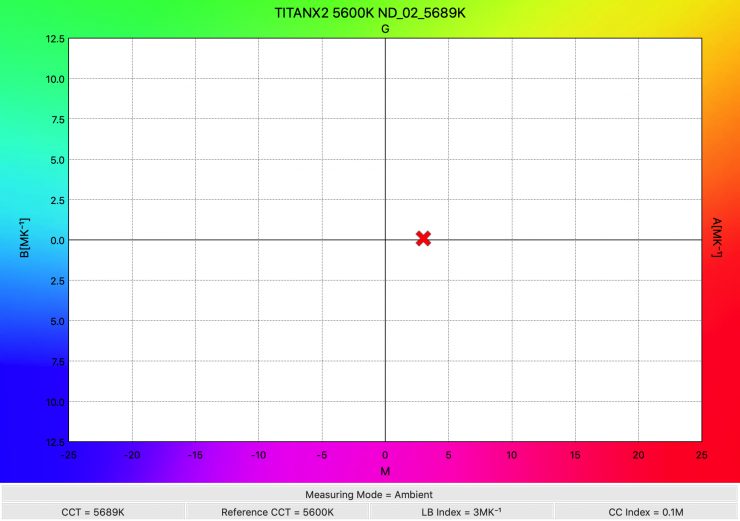
The light recorded a Kelvin color temperature reading of 5689K which was very good.
Now, what you clearly need to remember is that the output you are going to get is going to change depending on the beam angle. With no SmartSoft diffusion, the beam angle is 68 degrees.
| Output at 5600K | |
| 100% SmartSoft Diffusion | 6030 lx (561 fc) |
| 50% SmartSoft Diffusion | 10500 lx (974 fc) |
Above you can see how much output the light had at 5600K when 100% and 50% SmartSoft Diffusion were used. Again these numbers were quite a bit lower than those claimed by Rotolight.
How does this compare to some other 2×1 RGB lights that we have previously reviewed:
| Output at 5600K | |
| Rotolight Titan X2 | 13300 lx (no diffusion) |
| ARRI S60-C SkyPanel | 10900 lx* |
| Litepanels Gemini 2×1 | 9970 lx |
| Rayzr MC MAX 400 | 10400 lx |
* The SkyPanel has an optional intensifier panel available that increases the output to 17,500lx, but this does narrow the beam angle to 74°.
From what I can work out if you use 50% SmartSoft Diffusion the beam angle should be around 110 degrees. So if we compare the Titan X2’s output when 50% SmartSoft Diffusion is being used then the output is very similar to other fixtures that have a similar beam angle.
Just as another reference both the Kino Flo FreeStyle 21 and Kino Flo Diva-lite 20 both put out 2409 lx at 5600K.
As far as an accurate rendition of creating a 5600K source here is how some of the other 2×1 RGB lights that we have previously reviewed fare:
| Kelvin Color Temperature (when set at 5600K) | |
| Rotolight Titan X2 | 5689K 0.1M |
| ARRI S60-C SkyPanel | 5708K 0 CC |
| Litepanels Gemini 2×1 | 5460K 0 CC |
| Rayzr MC MAX 400 | 5621K 0.4M |
All of these lights that I have reviewed have pretty accurate Kelvin color reproduction at 5600K.
3200K (no diffusion)
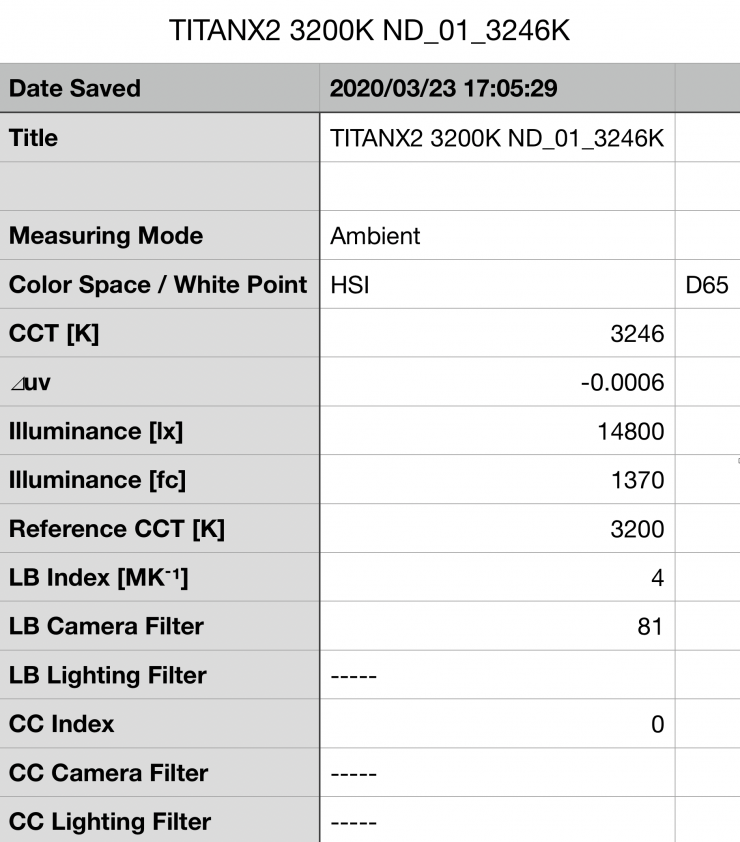
Above you can see the lights output when it was set at 3200K with no diffusion. It produced 14800 lx (1370 fc), which is 11.28% more than the 13300 lx it produced at 5600K.
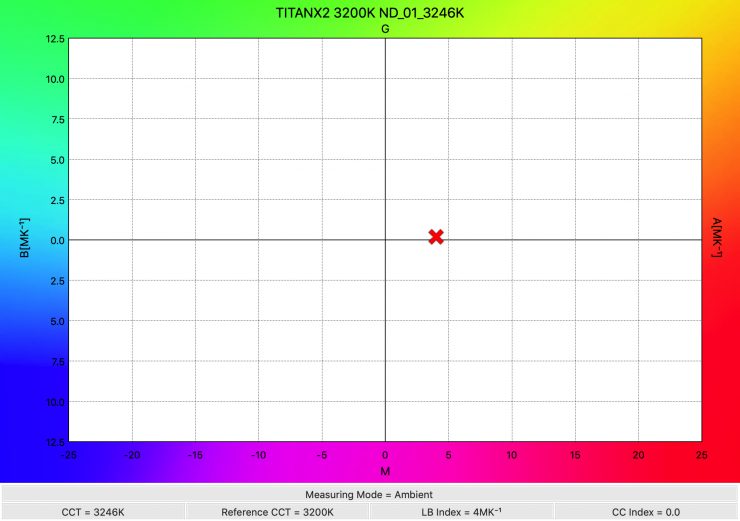
As far as Kelvin color temperature accuracy goes, it recorded a very accurate reading of 3246K.
| Output at 3200K | |
| 100% SmartSoft Diffusion | 8920 lx (829 fc) |
| 50% SmartSoft Diffusion | 13500 lx (1250 fc) |
Above you can see how much output the light had at 3200K when 100% and 50% SmartSoft Diffusion were used. These numbers were quite a bit higher than those claimed by Rotolight.
How does this compare to some other 2×1 RGB lights that we have previously reviewed:
| Output at 3200K | |
| Rotolight Titan X2 | 14800 lx (no diffusion) |
| ARRI S60-C SkyPanel | 10400 lx* |
| Litepanels Gemini 2×1 | 8970 lx |
| Rayzr MC MAX 400 | 8540 lx |
*The SkyPanel has an optional intensifier panel available that increases the output but narrows the beam angle to 74°.
So if we compare the Titan X2’s output when 50% SmartSoft Diffusion is used then the output is quite a bit higher than fixtures that have a similar beam angle.
Just as another reference both the Kino Flo FreeStyle 21 and Kino Flo Diva-lite 20 both put out 2409 lx at 3200K.
As far as an accurate rendition of creating a 3200K source here is how some of the other 2×1 RGB lights that we have previously reviewed fare:
| Kelvin Color Temperature (when set at 3200K) | |
| Rotolight Titan X2 | 3246K |
| ARRI S60-C SkyPanel | 3225K 0.1M |
| Litepanels Gemini 2×1 | 3249K 0.4M |
| Rayzr MC MAX 400 | 3300K 0.5M |
Just like at 5600K, all of these lights produce accurate Kelvin color temperature when set at 3200K.
+/- Green adjustment
Now, as all of the fixtures include +/- Green adjustment you can quite easily correct any tint. While there is no exact science to this, and it really depends on what camera you are using as well, it’s just a matter of trial and error to see what setting actually works the best. The nice thing is, any light with +/- Green adjustment can be fine-tuned to deliver better results.
How does it perform at various Kelvin color temperatures?
Summary of results (no diffusion)
| OUTPUT | KELVIN COLOR TEMPERATURE READING | |
| 3000K | 13400 lx | 3041K |
| 3200K | 14800 lx | 3246K |
| 4500K | 18000 lx | 4566K 0.1M |
| 5600K | 13300 lx | 5698K 0.1M |
| 6500K | 11700 lx | 6636K |
| 8000K | 12500 lx | 8089K |
| 10000K | 12500 lx | 9965K |
These results show me that the lights output is fairly consistent at most Kelvin color temperatures, but it has by far the most output when used at 4500K.
The results also show me that the light is very accurate when it comes to Kelvin color temperature reproduction throughout its range. It doesn’t matter what Kelvin color temperature you run, the Titan X2 is very good throughout its 3000-10000K range.
The consistency of the Titan X2, is to me, one of its most impressive attributes.
RGB Output
With most RGB lights if you use them to generate or create colors the output gets massively reduced. So how does the Titan X2 fare?
I decided to do a test to see how much output the light had when I created a super-saturated color.
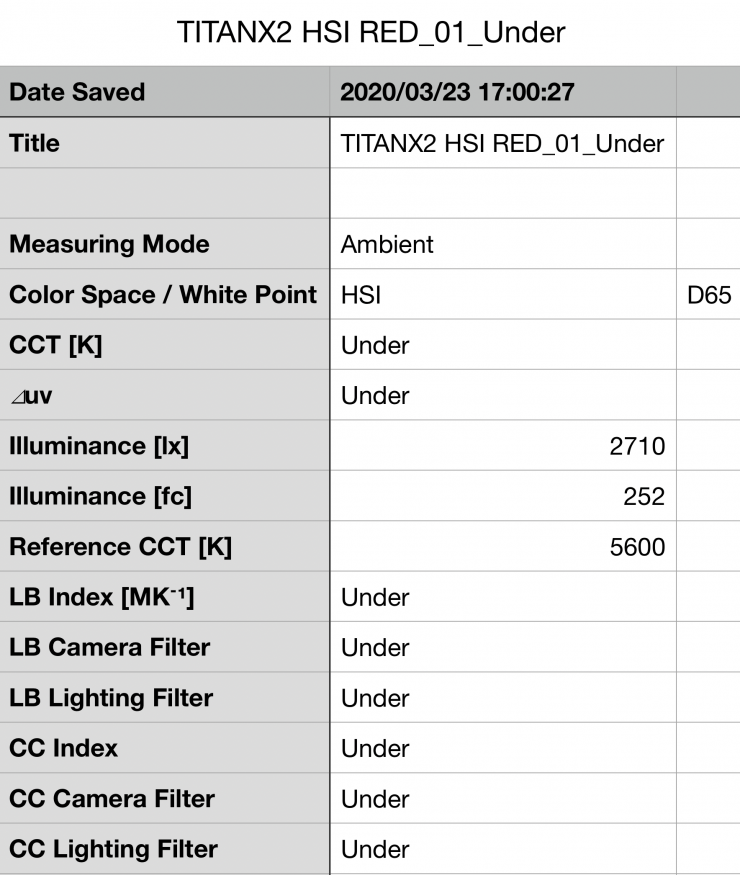
Above you can see that when it was in the HSI mode, choosing a saturated red, and set to 100% output, the light recorded 2710 lx. This is something you need to be clearly aware of when using RGB and HSI modes. The output is going to be significantly lower than when using the light in CCT mode.
Color Rendering
5600K
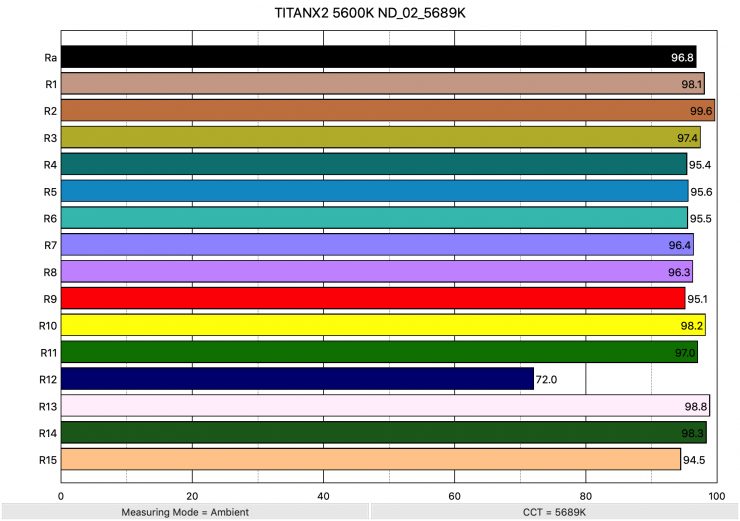
So now that we have seen how much output the Titan X2 produces, how does it perform when it comes to replicating accurate colors. Above you can see that when the light was set at 5600K it recorded an average CRI (R1-R8) of 96.8 and an extended CRI (R1-R15) of 95.21. For replicating accurate skin tones it recorded for R9 95.1 (red), 98.8 for R13 (closest to caucasian skin tones), and 94.5 for R15 (closest to Asian skin tones). These are very good results.
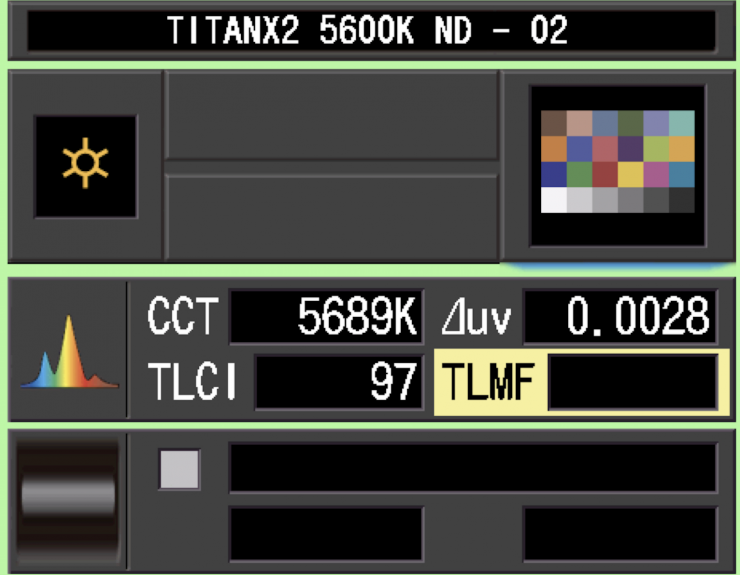
The light, when set at 5600K, recorded a TLCI score of 97.
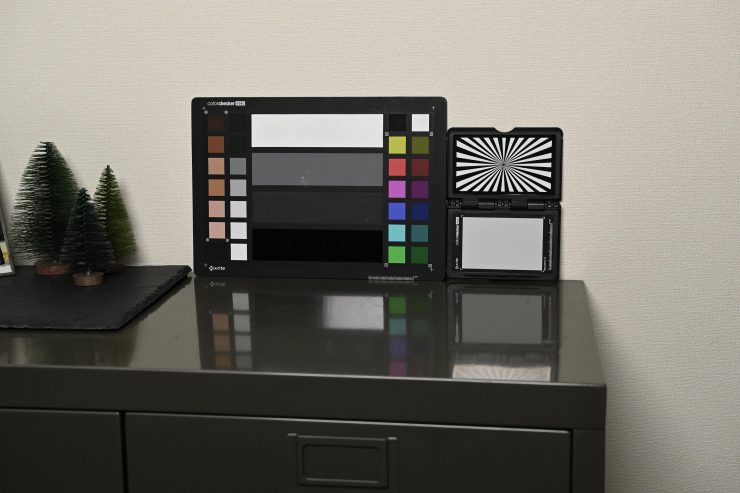

5600K Preset WB 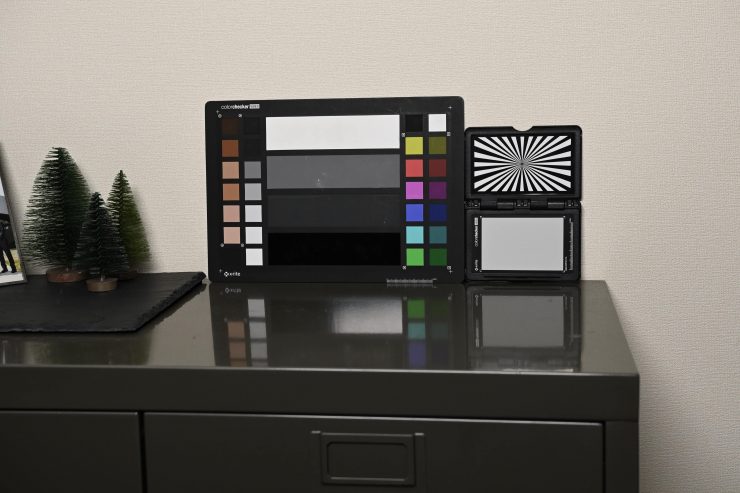
WB done
Above you can see color checker charts that have been shot with the light at 5600K. The first is with a preset 5600K WB being used, and the second is with a WB done. As you can see the Titan X2 produces very accurate light at 5600K. There is only a very slight difference between using a preset 5600K WB on the camera and then doing a WB.
How does this compare to some other 2×1 RGB lights that we have previously reviewed when used at 5600K? Below you can see:
| Average CRI | Extended CRI | |
| Rotolight Titan X2 | 96.8 | 95.21 |
| ARRI SkyPanel S60-C | 95.7 | 92.92 |
| Litepanels Gemini 2×1 | 95.2 | 93.24 |
| Rayzr MC MAX 400 | 95.3 | 92.96 |
All of these lights perform well at 5600K, but the Rotolight recorded the highest scores.
3200K
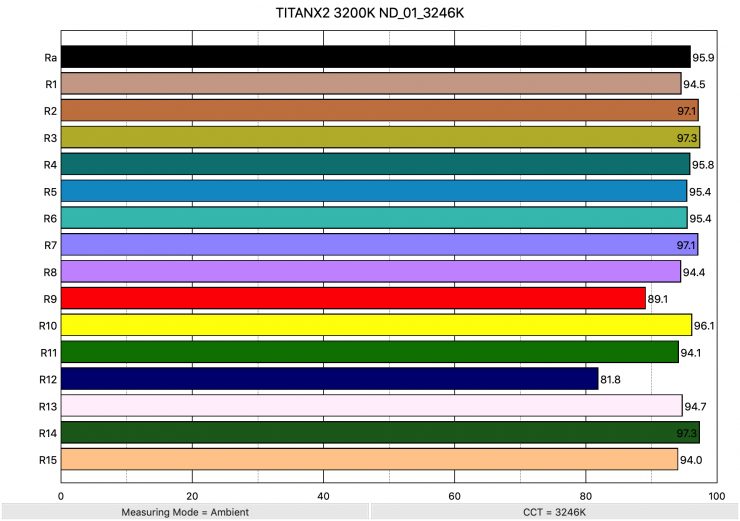
Above you can see the scores for when the light was used at 3200K. It recorded an average CRI (R1-R8) of 95.9 and an extended CRI (R1-R15) of 94.27. For replicating accurate skin tones it recorded 89.1 for R9 (red), 94.7 for R13 (closest to caucasian skin tones), and 94 for R15 (closest to Asian skin tones).
These results were almost as good as when the light is used at 5600K.
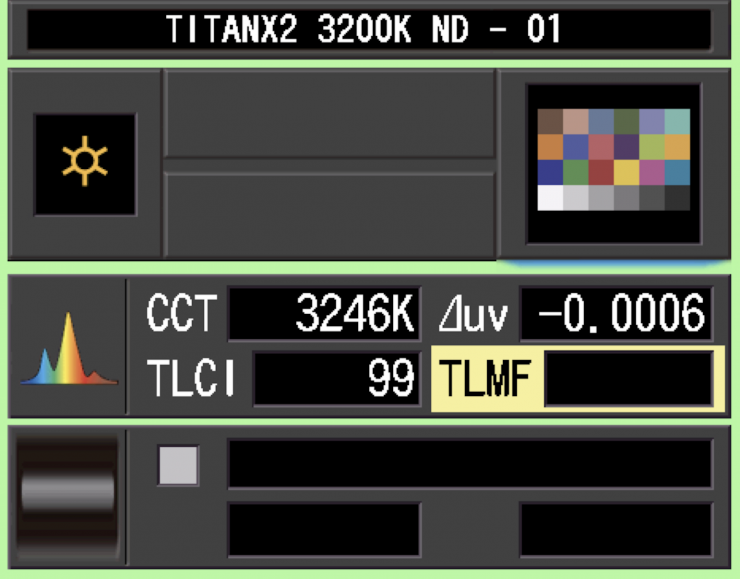
The light, when set at 3200K, recorded a TLCI score of 99.
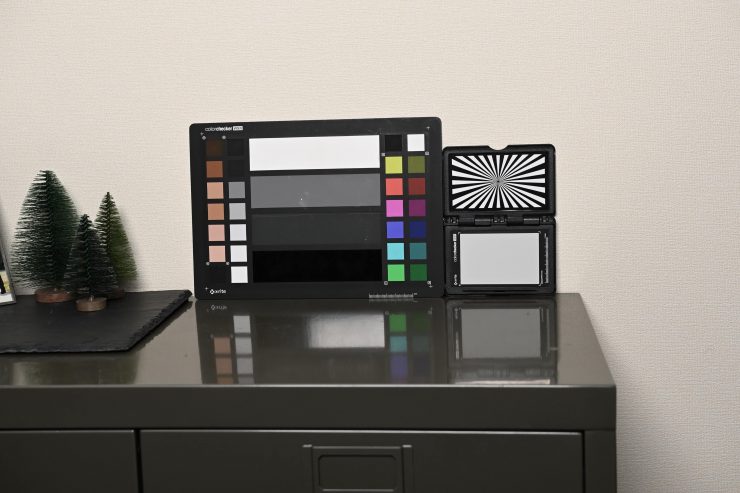

Preset 3200K WB 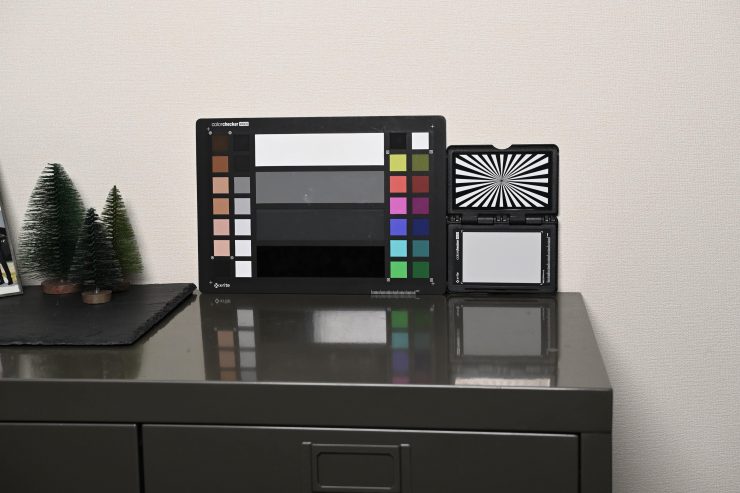
WB done
Above you can see color checker charts that have been shot with the light at 3200K. The first is with a preset 3200K WB being used, and the second is with a WB done. As you can see the Titan X2 produces pretty accurate light at 3200K. There is only a slight difference between using a preset 3200K WB on the camera and then doing a WB.
How does this compare to some other 2×1 RGB lights that we have previously reviewed when used at 3200K? Below you can see:
| Average CRI | Extended CRI | |
| Rotolight Titan X2 | 95.9 | 94.27 |
| ARRI SkyPanel S60-C | 96.1 | 94.06 |
| Litepanels Gemini 2×1 | 97.2 | 95.3 |
| Rayzr MC MAX 400 | 90.6 | 88.64 |
The Rotolight, Litepanels and ARRI fixtures are all very close when it comes to color rendering scores. The Litepanels Gemini 2×1 had a slight edge over the ARRI and Rotolight at 3200K, but it is very marginal.
Thoughts
It wasn’t a huge surprise that the Rotolight Titan X2 scored well in these color rendering tests. It is a brand new light, utilizing the latest technology. However, it is still impressive that the SkyPanel S60-C that was announced almost 5 years ago and the Litepanels Gemini 2×1 was announced back in September 2017 have scores that are fairly similar.
It is also important to note that the ARRI SkyPanels don’t score particularly well in photometric tests. So why do so many productions still use them? Well, one of the main reasons is that they are mapped to work well with ARRI cameras.
What you clearly need to understand, and I want to continue to stress this point, is that all lights react differently to different camera and sensor combinations. One particular light may look better with an ARRI camera, and another light may look better with a Canon camera, etc.
SSI
SSI (Spectral Similarity Index) was developed by the Sci-Tech Council of the Academy. SSI gives me the ability to set any light as a standard, or use predefined standards (such as CIE D55), and then give other lights an SSI score based upon how well they will match standards such as CIE D55. This way I can measure spectral response and compare it directly against an ideal light source. This is actually a much better test than recording CRI scores.
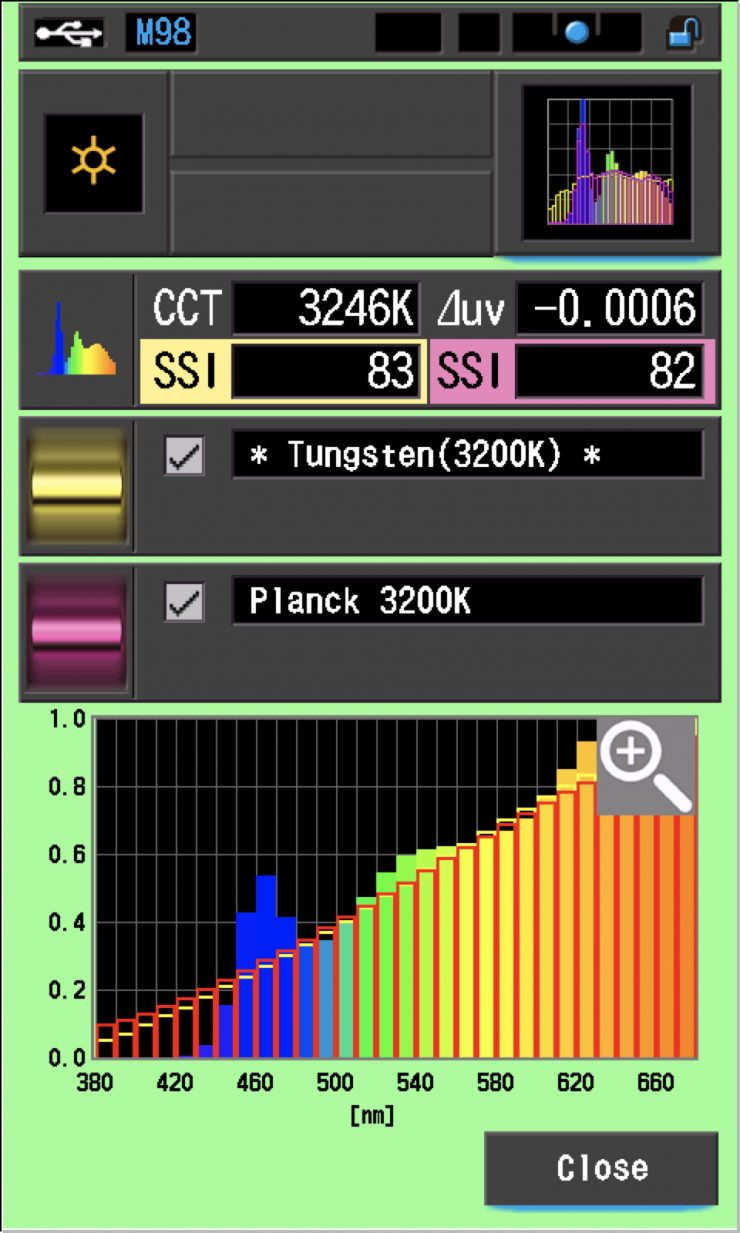
In this graph, the red bars indicate a perfect Planck 3200K source. The gold bars indicate a perfect 3200K Tungsten source. This lets us compare how close to a perfect 3200K lighting source the Titan X2 is. Any SSI score in the ’80s is very good for a 3200K LED light. As you can see, LED lights have a hard time replicating colors below about 450nm.
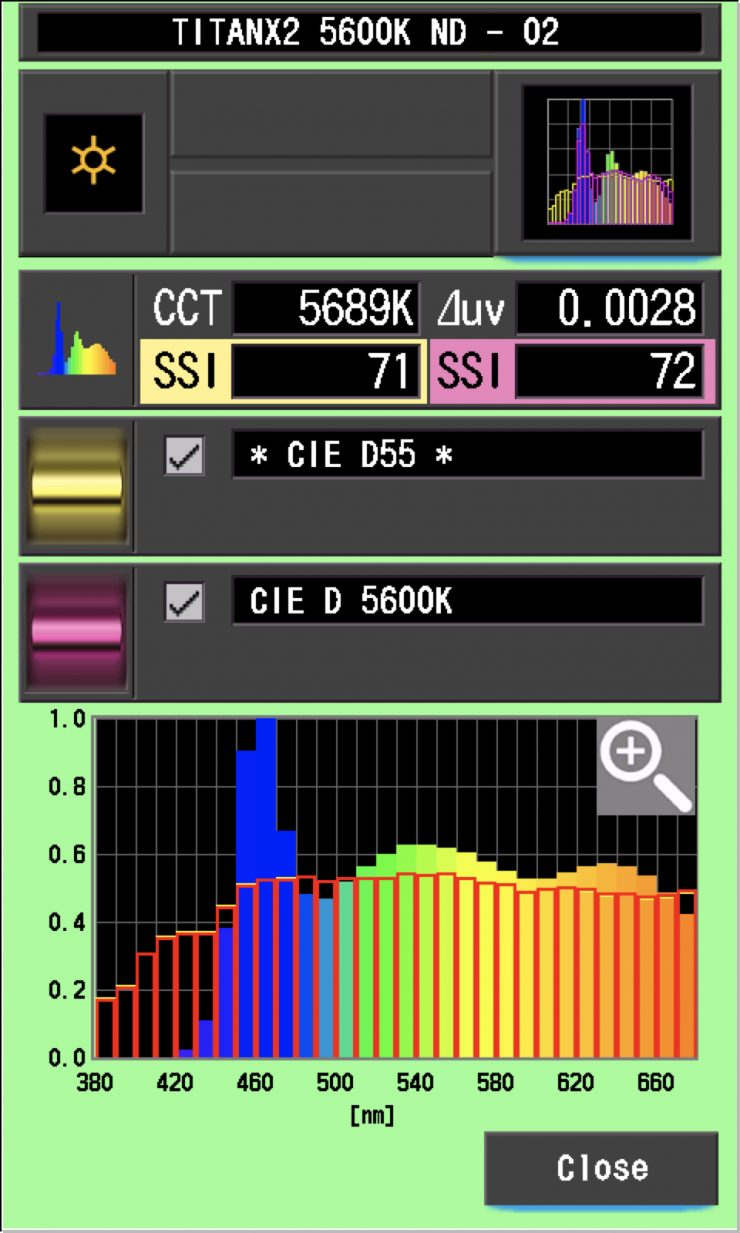
In the graph above the gold bars indicate a perfect CIE D55 source. The red bars indicate a perfect CIE D 5600K source. This lets us compare how close to a perfect 5600K lighting source the Titan X2 is. A score in the low 70’s is typical for a 5600K LED source.
The main reason we want to record SSI scores is so we can see how well they match with other lights. As a test, I was curious to see how well the Rotolight Titan X2 matched a Rayzr MC400 MAX and a Lupo Actionpanel Full Color. Below you can see the results.
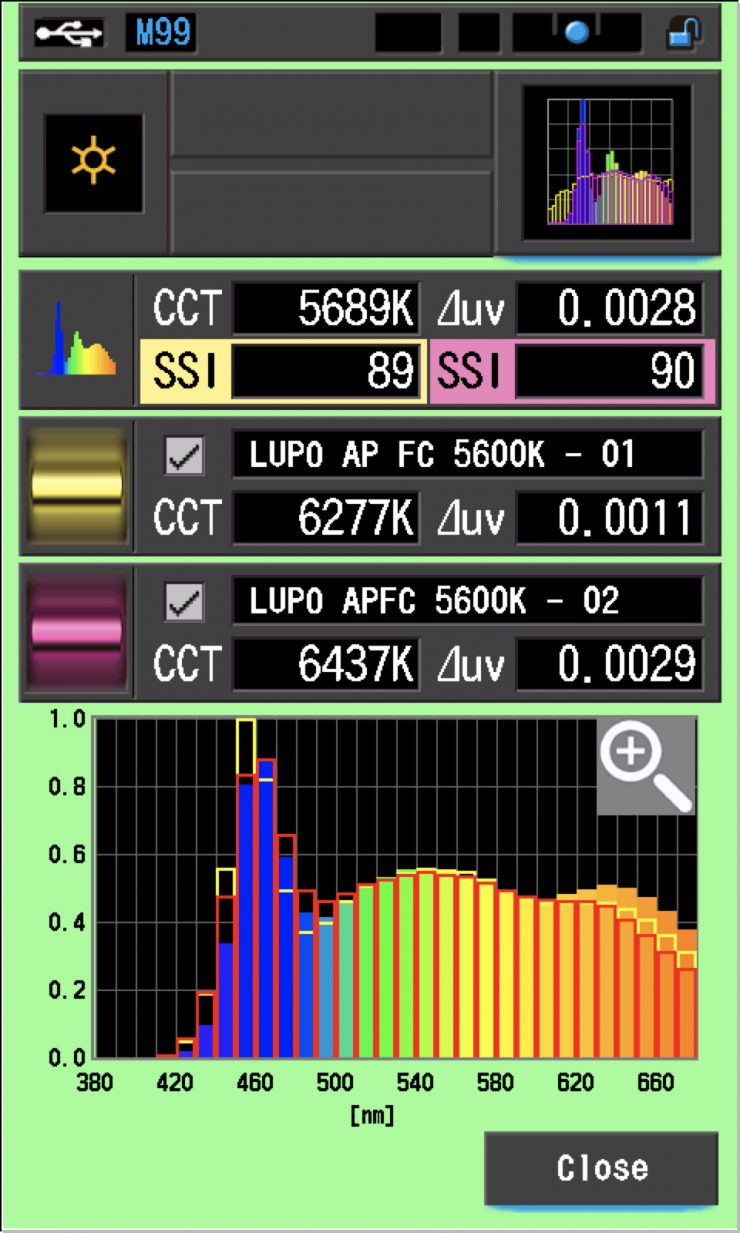
As you can see the Rayzr and the Lupo are not a perfect match to the Titan X2 and you would need to fine-tune the lights to try and get them to match more closely. In saying that, a score of 89/90 is still reasonably good.
Just as another test I thought I would look and see if there were any differences when using the Titan X2 with 50% SmartSoft Diffusion and 100% SmartSoft Diffusion as opposed to no diffusion. In theory, the SSI results should give me a perfect match.
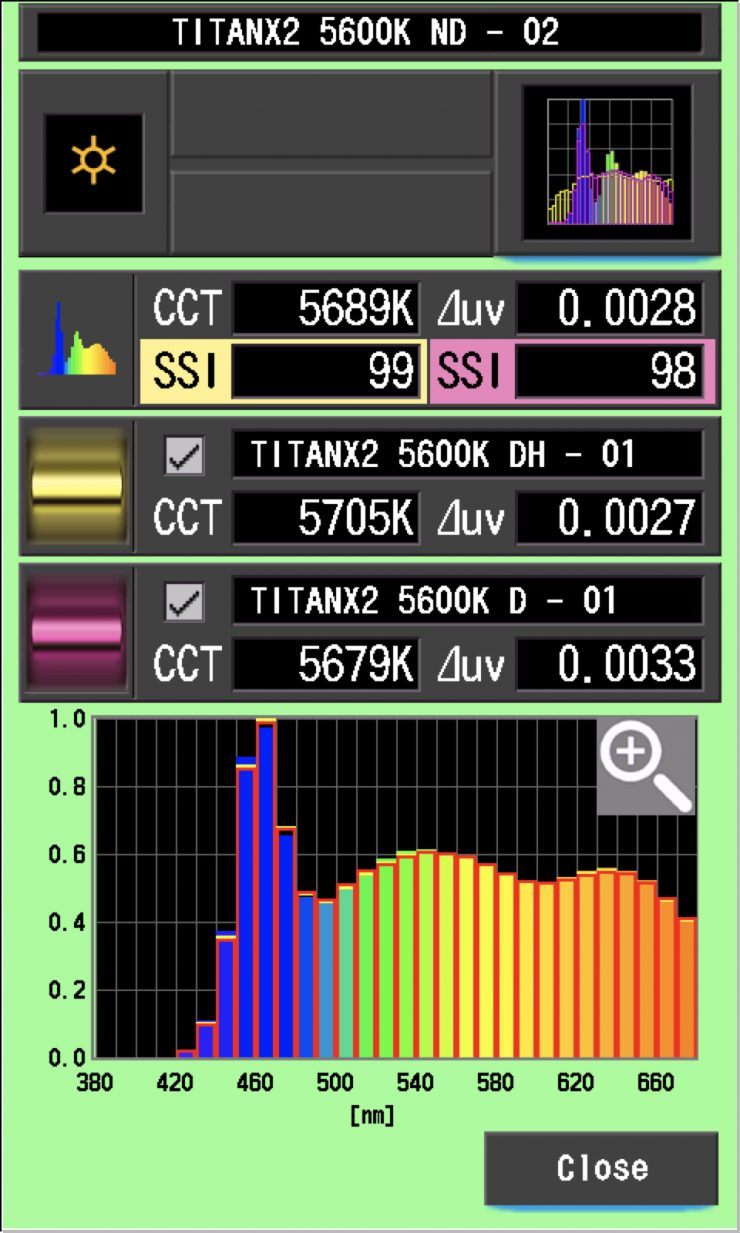
As you can see, when using the SmartSoft Diffusion at 50% or 100% the results are almost identical. This shows me that the SmartSoft Diffusion isn’t changing the lights spectral response in any noticeable way. This is impressive to see.
SSI tests are a great way of telling you what lights you own or use will work well together.
Spectral Distribution
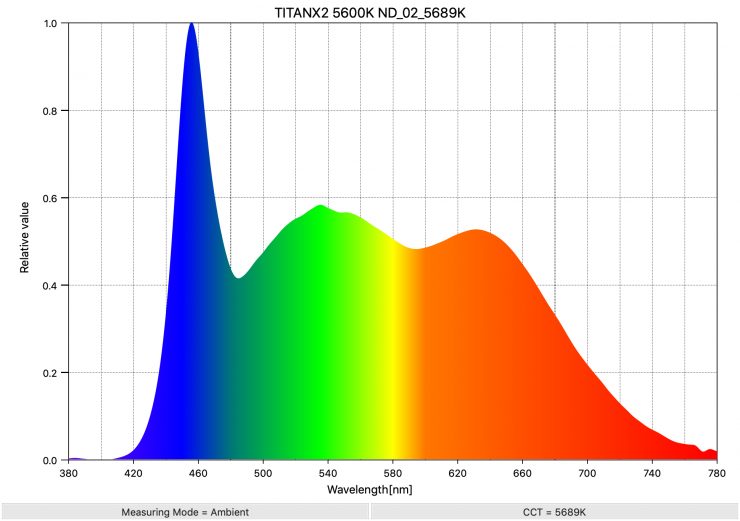
Above you can see the spectral distribution of the Titan X2 when it is set at 5600K. The spectral distribution is reasonably full and there aren’t any big spikes.
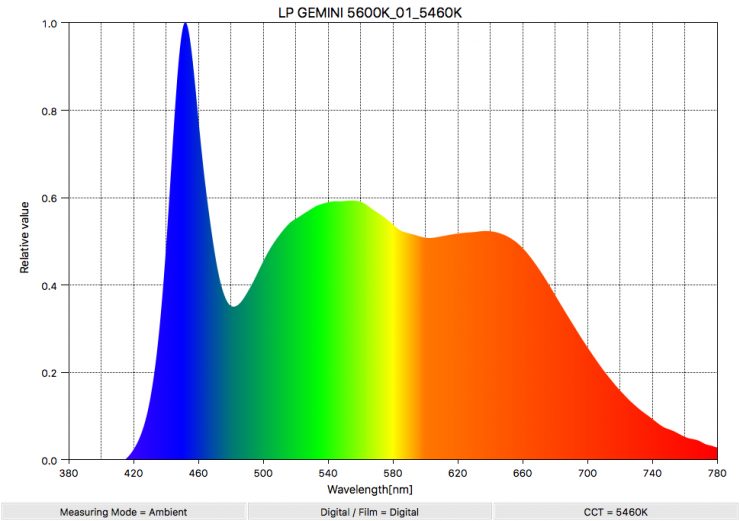
As a comparison, above you can see the spectral distribution of the Litepanels Gemini 2×1 when it is set at 5600K. The spectral distribution is very similar to the Rotolight Titan X2.
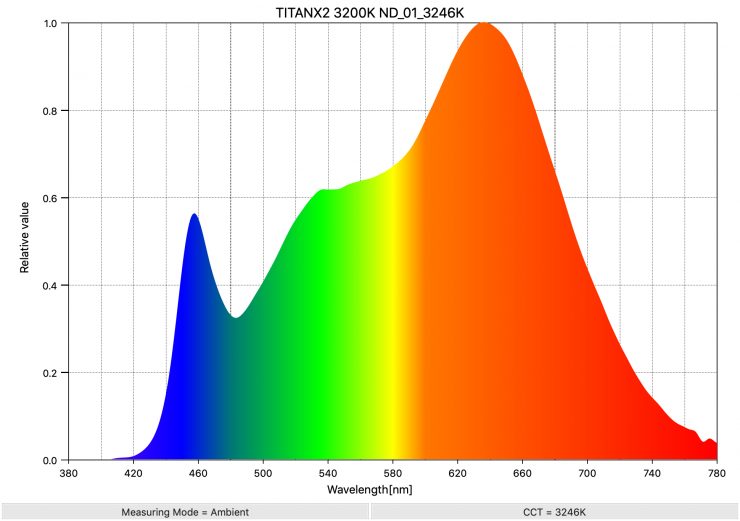
Above you can see the spectral distribution of the Titan X2 when it is set at 3200K. The spectral distribution certainly has a slight push towards green and it’s also missing some color information in parts of the spectrum. Although, with +/- Green adjustment you could easily correct this.
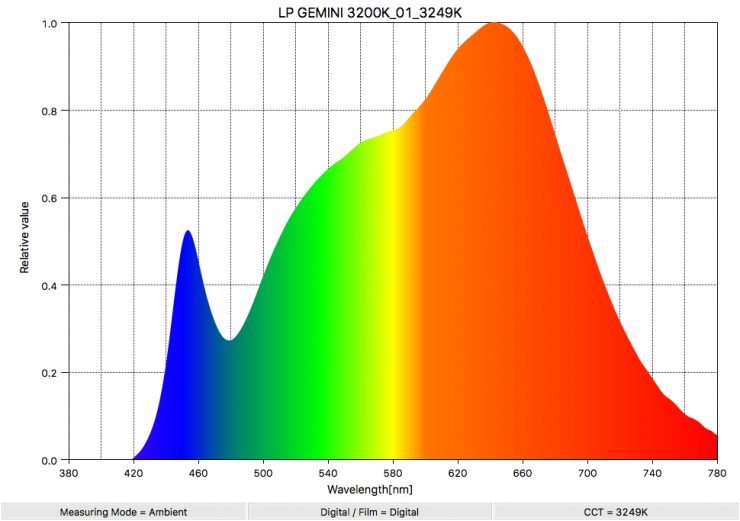
Again as a comparison, above you can see the spectral distribution of the Litepanels Gemini 2×1 when it is set at 3200K. As you can see, the Litepanels has a fuller spectrum when used at 3200K.
Real-World Performance & Quality of Light
As I always say, photometric scores only tell you part of the story. So do the scores from the Titan X2 translate into real-world performance? The simple answer is yes. The quality of the light that is coming from the Titan X2 is amongst the best I have seen. The photometric data can only give me scientific data and it is much more important for me to see how the light looks and performs, especially with skin tones.
Unfortunately, it is very hard at the moment with the Coronavirus for me to showcase the strengths of the light. I live in Japan in an apartment so there isn’t a lot of space to do much with a large 2×1 fixture. I have still tried to do as much as possible, I apologize that I can’t do more!
It is very easy to create a very soft, flattering light source using the Titan X2. I found that by using a combination of the SmartSoft diffusion and a DOP Choice softbox I could create a very soft lighting source without needing to punch it through a diffusion screen. This makes it a very quick and easy light to use for interview situations or for any scenario where you need soft light.
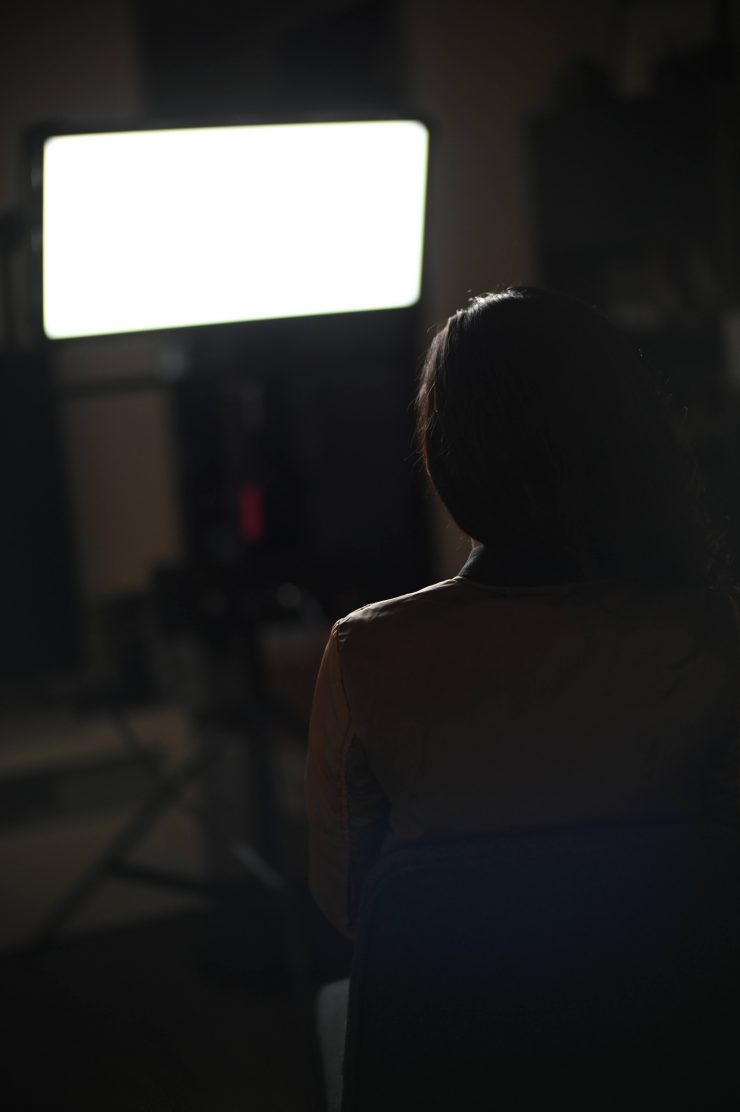
Above you can see what the light looks like without any softbox or diffusion being used.
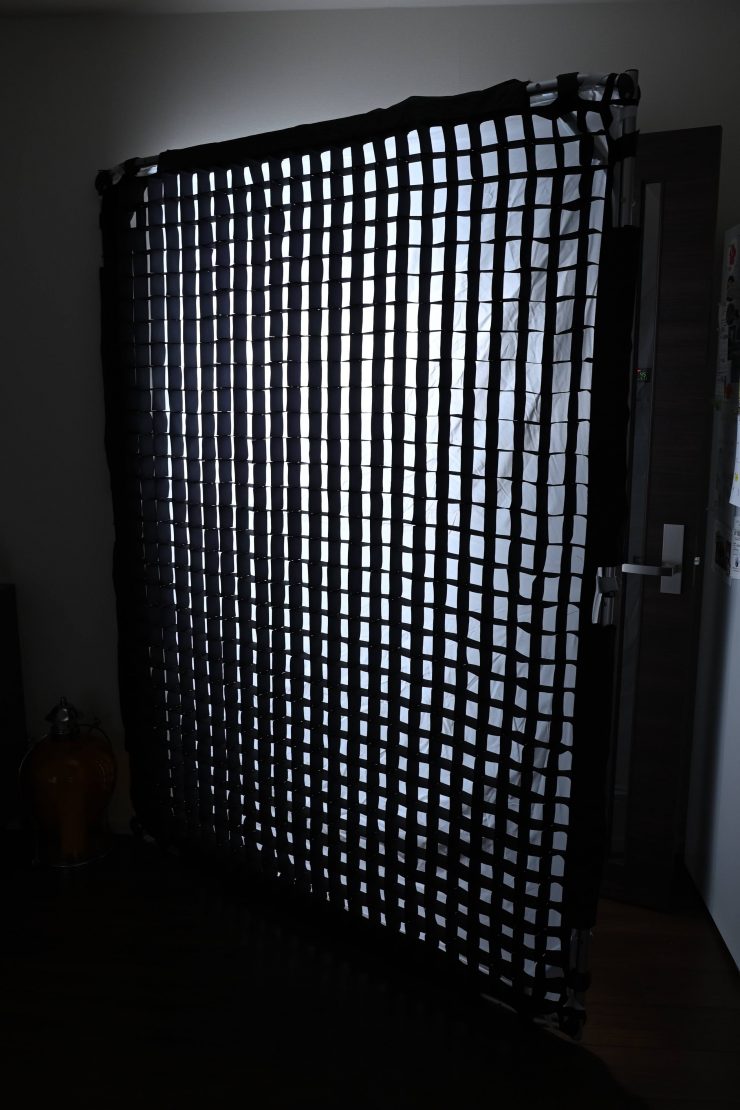
It also works well when you punch the light through a large diffusion screen.

Above you can see a few frames where the Titan X2 is using 100% SmartSoft diffusion, a DOPChoice softbox, and being punched through a diffusion screen with a honeycomb grid.

Above you can also see what the light looks like when it is used indirectly and bounced into a silver scrim. There are no backlights, or fill lights being used here.
Conversely, If you don’t use any SmartSoft diffusion you can create a much stronger and more direct light. It is this versatility that makes the Titan X2 stand out from its competition.
The ability to alter the beam angle drastically certainly makes it a very versatile fixture. You can use it with less SmartSoft Diffusion dialed in to directly bounce light into a ceiling, wall, or even a poly board and it can create a nice indirect lighting source. Conversely, you can dial in more SmartSoft Diffusion and spread the beam angle out and use the light through extra diffusion to create a very soft source.


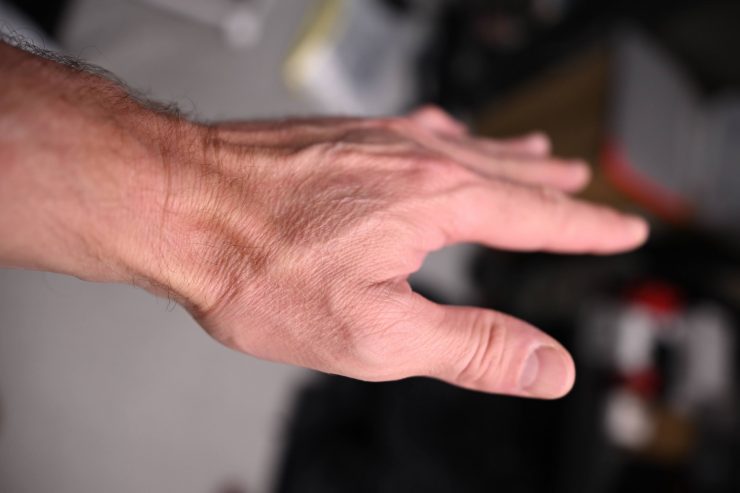
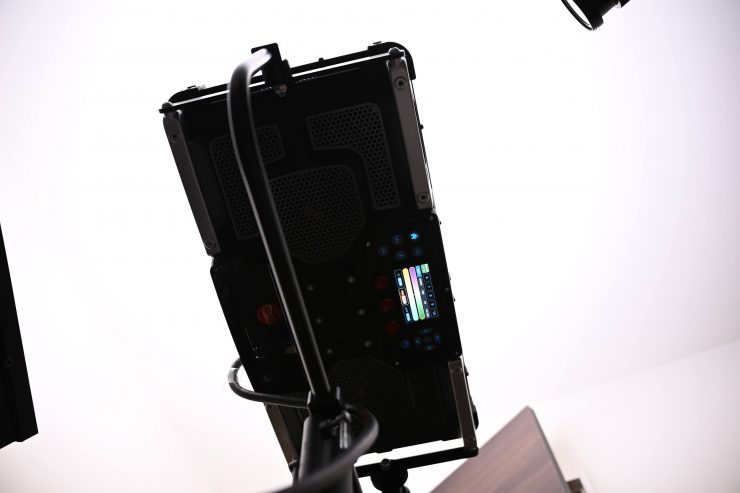
The light being bounced straight into the ceiling
I even found that you could create very soft, even light by bouncing the Titan X2 directly into a white ceiling with the SmartSoft diffusion at 100%. Above you can see a couple of frames I took where the little robot and my hand are around 3 feet to the left of the light. The light coming off the ceiling is around 6′ from the robot and my hand.

Just to show you how even the light is and how soft the shadows are I positioned my hand above the robot and moved it down. I had to get my hand very close to the robot to start creating any sort of shadow and even then it was a soft shadow. What you need to remember is this is all from one light being bounced directly into a ceiling. There are no other lights being used and no other ambient light in the room.
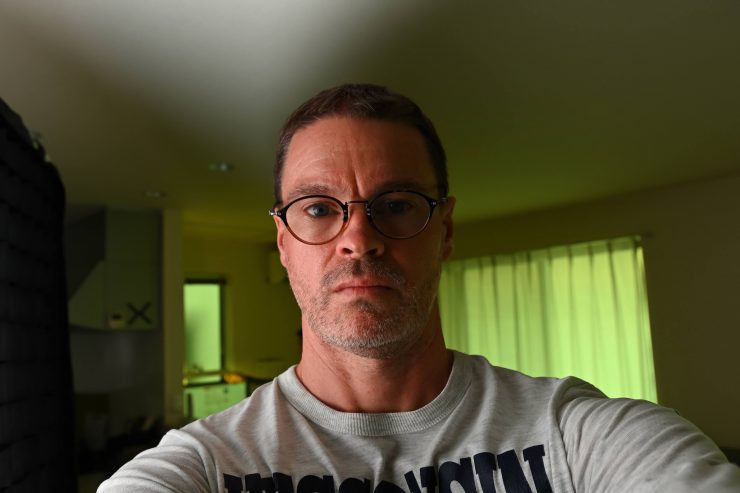
I also liked experimenting with the light, especially by using some of the in-built library of filters. By choosing a filter and then balancing your camera to that light, you can create some interesting looks because your background lighting sources take on different color tones. Apologies for having to look at my ugly mug above!
The Titan X2 is a very versatile lighting tool that combines functionality, useful features, great usability, a good amount of output, all without effecting color accuracy. Too often I have seen lights where they have concentrated too much on features and gimmicks which have come at the expense of the quality of light. With the Titan X2, Rotolight has managed to produce a light that doesn’t compromise on anything.
While there are a lot of features in the Titan X2, there is a good proportion of users that may never find themselves actually using some of them, but they are nice to have at your disposal. The key features for me are the CCT Mode (Correlated Color Temperature) where you can add or subtract green, the True Aperture Dimming, and the SmartSoft Diffusion. These are the three real-world features that will be the most commonly used. In saying that, I am starting to use RGB and HSI quite a lot more.
I’m really looking forward to testing out the new firmware that will let you tell the light what camera sensor you are using, and in turn, the light will go into a mode that best matches that sensor’s color response. If this actually works it will be a big deal and a major step forward in creating lighting sources that match cameras.
How does it compare to the competition?
I don’t have access to all of the lights I have been comparing the Titan X2 to, but I can compare it head-to-head against the Litepanels Gemini and the Rayzr MC400 MAX.
Head-to-head comparisons are hard to do because different cameras have different sensors and the color response is different from camera to camera. One light may look better with a certain camera than another.
I am going to just do a couple of head-to-head examples looking at the following:
- Color Reproduction– how accurate are the lights at 3200K and 5600K when no WB is done and when a camera WB is done.
- Skin Tones- how do the lights look at 3200K and 5600K when no WB is done and when a camera WB is done.
Color Reproduction
So, let’s compare the color rendition of all of the lights when used at 3200K and 5600K when a preset WB is used in camera and when a WB has been done.
For these tests, I have kept the exposure, ISO, and shutter speed the same. I used a 3200K and 5600K preset WB and then WB balanced the camera using an 18% grey card.
3200K (Preset WB)
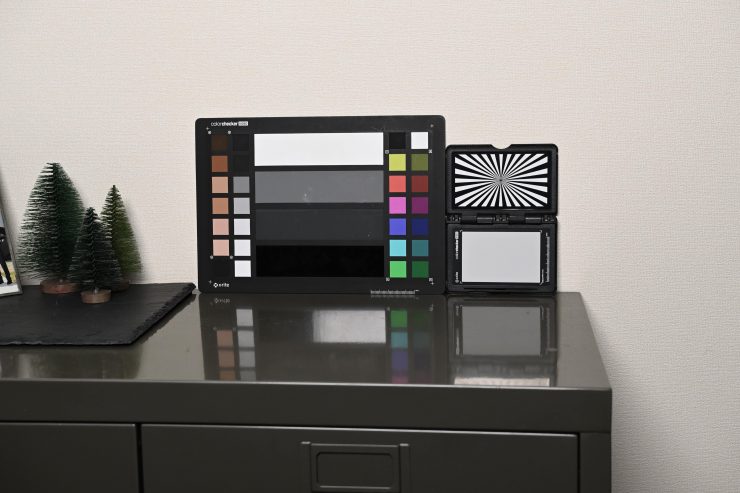

Rotolight Titan X2 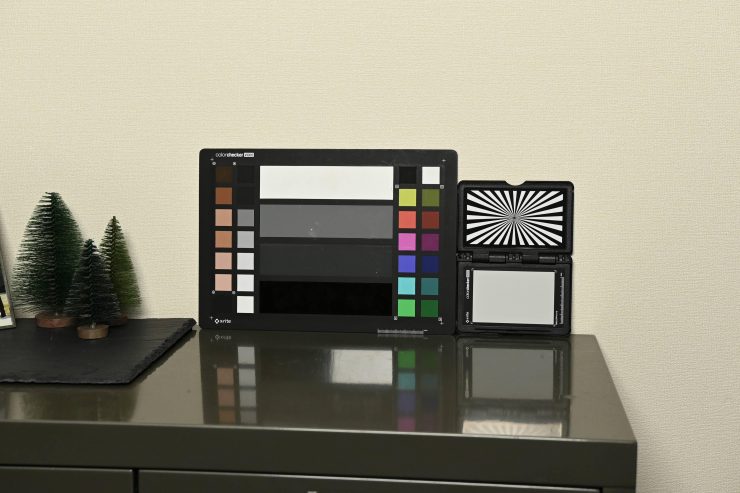
Litepanels Gemini 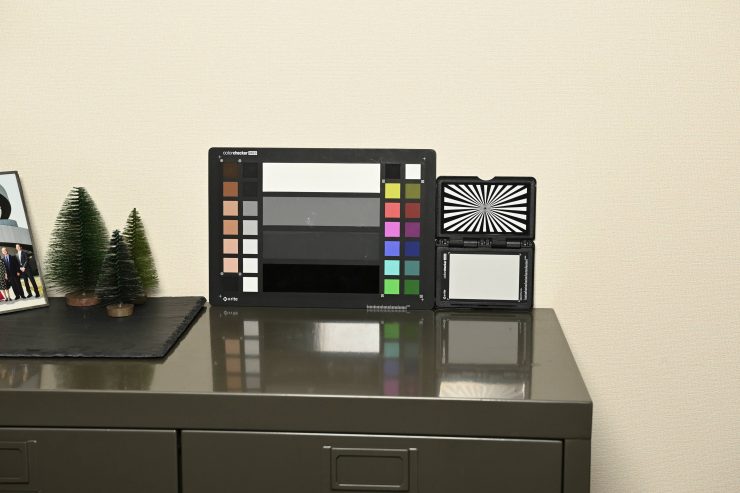
Rayzr MC400 MAX
As you can see, the Litepanels Gemini and Rayzr MC400 MAX both skew towards green if no WB is done. The Titan X2 is far more neutral.
3200K (WB Done)


Rotolight Titan X2 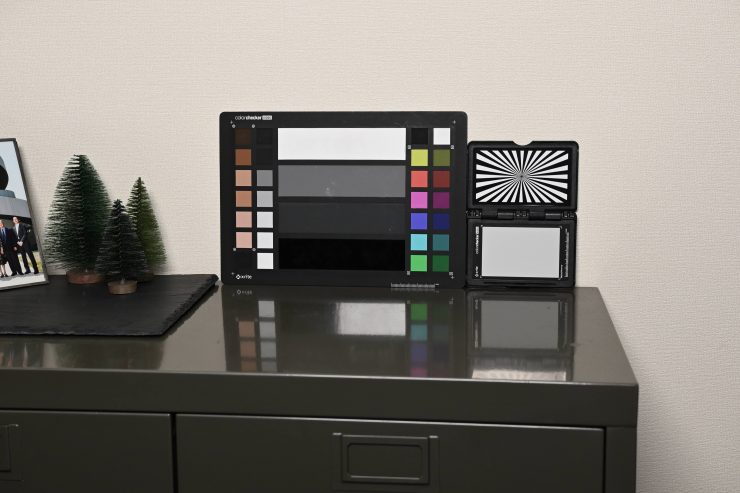
Litepanels Gemini 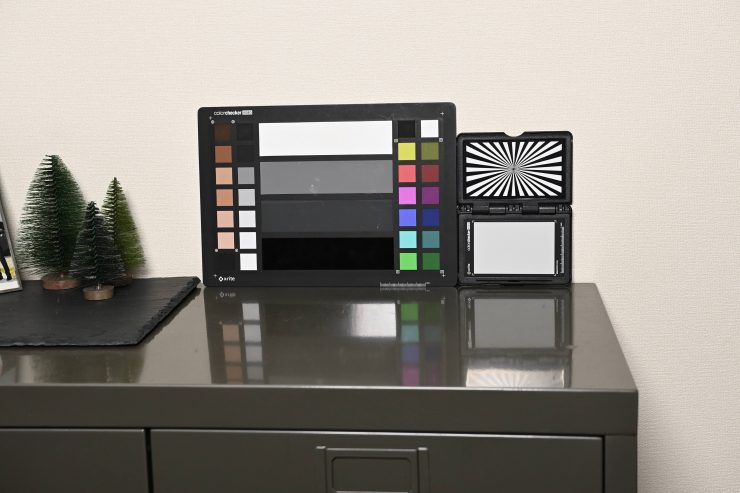
Rayzr MC400 MAX
As you can see, all the lights are very neutral once a WB has been done. The Rayzr perhaps has a slight push towards magenta compared to the other three lights, but it is fairly minimal. You would struggle to see any real-world difference between these lights if you do a WB.
5600K (Preset WB)


Rotolight Titan X2 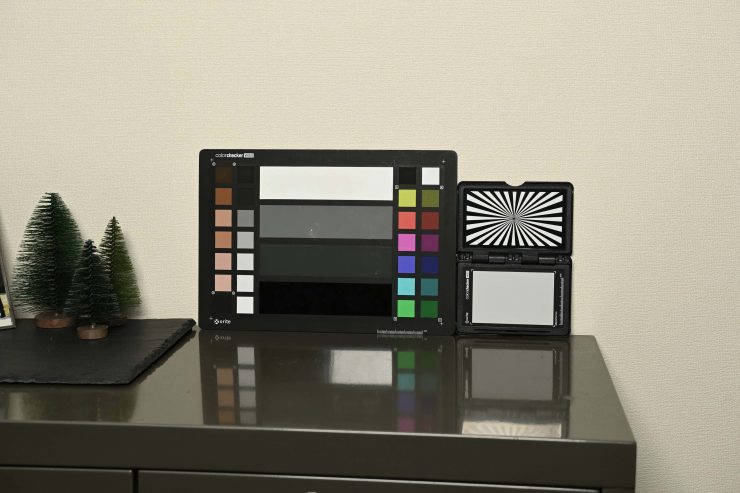
Litepanels Gemini 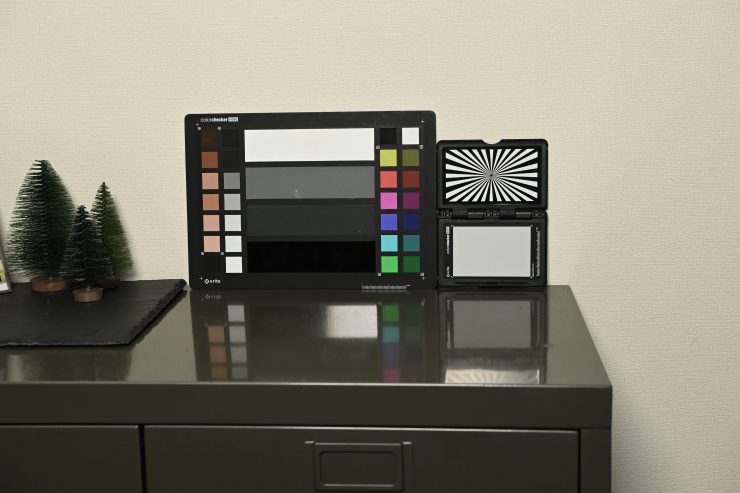
Rayzr MC400 MAX
As you can see, just like at 3200K, the Litepanels Gemini and Rayzr MC400 MAX both skew towards green if no WB is done. The Rotolight Titan X2 is a lot more neutral.
5600K (WB Done)
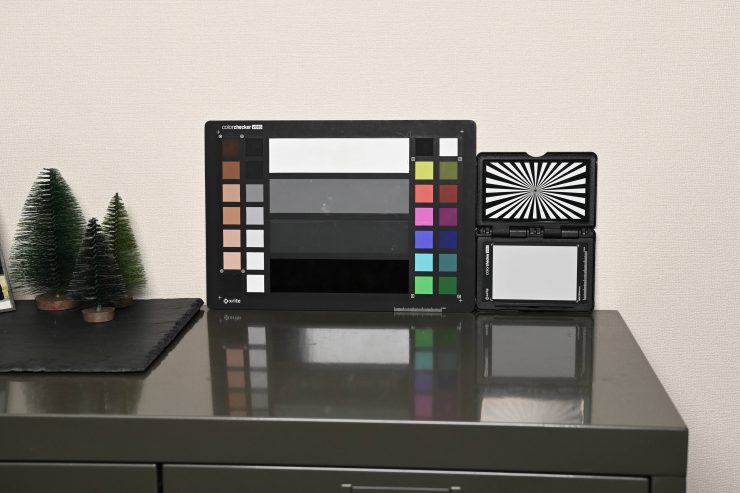

Luxli Taiko 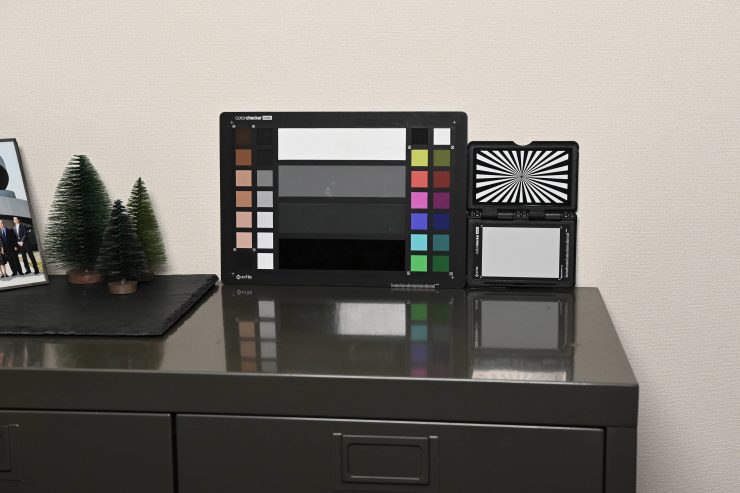
Litepanels Gemini 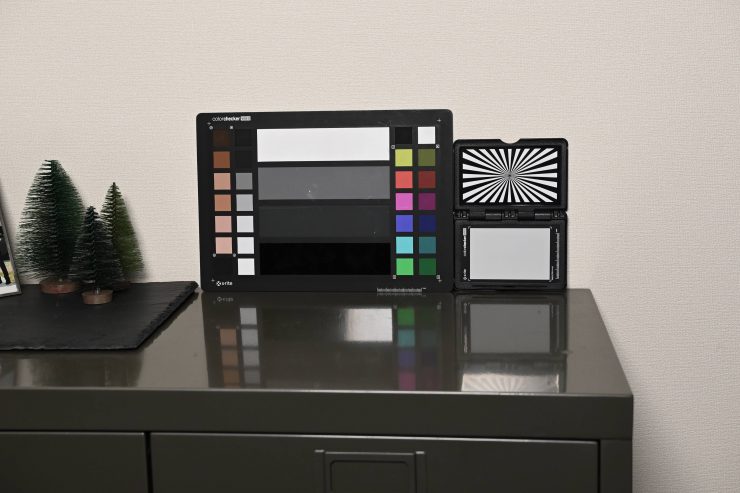
Rayzr MC400 MAX 
Rotolight Titan X2
As you can see, all of the lights correct up nicely once a WB is done. To my eye, the Rayzr has a slight magenta push, and the Litepanels Gemini and Rotolight Titan X2 are very close.
Skin Tones
Replicating good skin tones is an important factor you need to consider when using any light. Skin tones can look very different when different cameras/sensors are used. Lights can also look better with certain cameras/sensors as well, so doing head-to-head tests is difficult unless you are testing different camera and different light combinations.
For these tests, I have kept the exposure, ISO, and shutter speed the same. I used a 3200K and 5600K preset WB and then WB balanced the camera using an 18% grey card. Nothing has been altered or changed in post.
Again, I need to stress that skin tones can obviously be manipulated in post. This is simply to show how the various lights look on skin tones without any corrections being done.
So you may well ask, ‘Why bother doing this test then?’ This is still a good way of seeing the differences between all of the lights and how they vary.
Please don’t pay any attention to the exposure of the various lights. The same shutter speed, ISO and F stop were kept for all shots. All of the lights have different strengths of in-built diffusion and different beam angles.
No correction has been done in post. This is exactly as was shot. It is important to remember that all of these lights have +/- correction so they can all be fine-tuned to produce better results.
3200K (Preset WB)


Rotolight Titan X2 
Litepanels Gemini 
Rayzr MC400 MAX
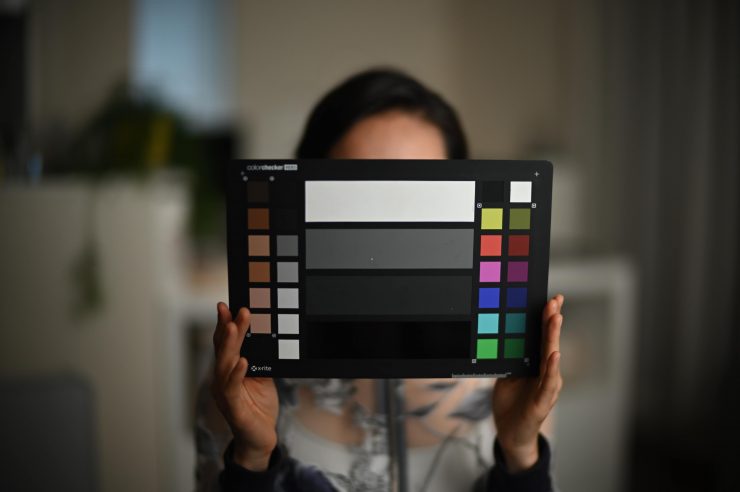

Rotolight Titan X2 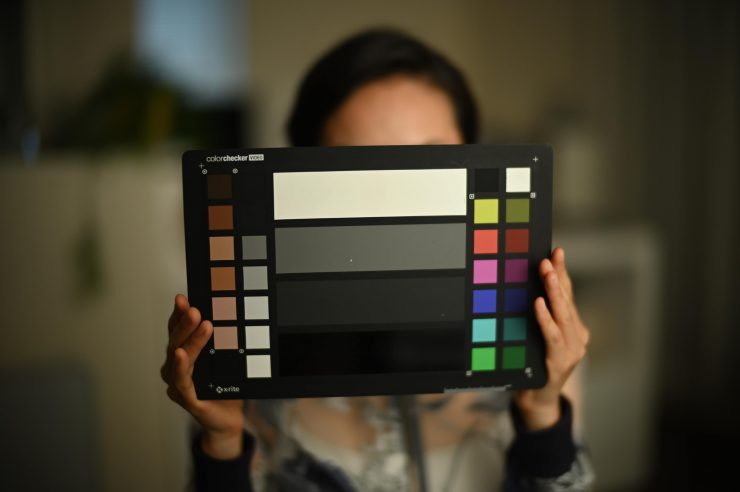
Litepanels Gemini 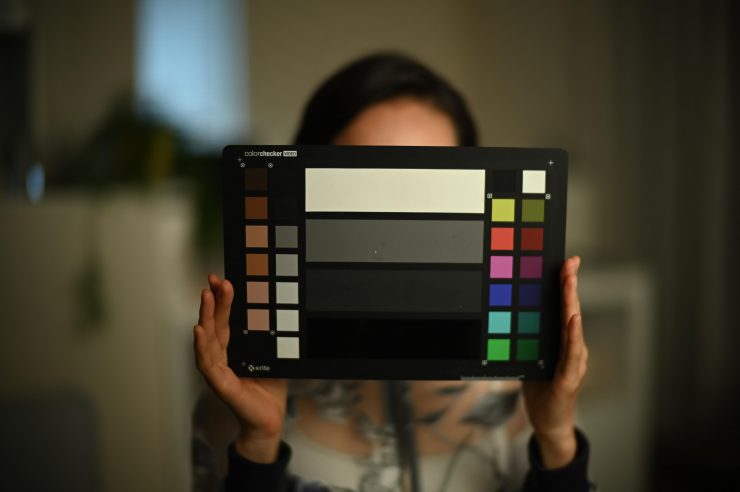
Rayzr MC400 MAX
At a preset 3200K WB you can see that both the Litepanels Gemini and Rayzr MC400 MAX have green casts, however, at least the Rayzr has a bit more warmth to the face. The Titan X2 is far more neutral when a preset WB is used.
3200K (WB done)


Rotolight Titan X2 
Litepanels Gemini 
Rayzr MC400 MAX
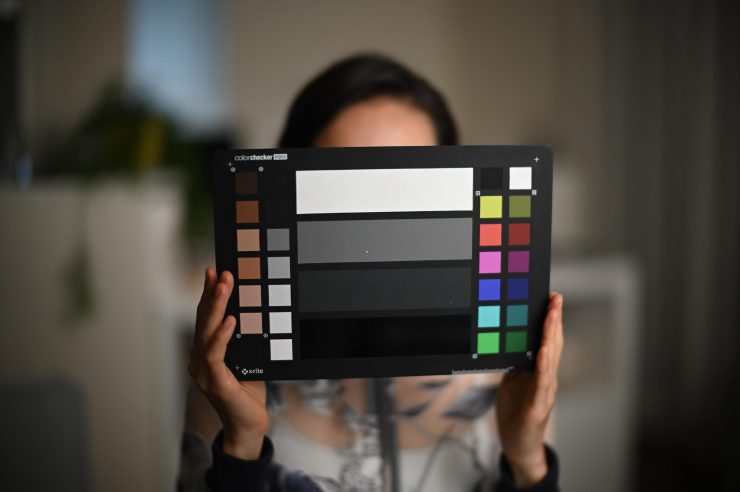

Rotolight Titan X2 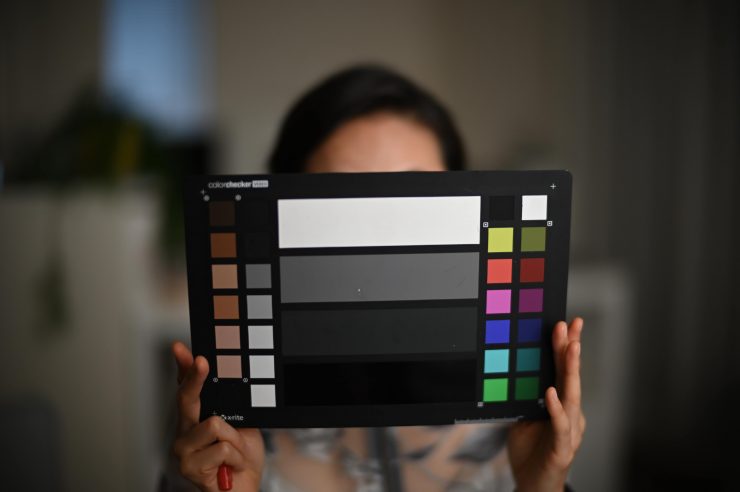
Litepanels Gemini 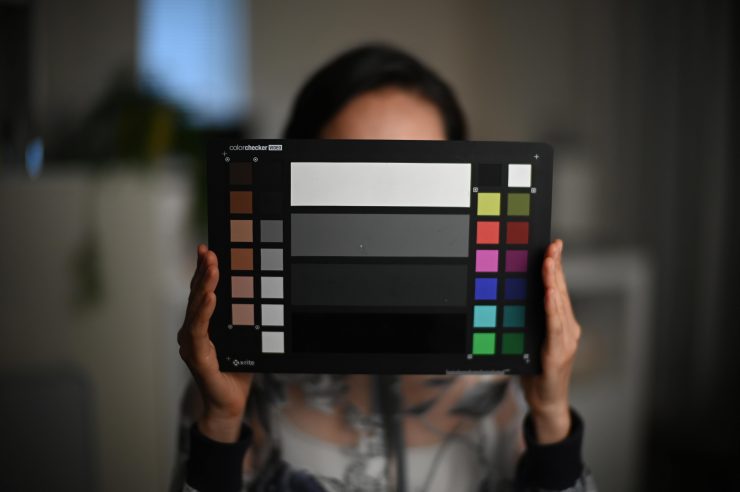
Rayzr MC400 MAX
When a WB is done, all three lights look pretty good. The Rayzr MC400 MAX definitely is slightly warmer than the other two lights and you can see that with the skin tone reproduction. The Rotolight almost looks almost identical after doing a WB as it did when a preset 3200K WB was used.
5600K (Preset WB)


Rotolight Titan X2 
Litepanels Gemini 
Rayzr MC400 MAX
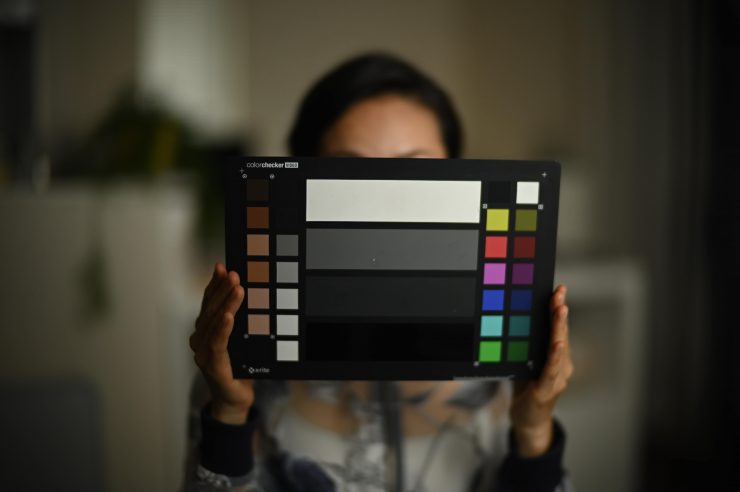

Rotolight Titan X2 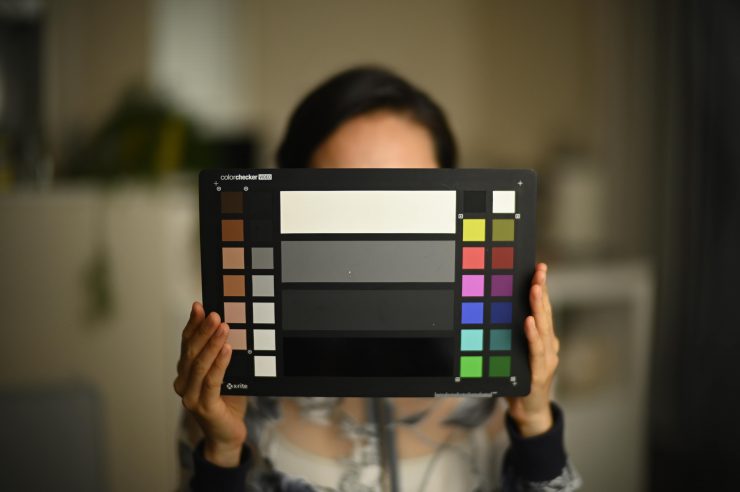
Litepanels Gemini 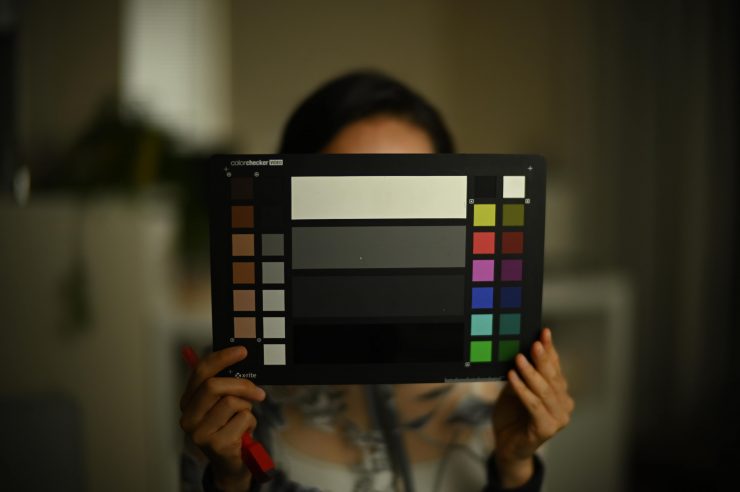
Rayzr MC400 MAX
At a preset 3200K WB you can see that both the Litepanels Gemini and Rayzr MC400 MAX have slight green casts, but it is more prevalent on the Rayzr. The Titan X2 is far more neutral when a preset WB is used.
5600K (WB done)


Rotolight Titan X2 
Litepanels Gemini 
Rayzr MC400 MAX
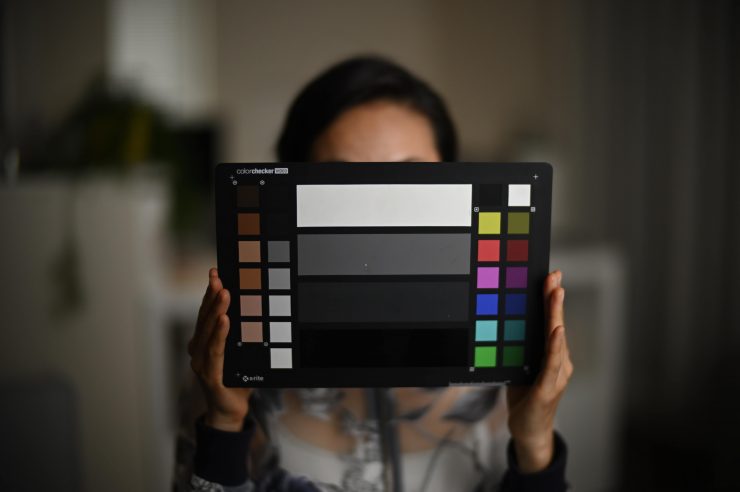

Rotolight Titan X2 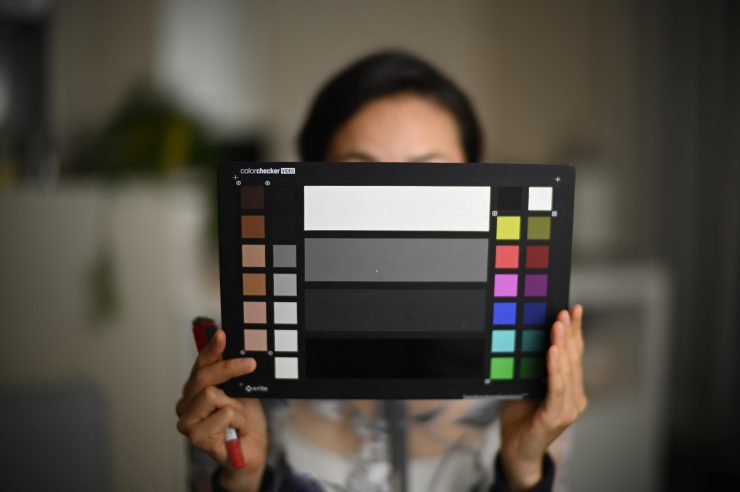
Litepanels Gemini 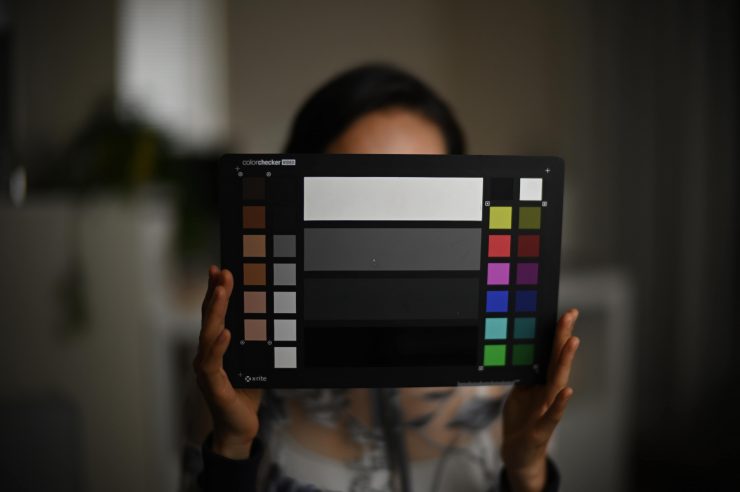
Rayzr MC400 MAX
When a WB is done, all three lights look pretty good. The Rayzr MC400 MAX definitely is slightly warmer than the other two lights and you can see that with the skin tone reproduction. All of the lights are pretty close after doing a WB.
Firmware Updatable
Like a lot of today’s lights, the Titan X2 is fully firmware upgradeable. Rotolight already released a firmware update in February and more updates are scheduled for this year. These include:
APRIL 2020
- High speed Sync Flash Mode with Elinchrom Trigger Support
- Additional DMX Modes including DMX Mode 2 (Titan 8 channel9, Mode 3 (Rotolight Legacy 8 channel), Mode 4 (Like ARRI S60-C), and Mode 5 (Like Litepanels Gemini)
- Lumenradio Wireless DMX (CRMX)
- Store/Recall Presets and banks to USB
Q2 2020
- Camera LUTs
- Remote Device Management (RDM) support
- X-FX- Exposure FX mode for stroboscopic multi layer photographic FX
- F stop dimming mode (FDIM)
- DMX Master mode & AIR SFX- the ability to control other DMX devices and broadcast settings (CCT, Brightness, SFX, etc.) via DMX cable or wirelessly to other Rotolight Titans.
- Additional language support
Who is the Titan X2 aimed at?
You could use the Titan X2 for lots of different applications, but the light is certainly being targeted as a high output, high-quality lighting fixture for professionals in the Tv and film industry. It is also a light that is sure to find its way into plenty of rental houses and studios.
Essentially the Titan X2 is being aimed at the same market that would consider a 2×1 sized ARRI SkyPanel, or a Litepanels Gemini. Rental houses are going to buy far more large 2×1 RGBWW lights, especially ones at this price, than owner/operators.
Whether the Titan X2 is likely to appeal to solo shooters and small crews is debatable. I personally think it could make for a good solution due to its output and feature set, but the caveats are certainly going to be power draw and weight. I personally wouldn’t air travel with a light this size, but it could be done.
In saying that, this is definitely a light I would use for a lot of work I do where I don’t have to fly anywhere. But, it would depend on the type of job I was doing.
What is great, and I mentioned this earlier, is you could save your own personal settings if you own or rent a Titan X2 and then just pick one up from a rental house when you travel. That way you could load up all of your personal settings and you are ready to go in an instant.
Accessories
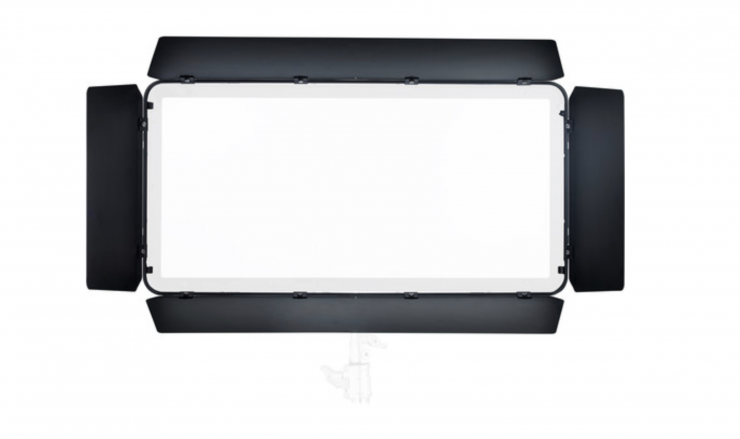
There are a bunch of accessories available for the Titan X2. These include:
- Rotolight DOP Choice SnapBag for Titan X2 LED Soft Light $499.99 USD
- Rotolight Barndoor Set for Titan X2 LED Soft Light $349.99 USD
- Rotolight Wheeled Fitted Flight Case for Titan X2 LED Soft Light $599.99 USD
- Rotolight DOP Choice SnapGrid for Titan X2 LED Soft Light $379.99 USD
Other Alternatives
As I have already mentioned numerous times throughout this review the main competition for the Titan X2 is the ARRI SkyPanel and the Litepanels Gemini 2×1, but here are some other lights that could also be compared:
- Litepanels Gemini 2×1
- ARRI SkyPanel S60-C
- LEDGO LG-G260
- Lupo Superpanel Soft Full Color 60
- Rayzr MC 400
- LEDGO LG-G260
- Luxli Taiko 2×1 RGBAW
- Kino Flo Celeb 450Q DMX
- Kino Flo FreeStyle 21
- Kino Flo Diva-lite 20
- Velvet EVO
The Titan X2 is very similar to the Litepanels Gemini 2×1 andARRI SkyPanel S60-C in a lot of ways, but it has better output and more features.
In reality, the Titan X2 should be much better than lights such as the ARRI SkyPanels and the Gemini 2×1 as both those fixtures have been around for quite some time. The SkyPanel was announced way back in 2015 and the Litepanels Gemini in 2017. The SkyPanel has been hugely popular because it is widely available, super robust, reliable
The Lupo Superpanel Soft Full Color 60, Luxli Taiko, and Rayzr MC 400 are more budget-friendly options, that will probably appeal to a different segment of the market.
The Kino Flo options, while offering similar functionality don’t have nearly the output of any of these other lights.
All of the competition have their strengths and weaknesses and what light will work best for you certainly comes down to a lot more factors that just specifications and features.
A rental house is much more likely to carry an ARRI, Kino Flo, Rotolight, or even a Litepanels Gemini over a Lupo, Ledgo, or a Rayzr. This is primarily to do with the build quality, after-sales service, and a long term track record of reliability.
Price & Availability
The Rotolight Titan X2 certainly isn’t cheap. Apart from the ARRI S60-C SkyPanel, it is substantially more expensive than all of the other offerings, except the Kino Flo Celeb 450Q DMX.
Below you can see how the price compares to the competition:
| Price | |
| Rotolight Titan X2 | $4,999 USD |
| ARRI SkyPanel S60-C | $6,550 USD |
| Litepanels Gemini 2×1 | $3,795 USD |
| Lupo Superpanel Soft Full Color 60 | $2,598 USD |
| Rayzr MC MAX 400 | $1,999 USD |
| Luxli Taiko 2×1 RGBAW | $1.699 USD |
| LEDGO LG-G260 | $2,565 USD |
| Kino Flo Celeb 450Q DMX | $4,585.75 USD |
| Kino Flo FreeStyle 21 | $1,525.75 USD |
| Kino Flo Diva-lite 20 DMX | $2,035.75 USD |
| Velvet EVO | $3,766 USD |
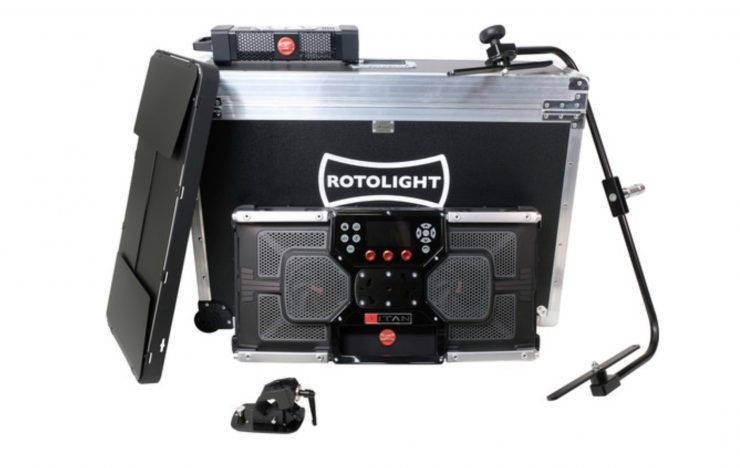
Rotolight also sells a Titan X2 Rental Kit for $5,920 USD.
The only slight concern some users may have in investing in a high-end light such as the Titan X2 is that the technology has accelerated rapidly over the last few years. Back in the day, you could buy an ARRI 650 and you knew you would be able to use it for decades. With modern day lights (and this goes for just about any of today’s technology) the lifespan of the product is not going to be as long. That is not to say your light will become obsolete in 3 years’ time, but there will be something better that is bound to come along.
In saying that, a lot of today’s lights are receiving new features via firmware updates. This is something that increases their flexibility and feature set. With the Rotolight there is already a firmware road map and I wouldn’t be surprised to see additional features being added over time. Rotolight is not a company that brings out new lights at an alarming rate, so it is fairly safe to assume that we won’t be seeing a Titan X2 replacement anytime soon.
Conclusion
The Titan X2 is a very impressive fixture. I think it is the best light that Rotolight has ever made. I would go as far as saying it is one of the most impressive lights I have ever reviewed (and I’ve reviewed a lot of lights!).
The light is well built, fully-featured, and produces a really nice quality of light. A ton of thought and innovation has gone into this fixture and it offers features other lights simply don’t have.
The color rendering scores are very good and the output is higher than its competition (but that does come at a narrower beam angle with less diffusion). Rotolight has paid so much attention to small details that you can see that this light was well thought out and designed.
The interface and operating system are the best I have seen and making changes to the light is straight forward and intuitive. Rotolight’s touchscreen interface is the gold standard for which all other lights should now be judged against.
The light is quite expensive, but it is being targeted at a certain user base. This is not a budget lighting solution that will appeal to everyone. If you have been looking at a Litepanels Gemini or an ARRI SkyPanel, the Titan X2 is a light you should also be seriously considering. While both the ARRI and Litepanels options are both very good lights, the Titan X2 is better in a lot of ways.
The Titan X2 ticks a lot of boxes, and in my opinion, it is currently the best high end 2×1 RGBWW light on the market.
Like what we do and want to support Newsshooter? Consider becoming a Patreon supporter and help us to continue being the best source of news and reviews for professional tools for the independent filmmaker.

